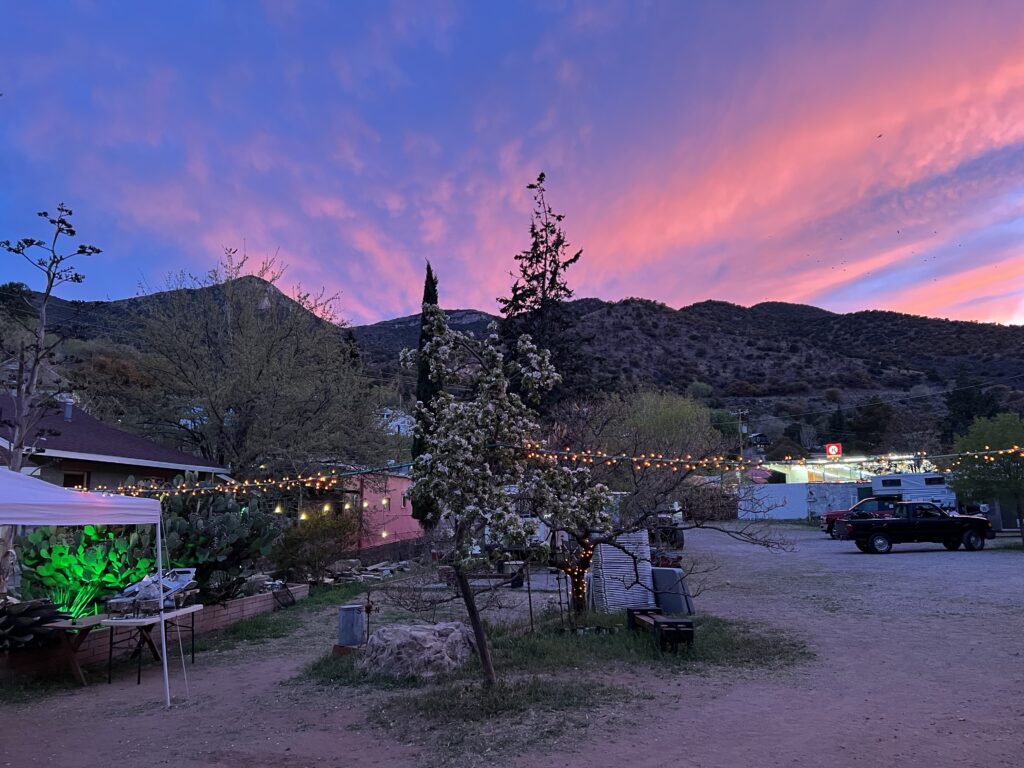Bisbee was considered one of the largest cities in the United States between St. Louis and San Francisco during its mining heyday in the early 1900s, with a population of over 20,0001.
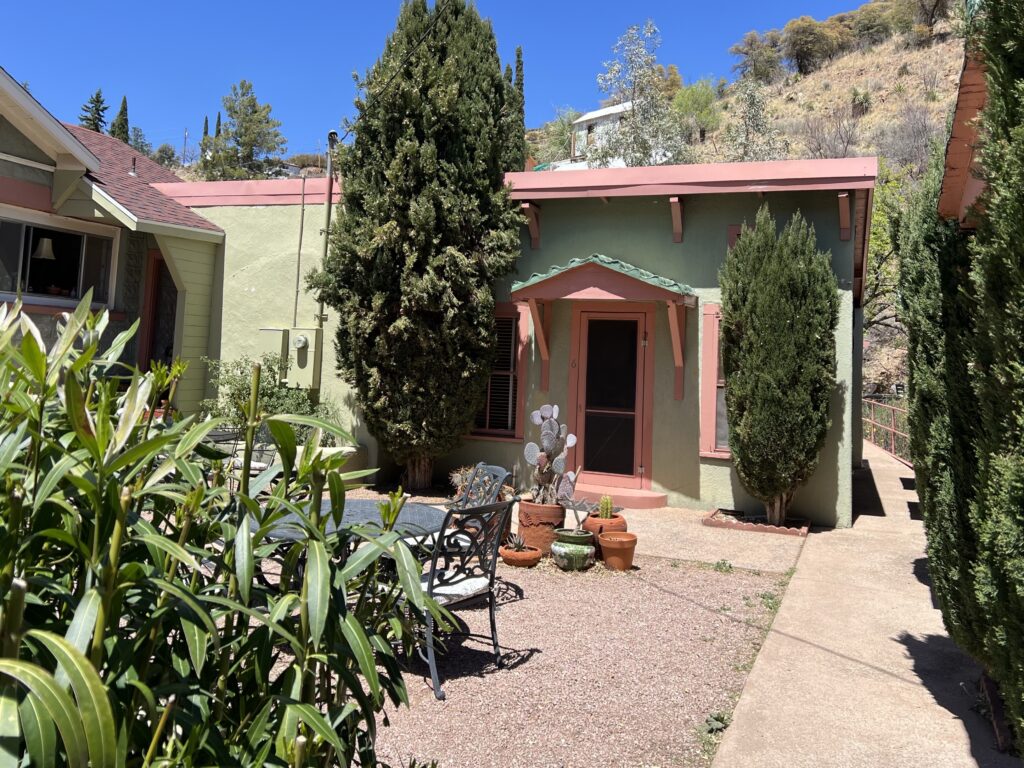
Here are the key details about the population and demographics of Bisbee, Arizona today:
- According to US Census data, Bisbee has a population of 4,957 residents2.
- The median age of Bisbee’s population is 56 years old2.
- The population is split almost evenly between males (50.31%) and females (49.69%)2.
- The vast majority (92.35%) of Bisbee’s population are US-born citizens2.
- Nextdoor Neighbors reports that there are 2,860 permanent residents in Bisbee3, while another source cites the population as 5,008 in 20224.
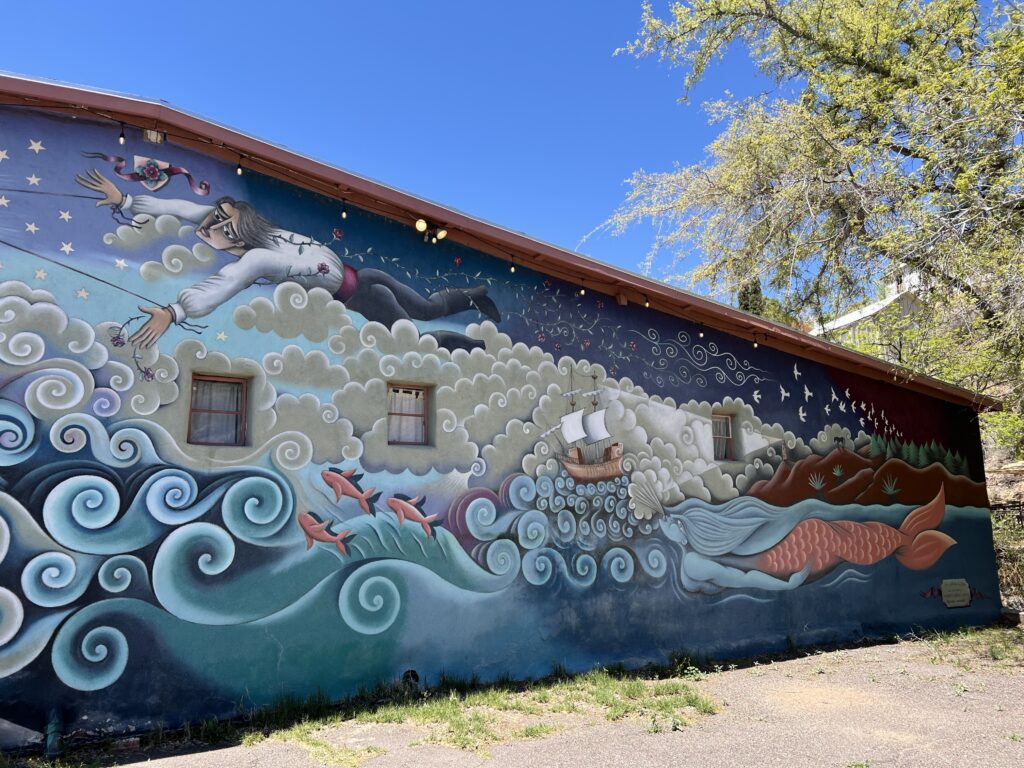
So in summary, Bisbee has a relatively small population, with a median age skewing older, and a demographic makeup that is predominantly US-born.
Based on the search results provided, here are the key details about the cost of living and housing in Bisbee, Arizona:Cost of Living:
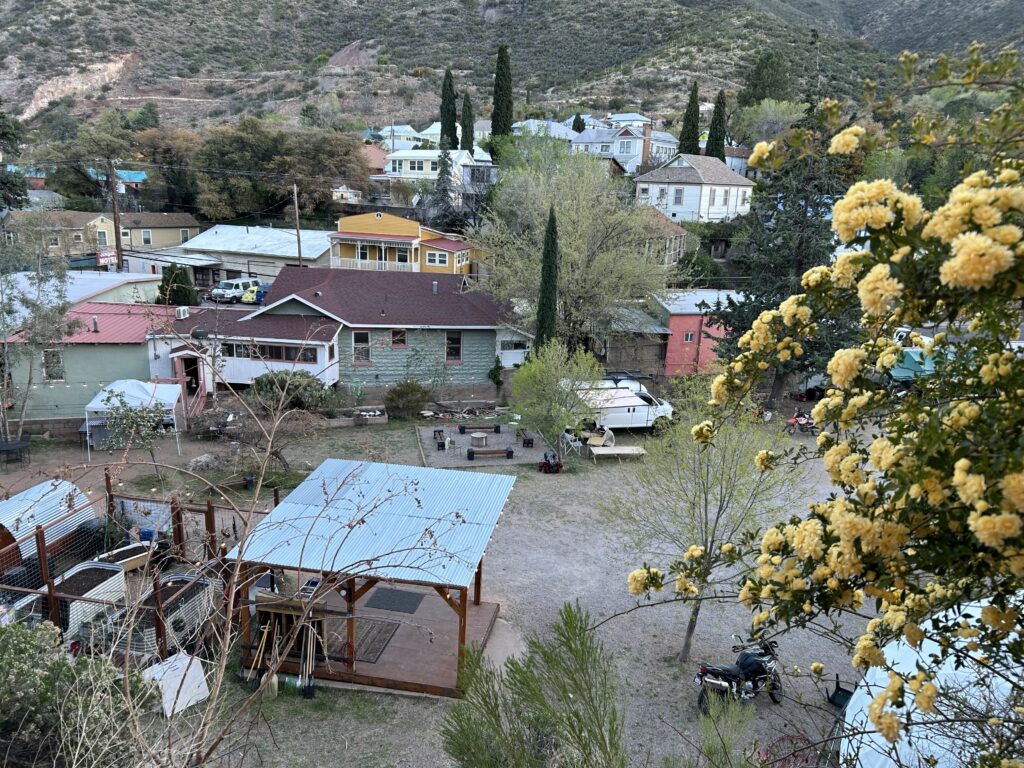
- The median household income in Bisbee is $41,771, which is lower than the national median1.
- The median home value in Bisbee is $176,824, which is lower than the national median of $281,9001.
- The median rent in Bisbee is $850 per month, which is 55% lower than the national average2.
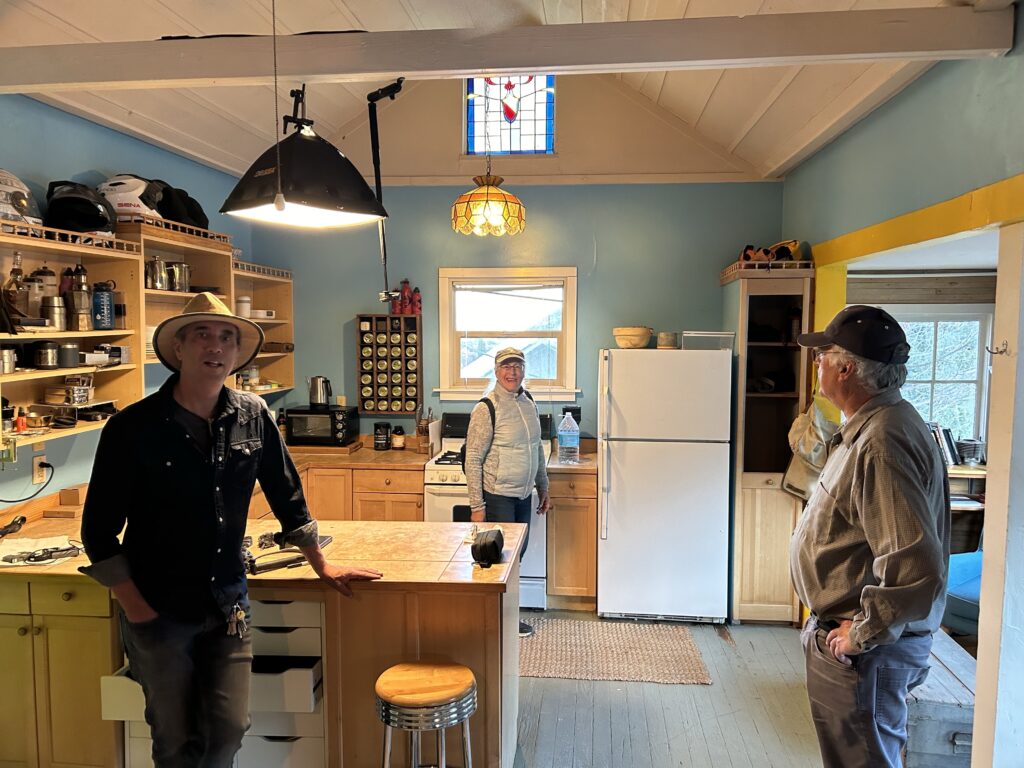
Housing Costs:
- Housing prices in Bisbee have been rapidly increasing, with the town struggling with a housing affordability crisis4.
- Many homes in Bisbee are being purchased as vacation homes or second homes, driving up prices and reducing the available housing stock for local residents4.
- Rental prices have also been rising, with some residents having to move farther out of town to find more affordable options4.
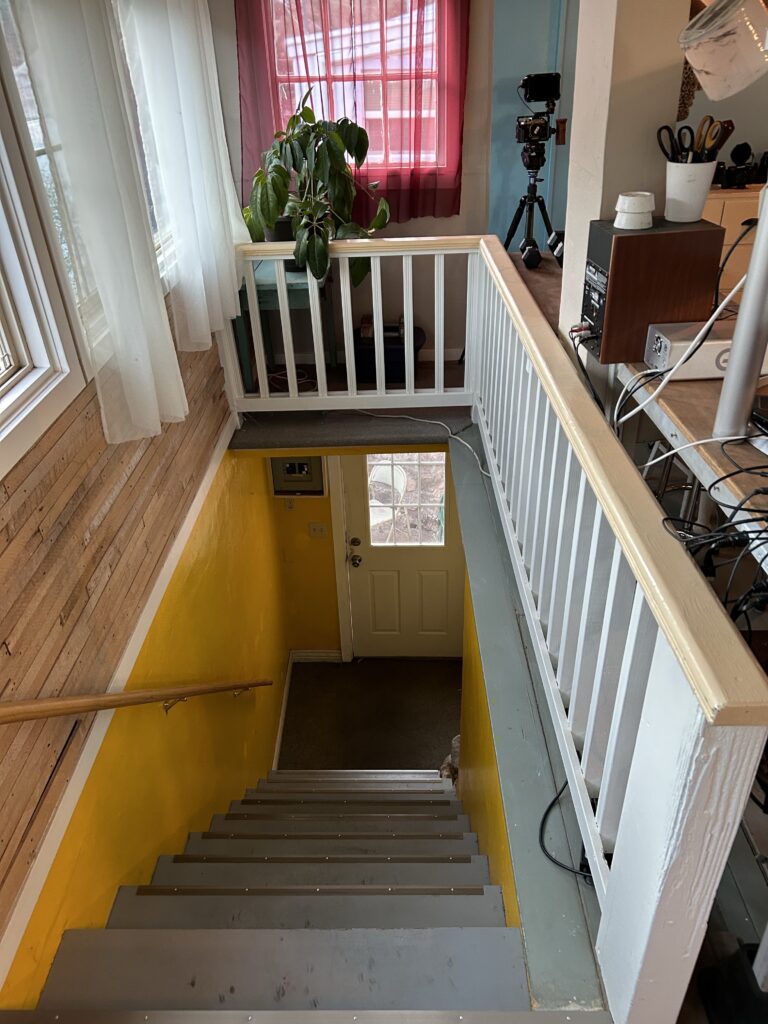
Hospitals:
- there is a hospital located in Bisbee.
- In summary, Bisbee has a lower cost of living compared to national averages, with median home values and rents being significantly below the national medians. However, the town is facing a housing affordability crisis as home and rental prices have been rapidly increasing. The search results do not indicate whether there is a hospital located within Bisbee.
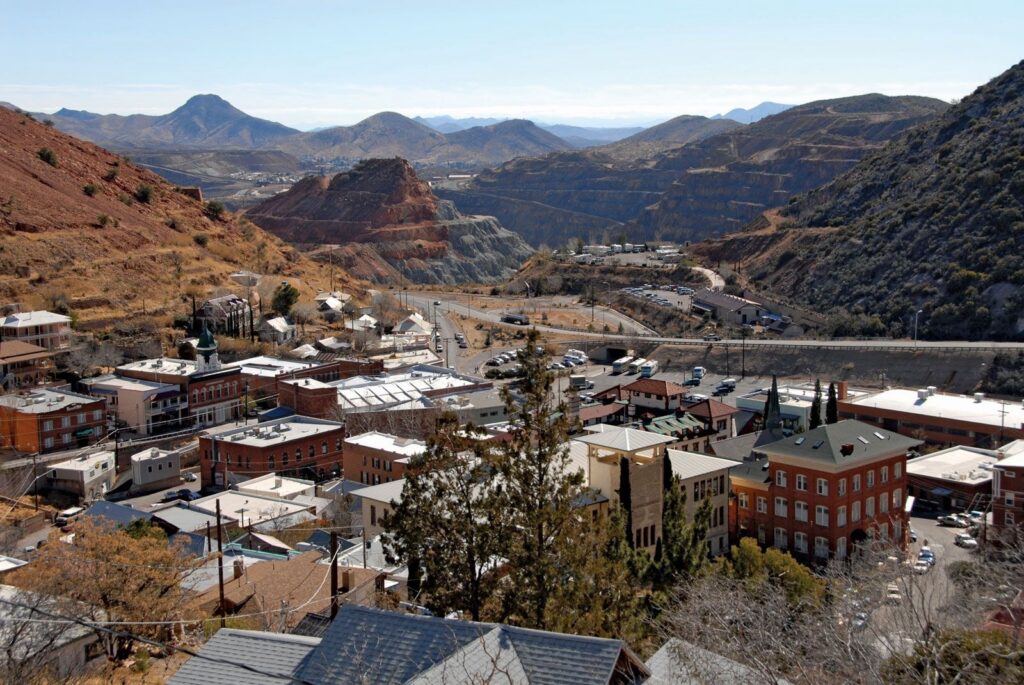
Based on the search results provided, here is a summary of what Bisbee, Arizona has to offer for different types of visitors:
For historians
- The Bisbee Mining & Historical Museum, which tells the story of Bisbee’s copper mining history.
- The Lavender Pit, a former open-pit copper mine that is a testament to the town’s mining past.
- The Old Bisbee Ghost Tour, which provides historical insights about Bisbee’s past.
- The Copper Queen Hotel, the oldest continuously operating hotel in Arizona.
- The historic architecture and buildings in Bisbee’s Historic District.
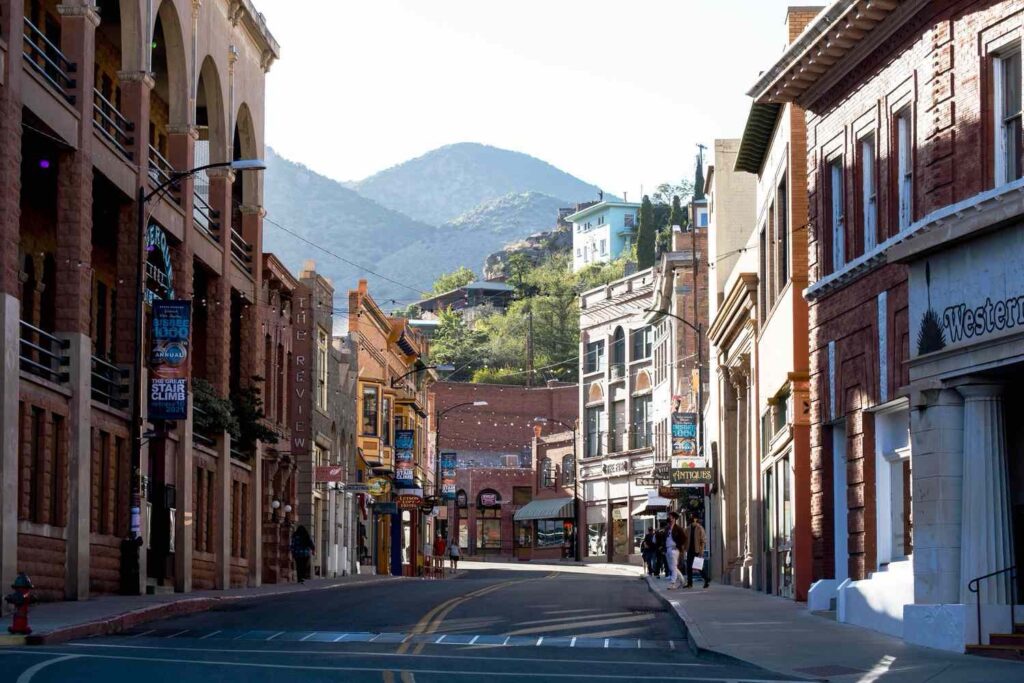
Based on the search results provided, some of the key historical landmarks and sites of interest in Bisbee, Arizona include:
- The Bisbee Mining & Historical Museum – Located in the former Phelps Dodge Headquarters building, this museum tells the story of Bisbee’s copper mining history.
- The Lavender Pit – A former open-pit copper, gold, and silver mine operated by the Phelps Dodge Corporation.
- The Copper Queen Post Office – The original location of a corner grocery store, now housing both the post office and Copper Queen Library.
- The Copper Queen Hotel – The oldest continuously operating hotel in Arizona, with past guests including President Teddy Roosevelt and actor John Wayne.
- The Warren Ballpark – Home to the historic concrete grandstand, dugouts, locker rooms, and manager’s office.
- The Pythian Castle – A historic building constructed in 1904 by the Knights of Pythias fraternal organization.
- The Stock Exchange Building – Built in 1905, this was the location of Bisbee’s historic stock exchange.
- The Tombstone Canyon Inn and Inn at Castle Rock – Two historic inns dating back to the late 19th century.
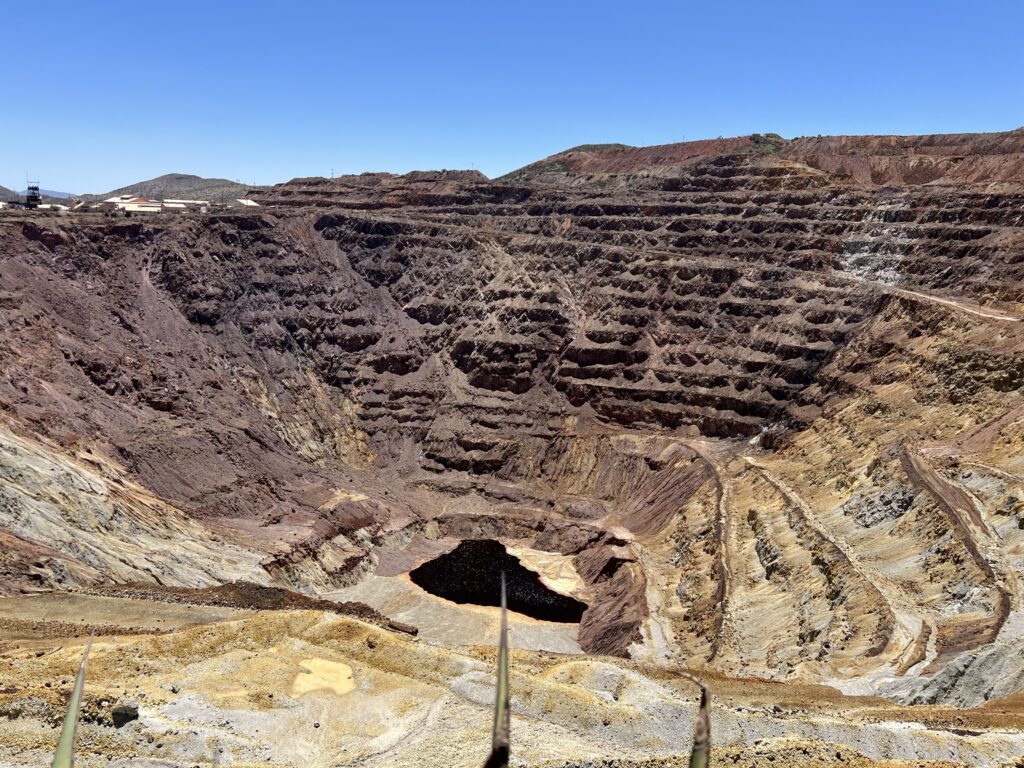
The search results highlight Bisbee’s rich mining and architectural history, with numerous well-preserved historic landmarks and buildings throughout the town.
For Engineers:
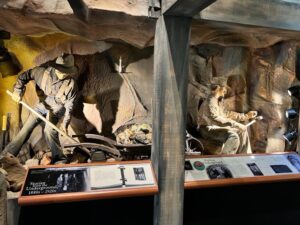
- The Lavender Pit, which showcases the engineering aspects of mining operations.
- The Amerind Foundation in nearby Dragoon, which focuses on archaeology and Native cultures.
For Birders
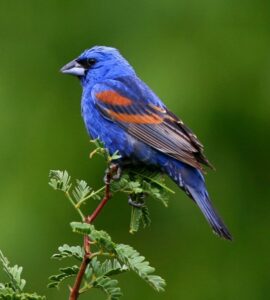
San Pedro Riparian National Conservation Area is located near Bisbee, Arizona. The key details from the search results:
- The San Pedro Riparian National Conservation Area encompasses 50 miles of the San Pedro River, which is located in Cochise County, Arizona, between the international border and St. David1.
- The conservation area is accessed by 6 paved road entry points and contains nearly 57,000 acres of public land managed by the Bureau of Land Management1.
- The San Pedro River runs through the Chihuahuan Desert and Sonoran Desert in southeastern Arizona, near the town of Bisbee13.
- The article “Bisbee explores projects to help keep San Pedro flowing” directly states that the San Pedro River is critical to Cochise County’s economy, where Bisbee is located4.
So in summary, yes the San Pedro Riparian National Conservation Area, which is a major ecological and recreational resource, is located in close proximity to the town of Bisbee, Arizona.
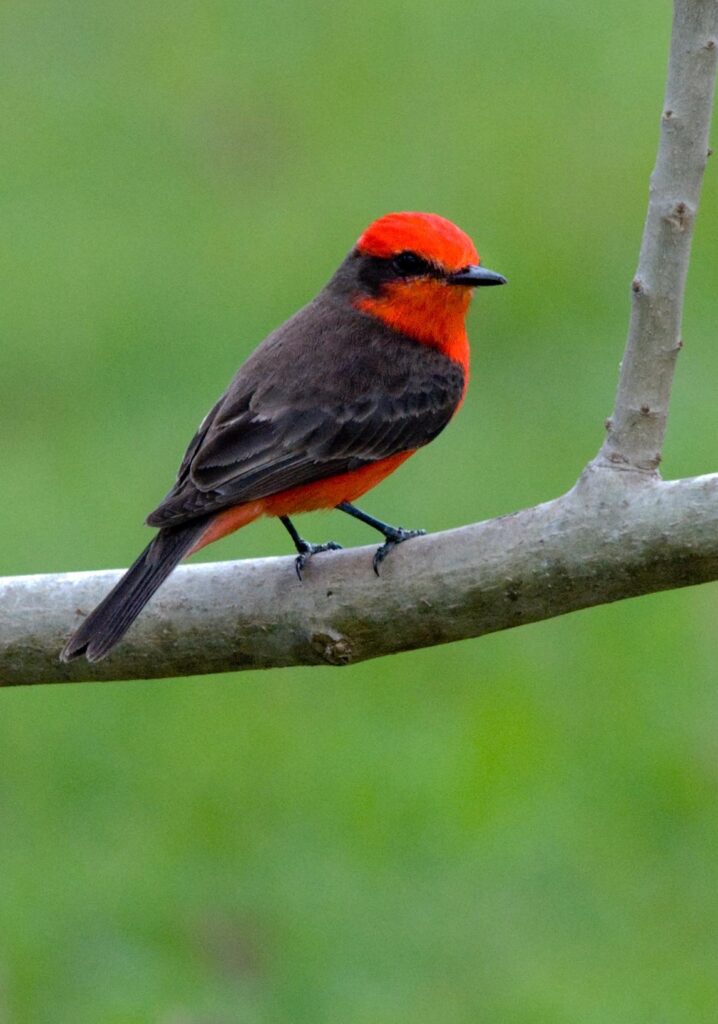
According to the search results, the best time of year to visit the San Pedro Riparian National Conservation Area is during the spring migration season, which is typically March-April.The key evidence from the search results:
- A Tripadvisor user states that “If you’re looking for a variety of birds, I would go during migration season which is March-April. It’s probably lovely there in January, but I would expect fewer birds.”3
- The weather information indicates that the San Pedro Riparian area has good conditions for being active outside during this time of year.4
- While the area is open year-round, the Tripadvisor review suggests that March-April is the optimal time for birding and seeing a wider variety of bird species in the conservation area.23
So in summary, the search results indicate that the spring migration season, particularly March-April, is considered the best time to visit the San Pedro Riparian National Conservation Area to see the most diverse array of bird life.
- The Texas Canyon Nature Preserve, with over 8 miles of trails for birdwatching.
- The Wildlife Garden in Vista Park, certified as a Community Wildlife Habitat.
- The annual “Return of the Turkey Vultures” celebration in Bisbee.
According to the search results, some of the popular and notable bird species to see in the San Pedro Riparian National Conservation Area include:
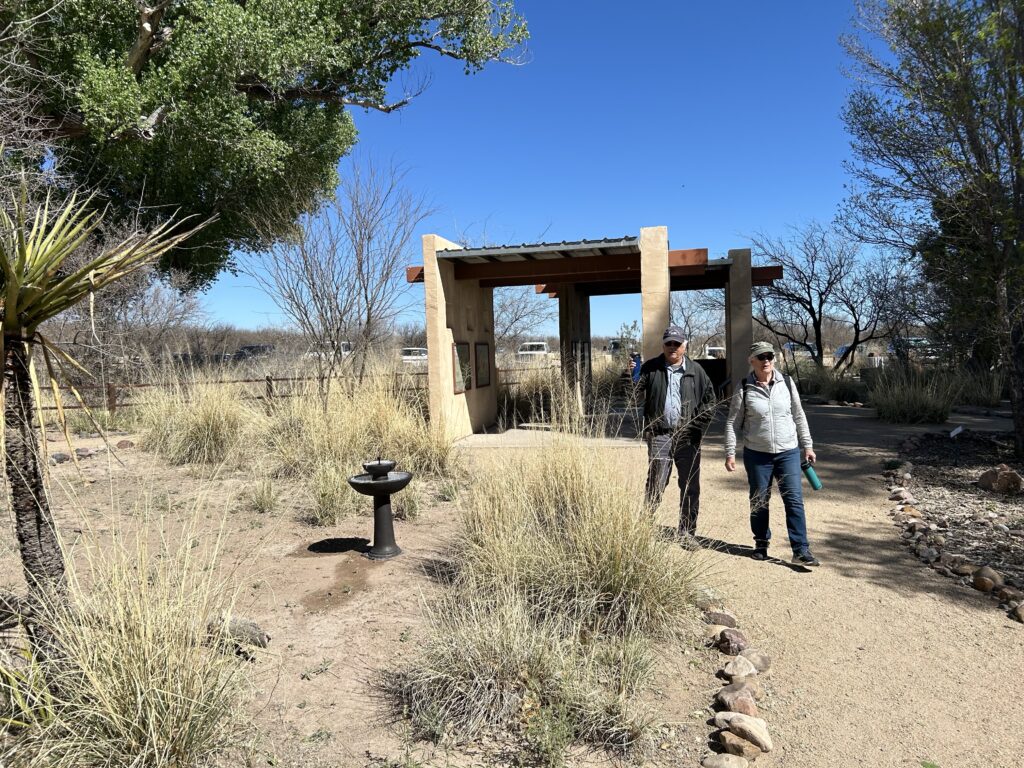
- Raptors:
- Mississippi Kite (a breeding species in the area)
- Gray Hawk (the area supports the largest breeding population in the U.S.)
- Aplomado Falcon (historically found in the area)
- Cactus Ferruginous Pygmy-Owl (historically found in the area)
- Northern Harrier, Red-tailed Hawk, Cooper’s Hawk, Sharp-shinned Hawk, Kestrel
- Warblers:
- Yellow Warbler (the area supports the largest population in the U.S.)
- Lucy’s Warbler (nests in the mesquite bosque habitat)
- Olive-sided Flycatcher, Wilson’s Warbler, MacGillivray’s Warbler (migrants)
- Other Notable Species:
- Yellow-billed Cuckoo (the area supports the largest population in the U.S.)
- Botteri’s Sparrow and Cassin’s Sparrow (nest in the adjacent bunchgrass habitat)
- Abert’s Towhee, Elf Owl, Gilded Flicker, Northern Beardless-Tyrannulet, Tropical Kingbird, Crissal Thrasher, Varied Bunting
- Belted Kingfisher and Red-naped Sapsucker (regular winter visitors)
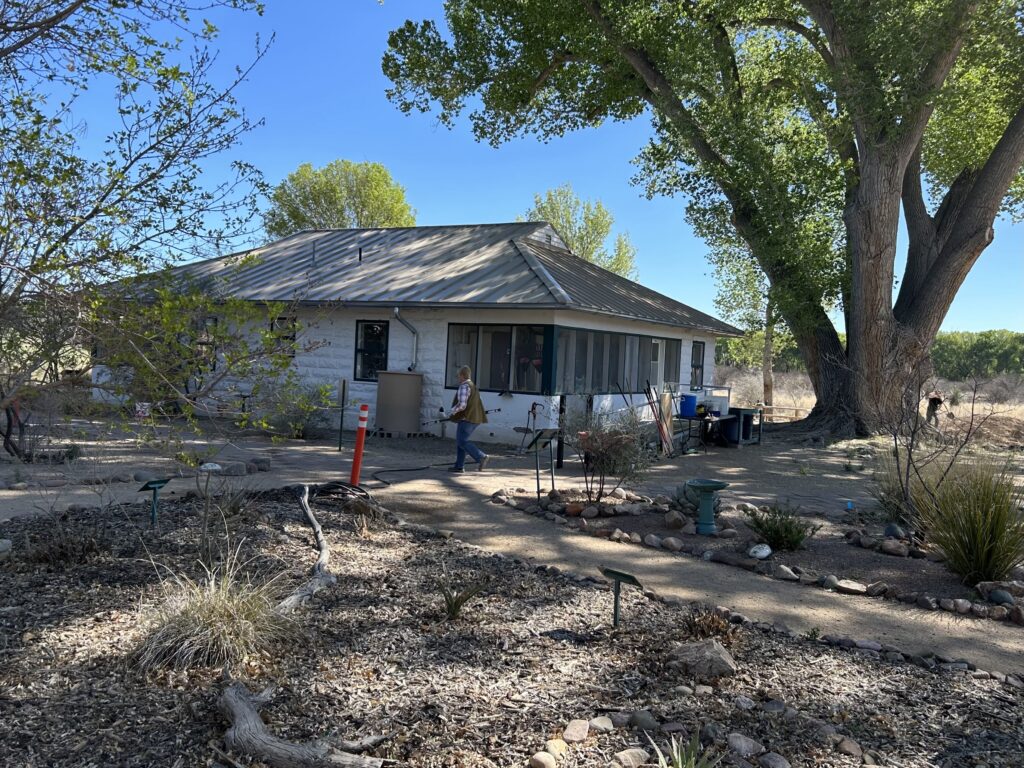
The San Pedro Riparian area is considered one of the most important bird migration corridors in the southwestern United States, supporting over 350 bird species throughout the year.
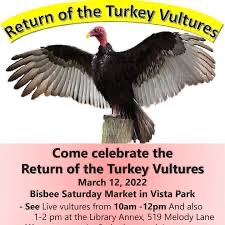
Turkey vultures visit and return to Bisbee, Arizona on an annual basis.
- There are multiple articles and sources that specifically mention the “Return of the Turkey Vultures” as an annual celebration and event in Bisbee, held every second weekend in March1234.
- The articles state that this event celebrates and welcomes the return of the migrating turkey vultures to the Bisbee area1234.
- One article is titled “Celebrating the Return of the Turkey Vultures in Bisbee”1, further confirming that turkey vultures do visit and return to Bisbee.
- The sources indicate this is an established annual tradition and event in Bisbee, suggesting the town has a consistent population of turkey vultures that migrate to the area4.

So in summary, the search results clearly show that turkey vultures do visit and return to Bisbee, Arizona on a regular, annual basis, with the town even hosting a celebration to welcome their arrival each spring.
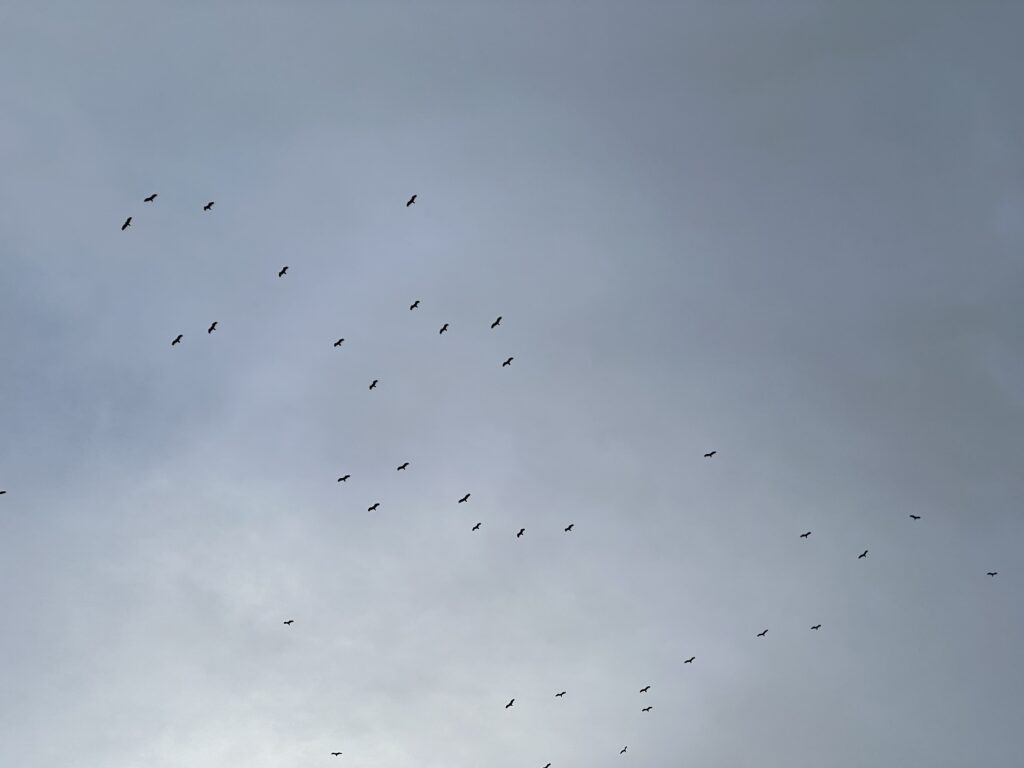
For Artists:
- The SAM•POE Gallery, featuring the work of local artists.
- The Pritchard Gallery in the Copper Queen Library, showcasing rotating art exhibits.
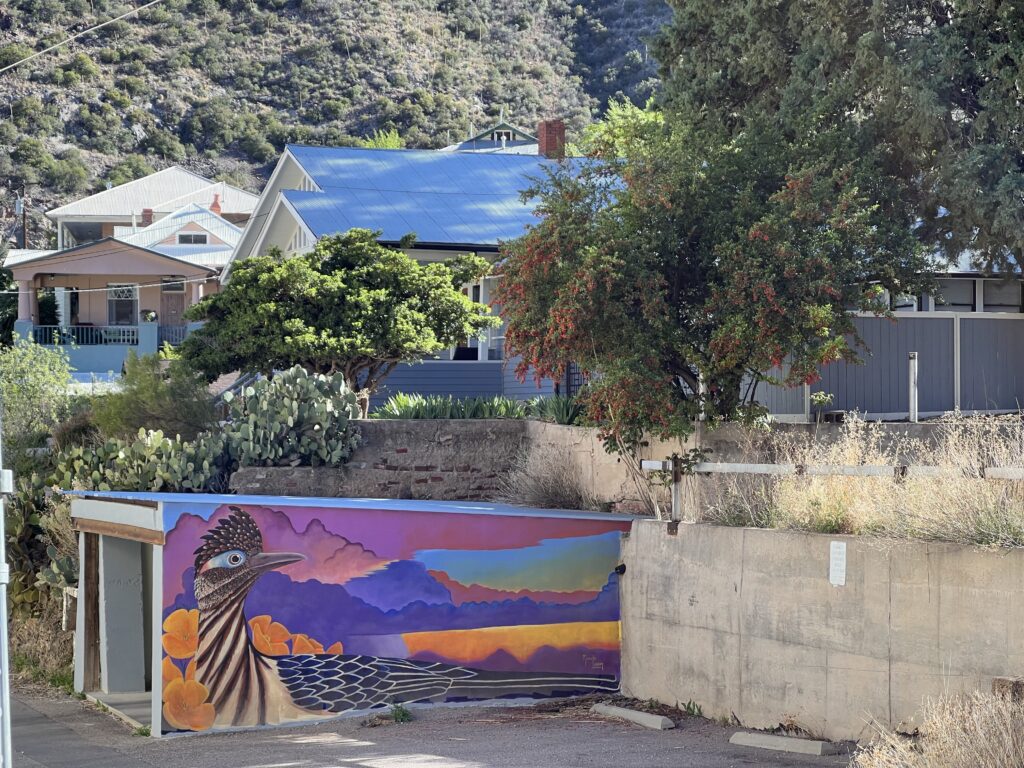
For Botanists:
- The diverse flora and vegetation in the nearby Chiricahua National Monument.
- The San Pedro Riparian National Conservation Area, with its rich riparian ecosystem.
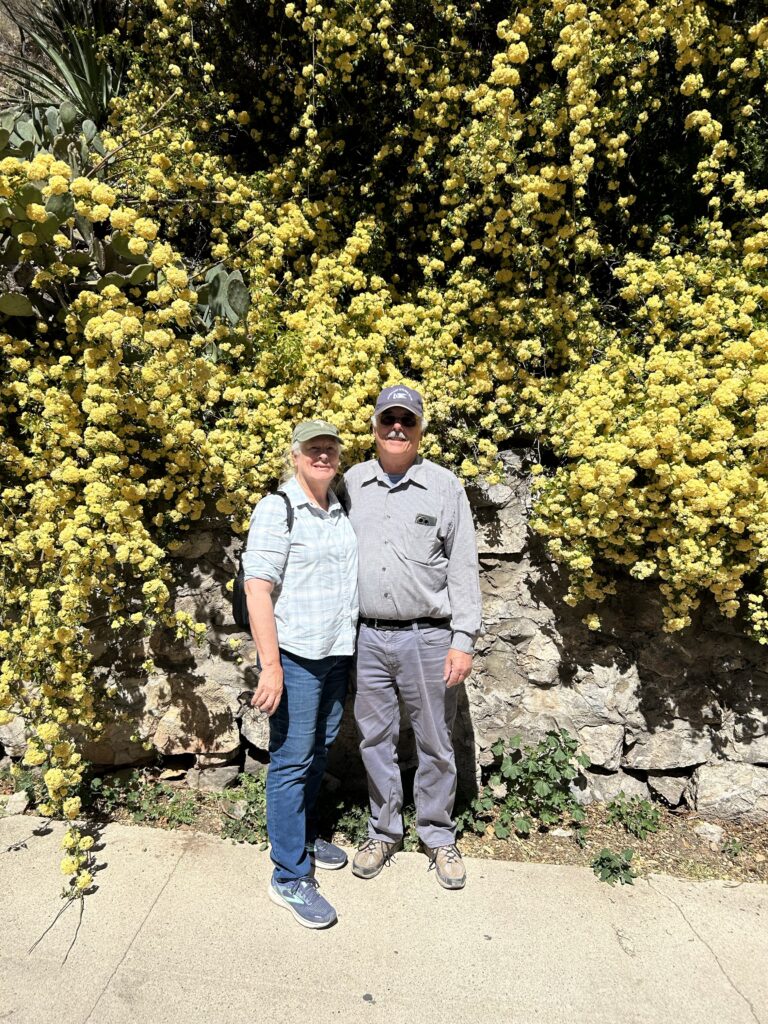
For Motorcycle Enthusiasts:
- The annual “Bisbee Prowl” chopper show and gathering.
- Scenic mountain roads and landscapes that attract adventure riders.
Based on the search results provided:
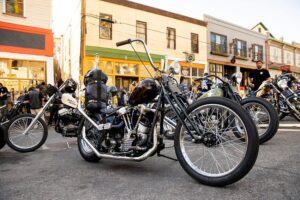
- Lowell is part of Bisbee, Arizona. The search results state that the original Bisbee Breakfast Club location opened in the Lowell district, just southeast of Old Bisbee4.
- Bisbee has a connection to motorcycles in the following ways:
- Bisbee hosts a major motorcycle event called the “Bisbee Prowel” which is a chopper show and gathering that typically draws entrants from around the country2.
- Bisbee is a popular destination for motorcycle enthusiasts and adventure riders. The search results mention a group of ADV (adventure) riders who met in Phoenix and rode to Bisbee to spend a couple of days riding in the surrounding areas1.
- Bisbee’s scenic mountain roads and landscapes make it an attractive destination for motorcycle riders and enthusiasts3.
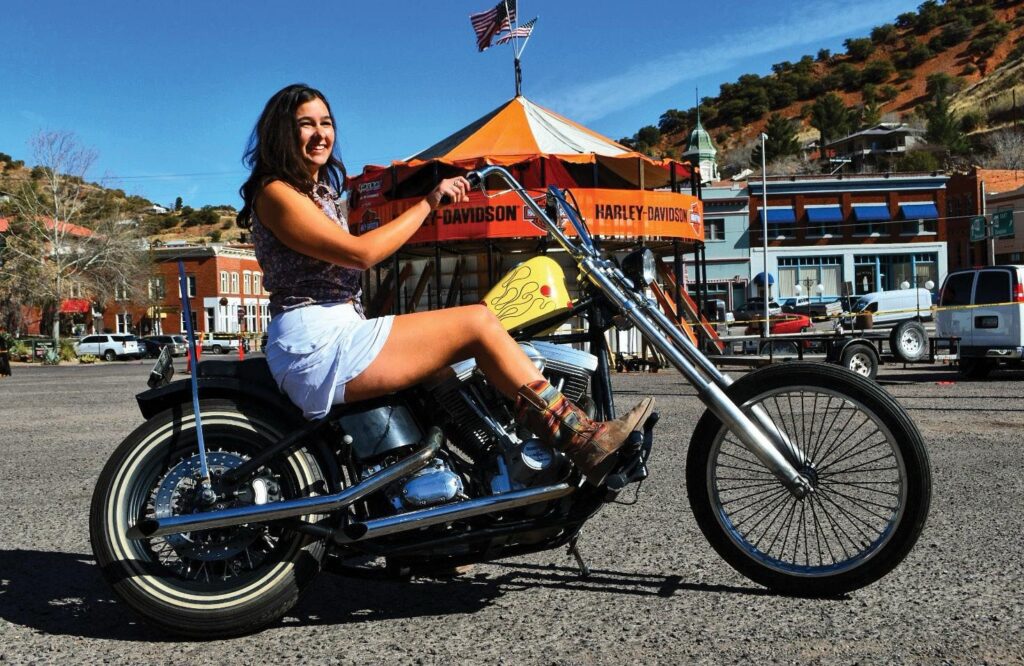
So in summary, Lowell is part of the town of Bisbee, and Bisbee has established itself as a hub for motorcycle events, gatherings, and riding experiences for enthusiasts.
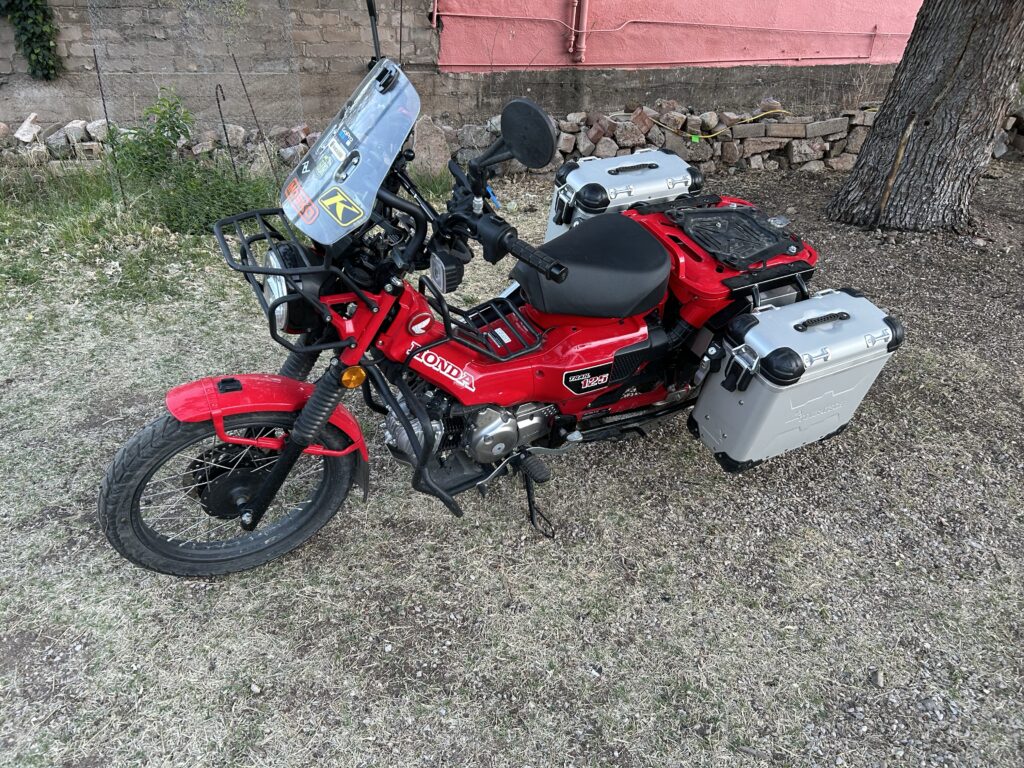
For Musicians:
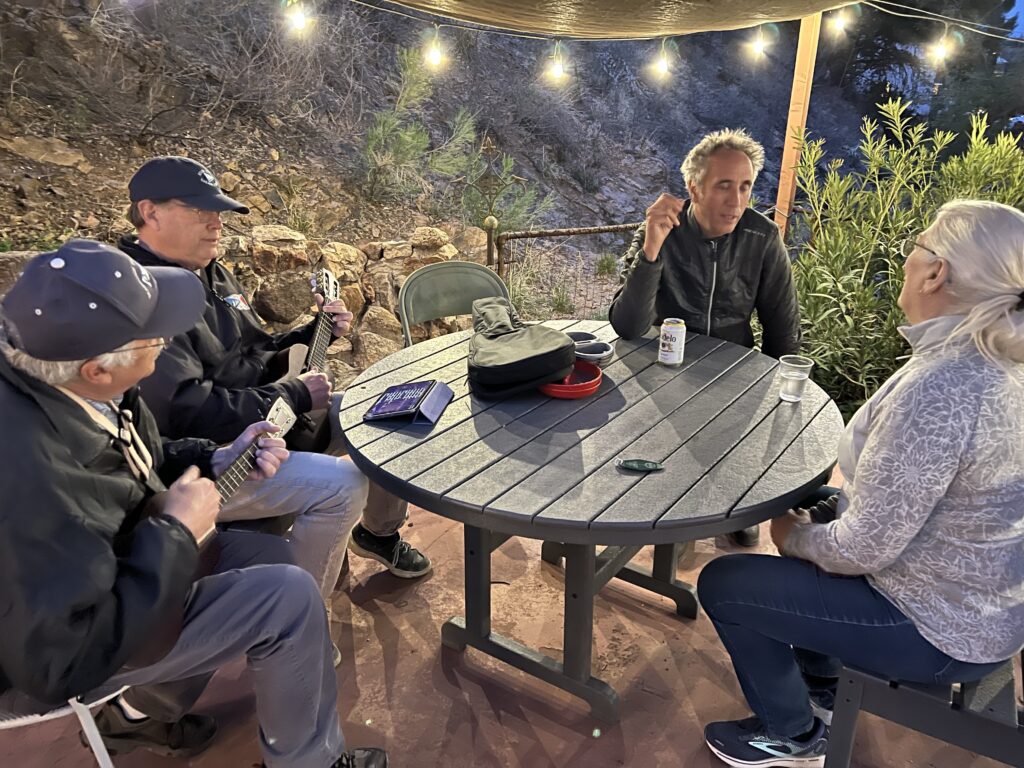
- The vibrant local music scene, with events like the Sidepony Express Music Festival.
- Opportunities to collaborate with other artists, as seen with local brewer/musician Sam Panther.
- Bisbee has a vibrant and active music community, with local musicians regularly playing gigs and events13.
- Brewers like Sam Panther are also musicians, blending their passions for music and brewing3.
- Bisbee hosts various music-related events, such as the karaoke nights at Electric Brewing2.
- Musicians in Bisbee have opportunities to collaborate with other local artists, as seen with Sam Panther’s work with Melissa Reaves and Philip Bynoe3.
- The Sidepony Express Music Festival – This annual music festival happens in Bisbee, featuring a wide range of musical acts9.
- Blues in Bisbee – A blues music festival that takes place in Bisbee, typically held in September each year10.
- Music at Twilight – A recurring live music event series in Bisbee that features various musical performances7.
- Open Mic events – Bisbee hosts regular open mic nights where local musicians can perform7.
- Concerts and live shows – Bisbee venues like Punchy’s Tavern host concerts and live music performances by touring and local artists8.
- The town’s historic Brewery Gulch area provides venues and spaces for musicians to perform, such as the Howl, Chirp, Squeak, & Roar event4.
For Architects:
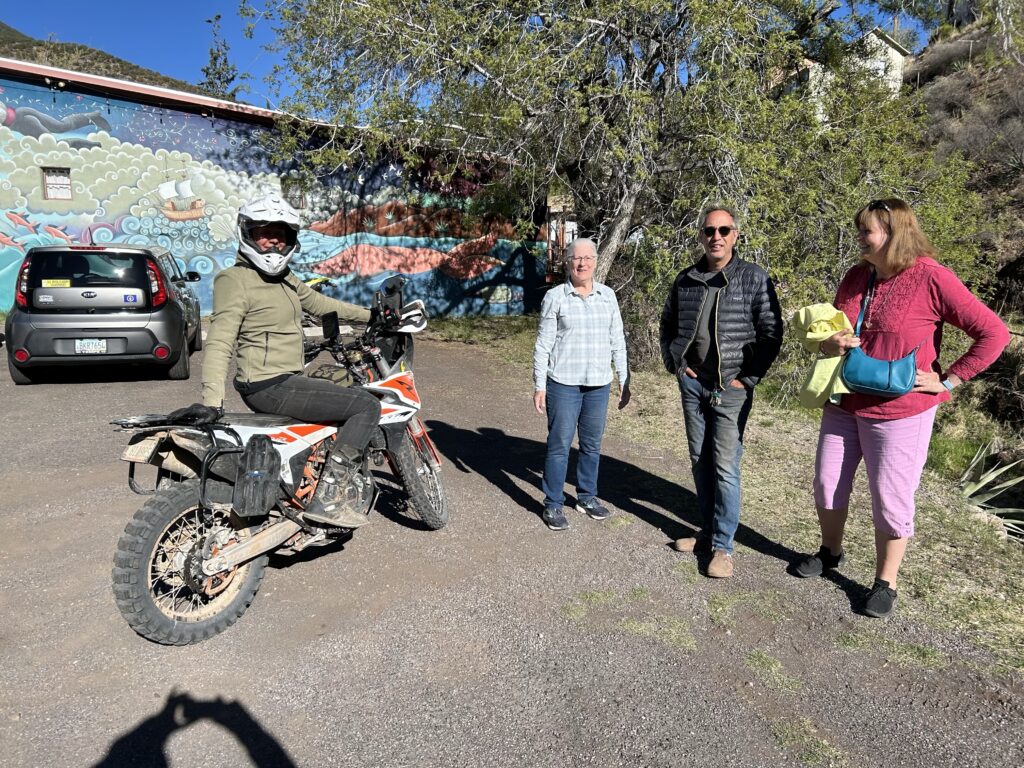
- The preserved historic architecture in Bisbee’s Historic District, including Italianate, Neo-Classical, and Carpenter Gothic styles.
- The Bisbee Historic District is a great place to explore these architectural styles, as it has been listed on the National Register of Historic Places.
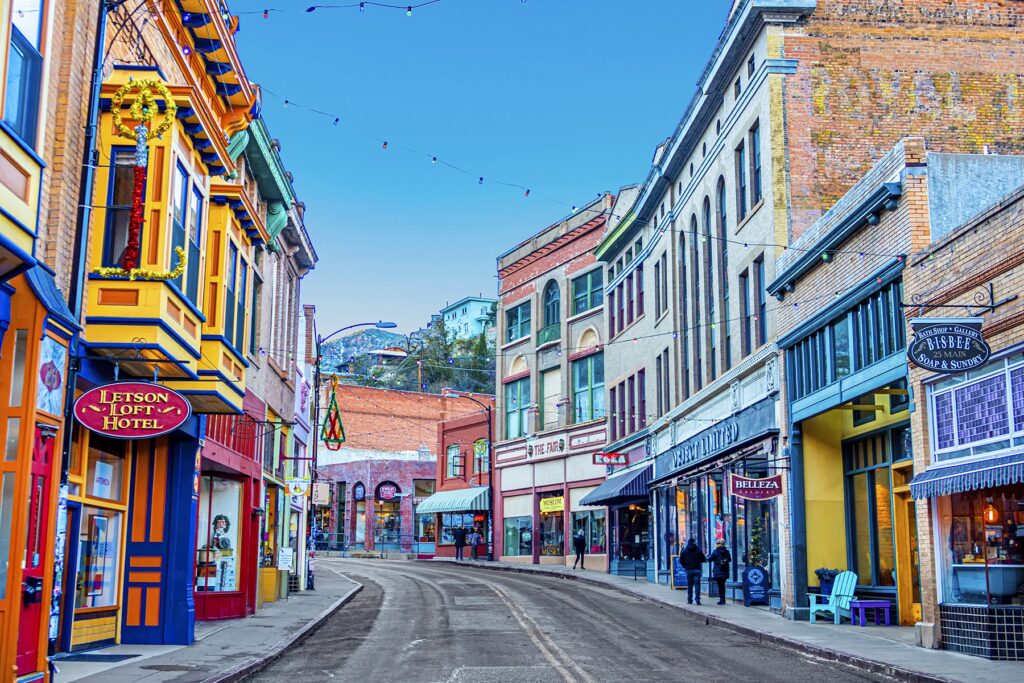
Bisbee, Arizona, is known for its architectural diversity and historic landmarks. Old Bisbee, is the historic center of town. It is the heart of Bisbee and its tourism. Old Bisbee is home to the miners’ houses, Brewery Gulch, the Copper Queen Hotel, and the Mining and Historical Museum. The very walkable Main Street turns into Tombstone Canyon as you head uphill, offering vistas of hills flowing with seemingly precarious miners’ houses (most of which have been renovated). Old Bisbee is where most tourists flock to avail themselves of the town’s rich history and cultural attractions. Some notable architectural landmarks in Old Bisbee include:
- Phelps Dodge Headquarters Building: Built in 1896, this building was the headquarters of the Phelps Dodge Mining Co. and now houses the Bisbee Mining & Historical Museum4.
- Copper Queen Library and Post Office: This building, constructed through projects funded by the Phelps Dodge Corporation, is a popular tourist attraction and showcases the town’s architectural diversity3.
- Old City Hall (originally the Bisbee City Fire Hall): Built in 1902, this building was originally the Bisbee City Fire Hall and is now located at 110-112 Naco Road4.
- Copper Queen Hotel: Established in 1902, this hotel is the oldest continuously operating hotel in Arizona and has hosted notable guests such as President Teddy Roosevelt and actor John Wayne4.
- Pythian Castle: Built in 1904, this castle-like structure is located at 29 OK Street and is a popular attraction for visitors4.
- Stock Exchange Building: Constructed in 1905, this building is located at 15 Brewery Ave. and is a notable architectural landmark in Bisbee4.
- Bisbee Grand Hotel: Built in 1906, this hotel is located at 61 Main Street and is another historic landmark in Bisbee4.
- Old Bisbee High School: Established in 1914, this school is located at 104 Clawson Ave. and is a significant architectural landmark in the town4.
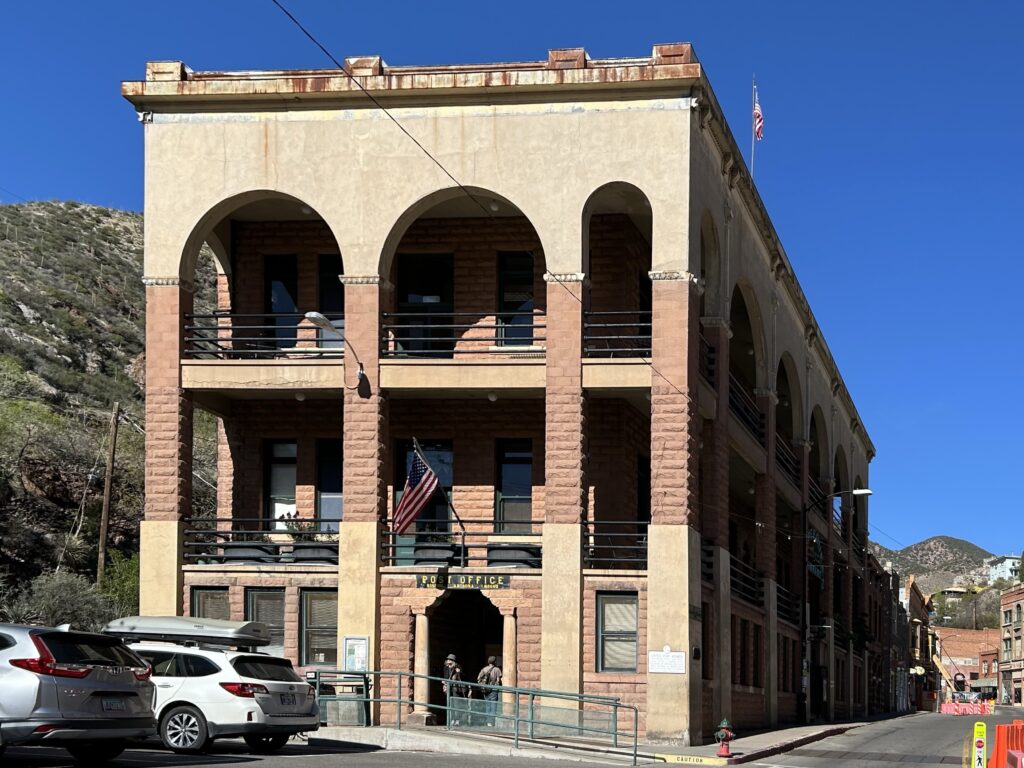
These are just a few examples of the architectural gems that Bisbee has to offer. The town’s unique blend of architectural styles, including Italianate, Neo-Classical, Baroque Revival, and Carpenter Gothic, makes it a must-visit destination for anyone interested in architecture and history1.
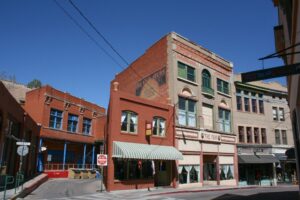
Some lesser-known architectural landmarks in Bisbee, Arizona, include:
- The Bisbee Mini Museum of the Bizarre: This unique museum is filled with oddities like shrunken heads, strange artifacts, and even items claimed to be cursed1.
- Evergreen Cemetery: While not typically considered a tourist attraction, Evergreen Cemetery has an aura of historical significance and is home to many pioneers and key figures of Bisbee’s early years1.
- The Shady Dell: This quirky lodging option features nine vintage aluminum travel trailers, each painstakingly restored to its mid-century glory1.
- The Old Bisbee Ghost Tour: Twilight Edition: This tour offers a more intimate experience with fewer crowds and takes visitors through lesser-known haunted spots1.
- Santiago’s Mexican Restaurant: Known for its authentic Mexican cuisine and cozy ambiance, Santiago’s Restaurant is often overshadowed by other establishments but is worth a visit for those looking to explore Bisbee’s culinary scene1.
- The Lavender Pit: An abandoned open-pit mine that offers a unique perspective on Bisbee’s mining history and a stark landscape with its own beauty1.
- The Bisbee Royale: A cinema, bar, and live music venue all rolled into one, the Bisbee Royale often features indie films and live acts that you won’t find in mainstream venues1.
These lesser-known architectural landmarks add to the town’s allure and provide a deeper understanding of Bisbee’s history and culture.
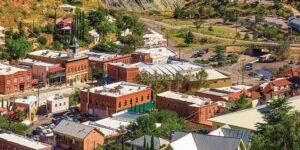
For Athletes:
there is a 1000 step run in Bisbee, Arizona called the “Bisbee 1000 The Great Stair Climb”. Based on the information provided in the search results:
- The Bisbee 1000 The Great Stair Climb is a very popular race that is run every October in Bisbee2.
- The 4.5-mile course features nine staircases with over 1,000 total steps that runners and walkers climb24.
- The race typically takes place on the 3rd Saturday of October each year. The search results indicate the 2024 race is estimated to be held on October 21, 20243.
So in summary, the Bisbee 1000 The Great Stair Climb is an annual running/walking event in Bisbee, Arizona that features over 1,000 steps spread across a 4.5-mile course, and it is held every October, usually on the 3rd Saturday of the month.
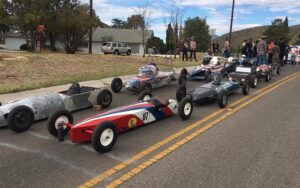
there is a soap box derby event in Bisbee, Arizona called the “Bisbee Coaster Races” or the “Bisbee Rolling Art Transport Society (BRATS)” event.The key details from the search results:
- The Bisbee Coaster Races is a celebration featuring soap box derby-like cars that typically attracts thousands of people25.
- The event is held annually on the 4th of July in Bisbee23.
- It is described as a “gravity fueled parade down Tombstone Canyon using whacky, artist-inspired soap box derby cars”4.
- The event has a rich history in the town, with roots going back to when the Phelps Dodge mining company was still operating in Bisbee2.
So in summary, yes there is a well-established soap box derby-style event called the Bisbee Coaster Races or BRATS that takes place every 4th of July in Bisbee, Arizona.
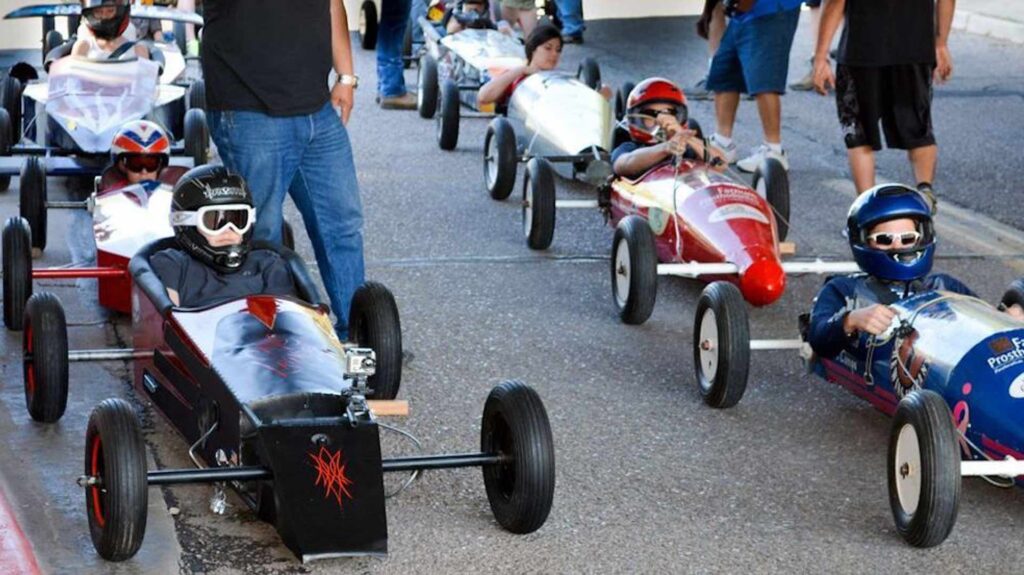
- The Bisbee 1000 The Great Stair Climb, a 4.5-mile race with over 1,000 steps.
- Hiking and birdwatching in the town’s nature reserves.
- The town also hosts events like the Bisbee Bloomers Gardens Tour, which highlights the town’s certified wildlife gardens.
Based on the search results provided, here is the history of the Bisbee Coaster Races:
- The Bisbee Coaster Races have a rich history dating back to when Bisbee was still an active mining town124.
- The event originated as popular contests among the mining community, such as drilling and mucking (shoveling rocks into mining cars)1.
- When the Phelps Dodge mining company shut down operations in Bisbee in the mid-1970s, the town experienced an exodus as people scattered4.
- However, the Bisbee Coaster Races became a way for the community to come back together and celebrate on the 4th of July each year4.
- The event features soap box derby-like cars that race down Tombstone Canyon, attracting thousands of spectators from the local community and across the state134.
- The Bisbee Coaster Races are described as a “gravity fueled parade” using “whacky, artist-inspired soap box derby cars”3.
- The event has become a beloved tradition and homecoming celebration for the people of Bisbee, even after the town’s mining heyday came to an end4.
So in summary, the Bisbee Coaster Races have deep roots in the town’s mining history, and have evolved into an annual 4th of July tradition that brings the community together.
For Beer Drinkers:
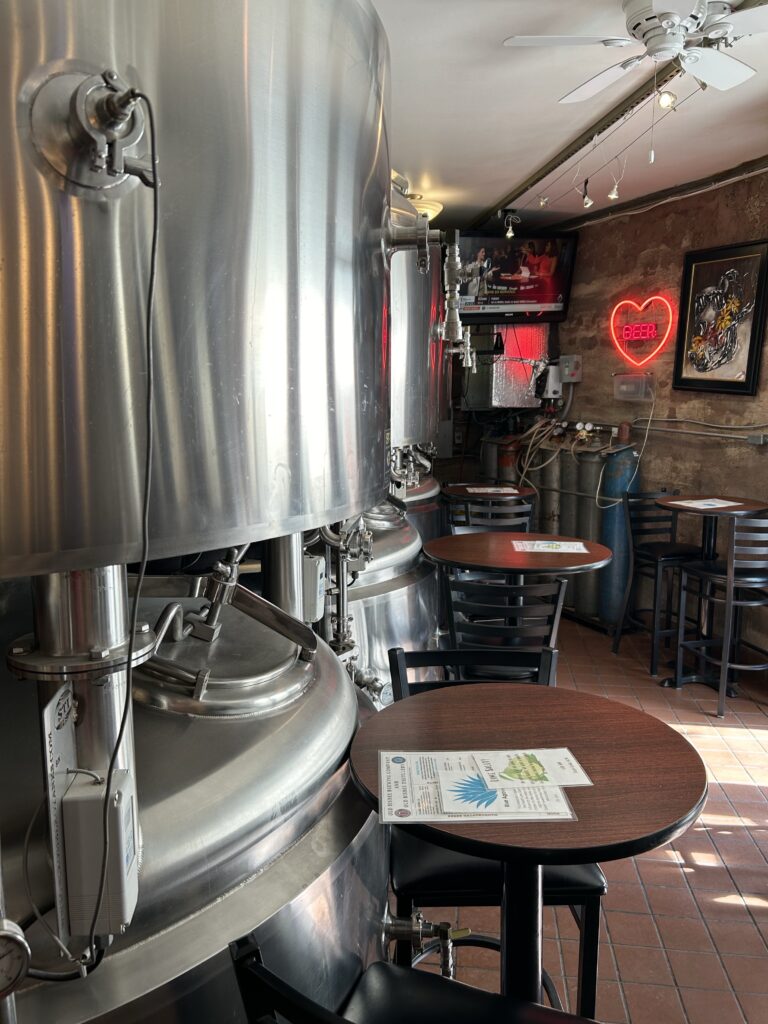
No polítical or religious discussions.
We also don’t want to hear your conspiracy theories
Why?
The idiots are always the loudest.
In the early 1900’s the rough edges of Bisbee’s mining camps could be found in notorious Brewery Gulch with its dozens of saloons, gambling halls and crib houses. The street got its name from a common activity in Bisbee’s early days, represented by Muheim’s Brewery building, which still stands today.
The “Gulch” was also the location of the Bisbee Stock Exchange, making it the center of activity in more ways than one.
One of the popular spots was St. Elmo Bar, the oldest bar in Bisbee, which is still in business to this day.
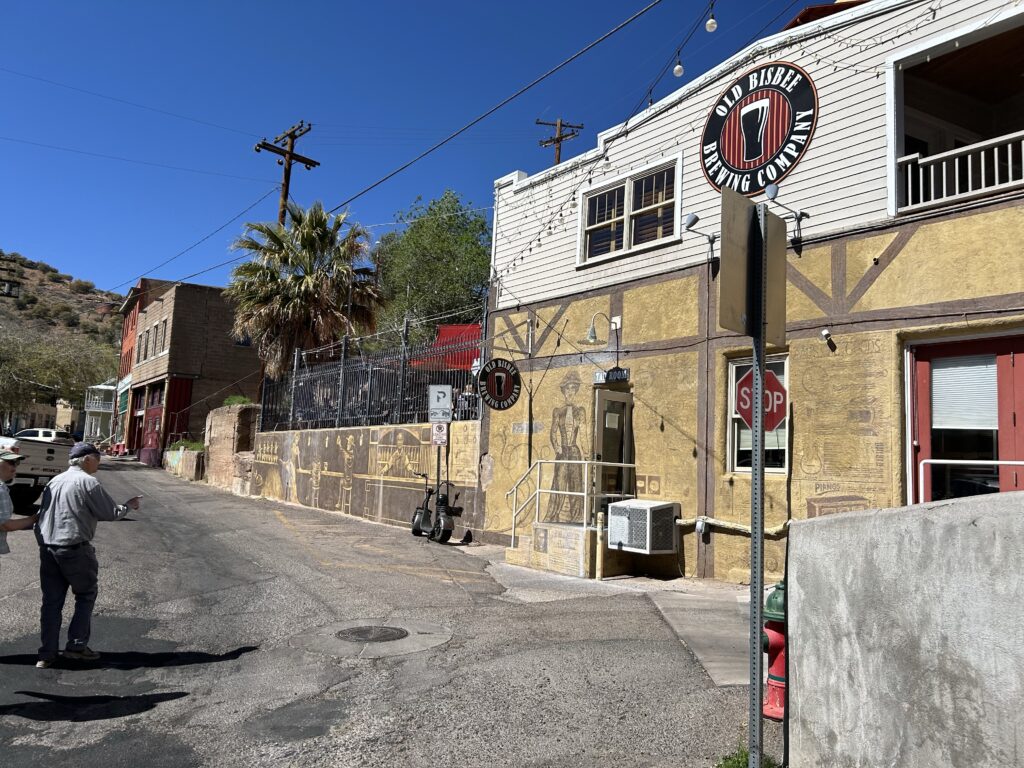
- The local breweries like Old Bisbee Brewing Company and Electric Brewing.
- The Bisbee Breakfast Club, which features a brewer/musician who creates beer inspired by the town’s history.
- The Bisbee Breakfast Club is a popular restaurant located in the Lowell district of Bisbee.
- Bisbee has a thriving music community, with local brewers like Sam Panther who are also musicians13.
- Bisbee is home to the One of Sam’s recent beer creations, an imperial stout with honey, which pays homage to his late uncle Buzz, a local musician3.
- Sam Panther, a brewer and drummer, has expanded into distilling and created a product called Bisbee Blue Gin3.
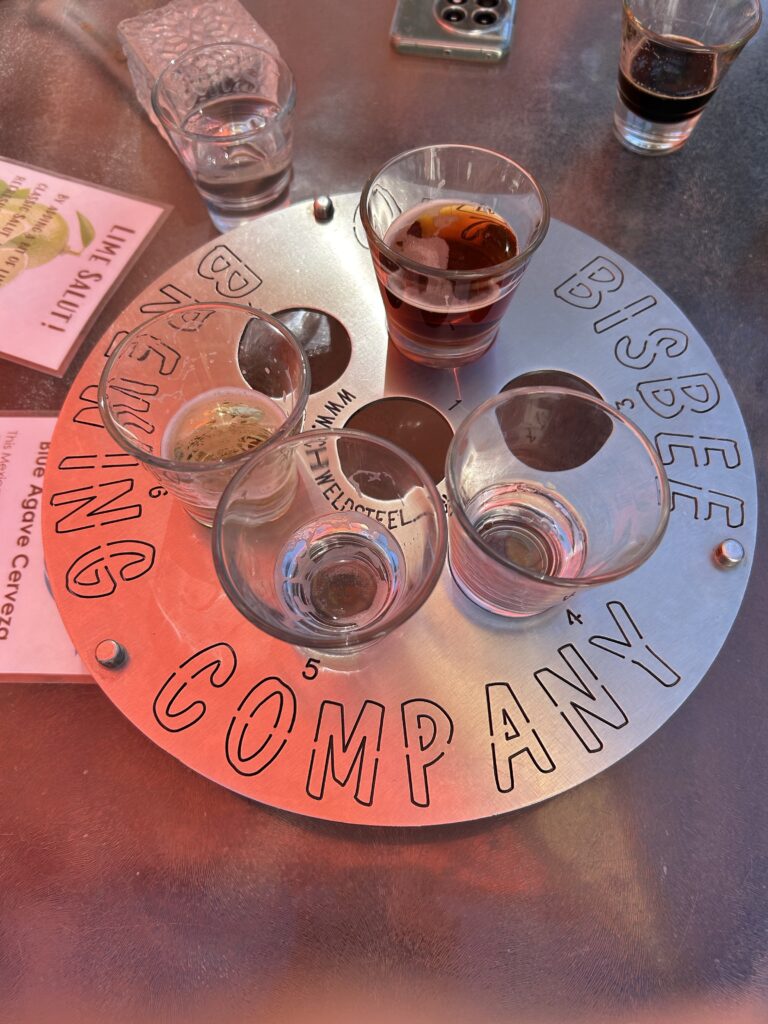
Van Life
Based on the search results provided, here is a summary of what “Van Life” is and what van life enthusiasts do in Bisbee, Arizona:Van Life:
- Van Life refers to a lifestyle of living and traveling in a converted van or RV, often as a way to live more minimally and have the freedom to explore different locations1.
What Van Lifers Do in Bisbee:
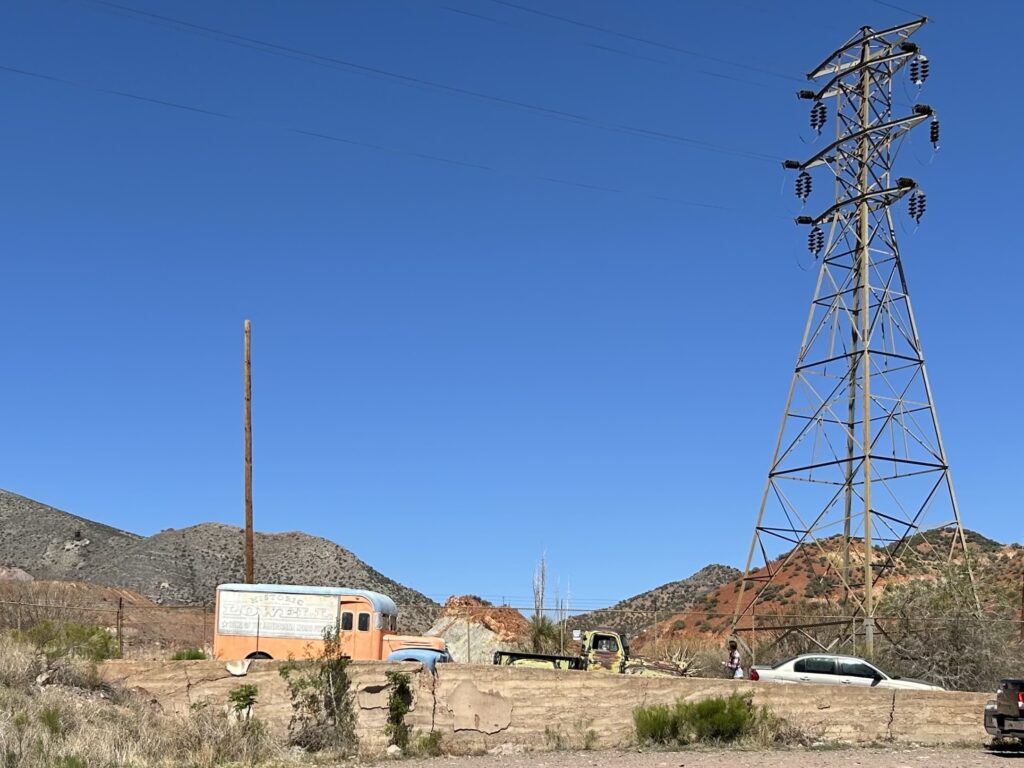
- Bisbee has become a popular destination for van life enthusiasts and nomadic communities1.
- The town hosts annual “Van Life Gatherings” or events that attract van lifers from across the region234.
- These gatherings feature van life-related activities like meetups, workshops, and social events for the van life community234.
- Van lifers enjoy exploring the unique landscapes, historic architecture, and alternative culture of Bisbee as part of their nomadic lifestyle1234.
- The town’s van life-friendly campgrounds and amenities cater to the needs of these mobile residents and visitors1.
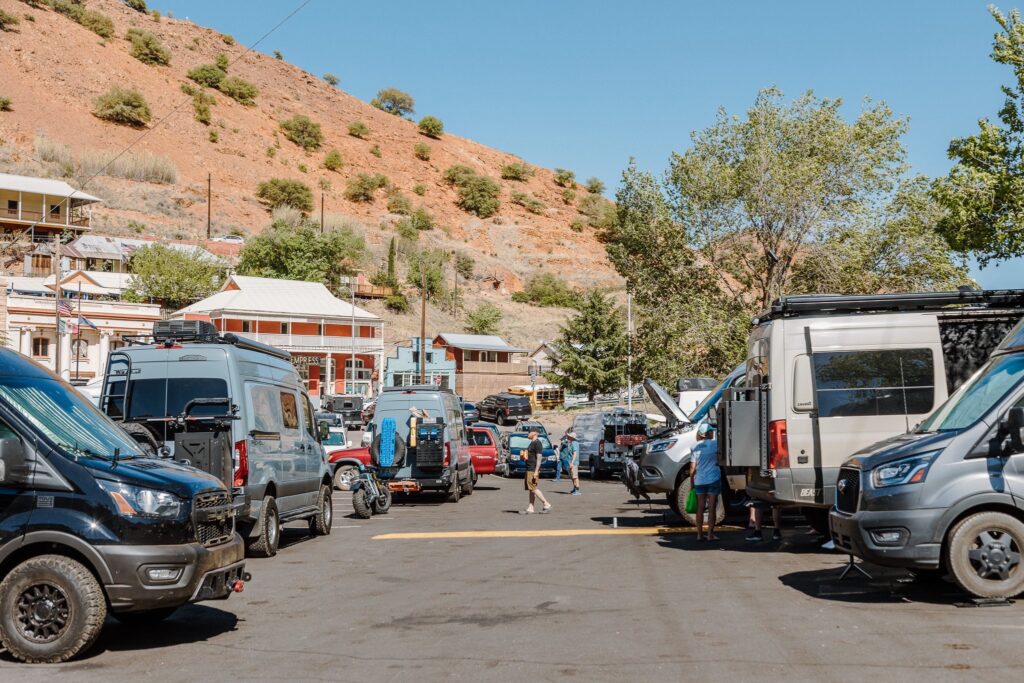
In summary, Van Life refers to a minimalist, mobile lifestyle of living and traveling in converted vans or RVs. Bisbee has become a popular destination for van life enthusiasts, who gather there annually to connect, share experiences, and immerse themselves in the town’s alternative culture and natural surroundings.
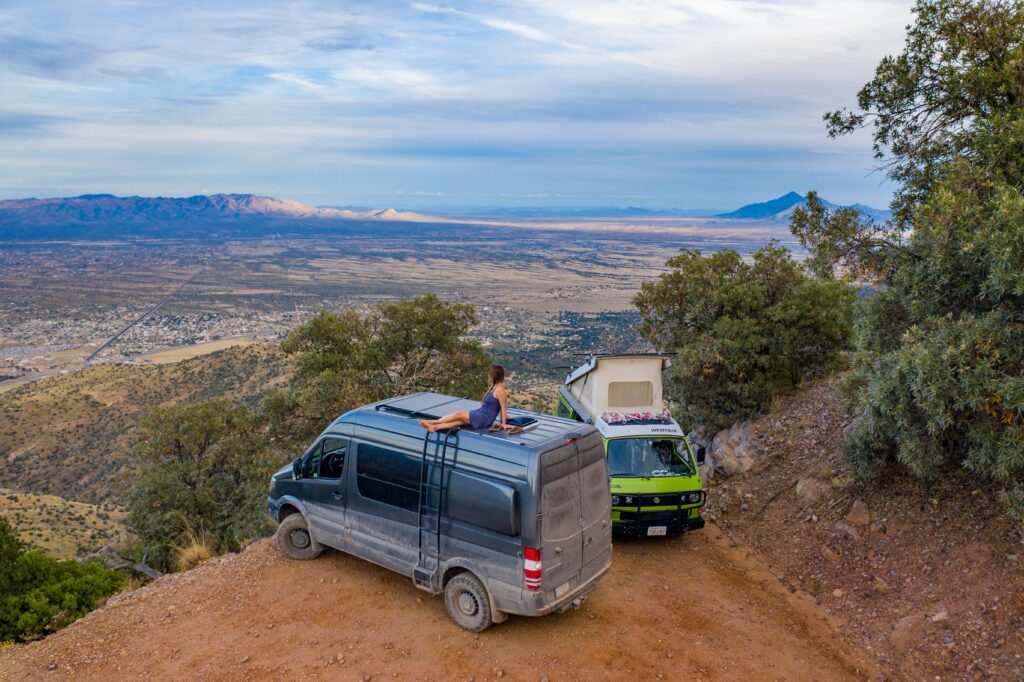
Based on the search results provided, some of the popular van life destinations and activities in Bisbee, Arizona include:
- Van Life Gatherings and Events:
- Van Life-Friendly Campgrounds:
- Bisbee has campgrounds and amenities that cater specifically to van lifers and nomadic visitors1.
- Exploring Bisbee’s Unique Landscape and Culture:
- Accessing Bisbee’s Walkable Historic District:
- The compact, walkable nature of Bisbee’s historic downtown makes it an appealing destination for van lifers to explore on foot4.
- Visiting Bisbee’s Iconic Landmarks:
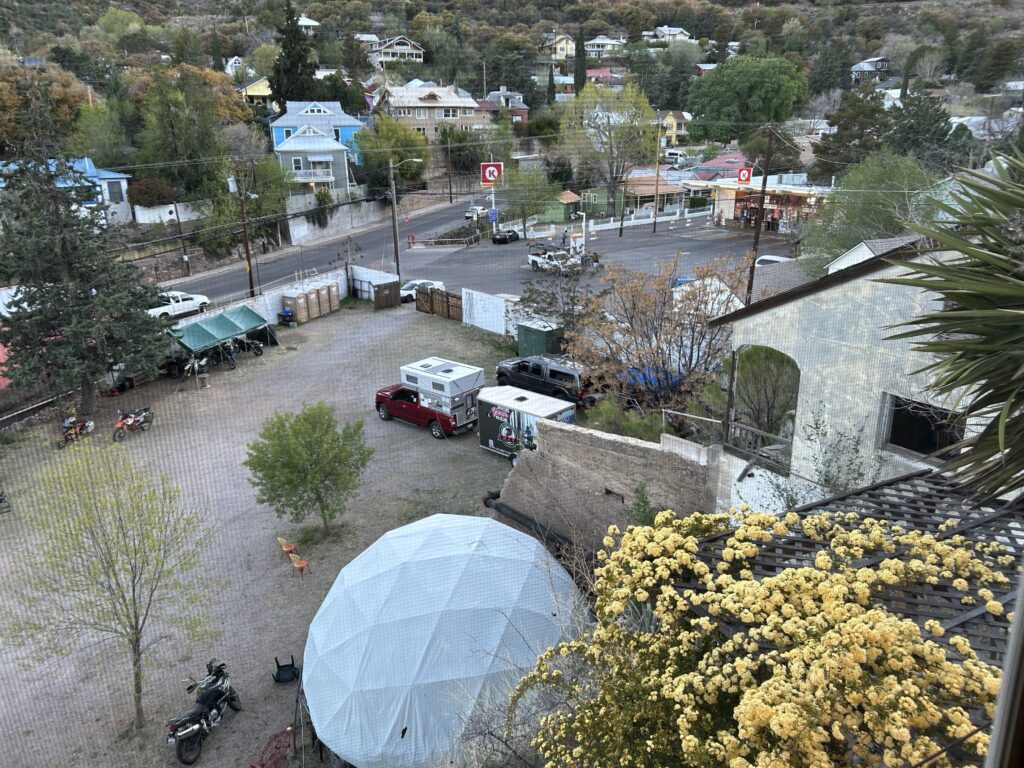
So in summary, Bisbee seems to be a popular van life destination due to its annual gatherings, van-friendly amenities, unique character, and accessibility as a walkable historic town. Van lifers are drawn to immerse themselves in Bisbee’s alternative culture and natural surroundings.
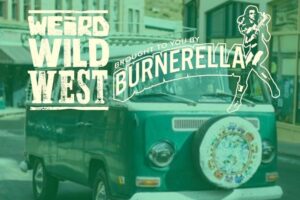
Based on the search results provided, some of the popular van life campgrounds and destinations in Bisbee, Arizona include:
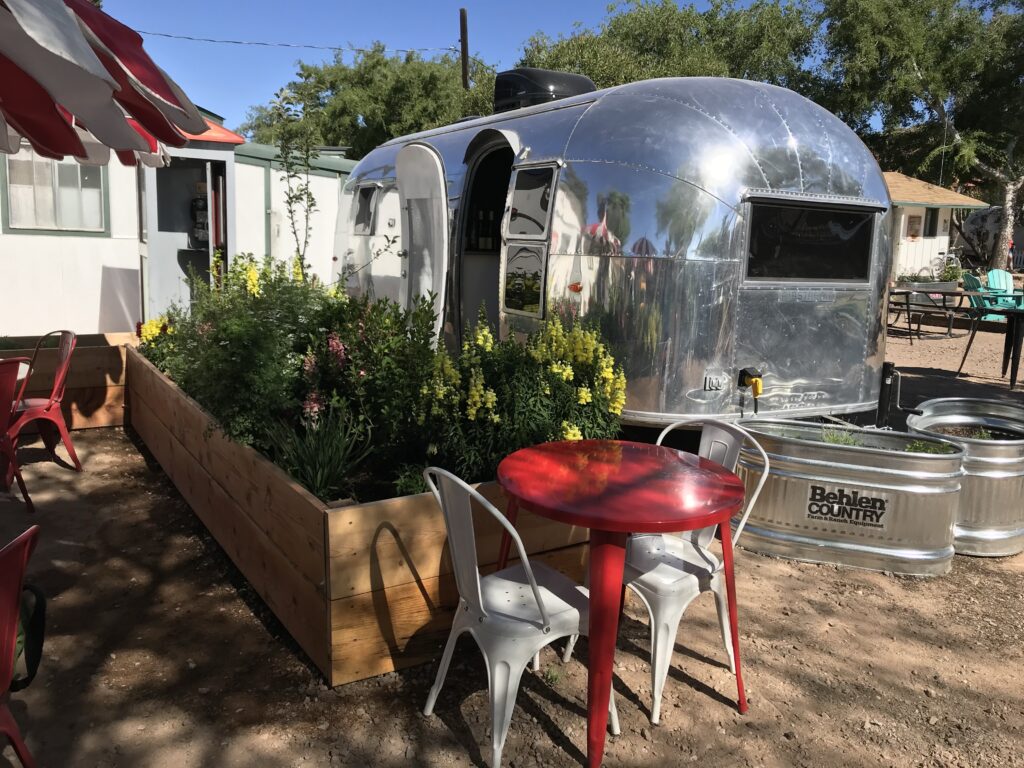
- The Van Life Campgrounds in Bisbee:
- Other Van Life-Friendly Campgrounds:
- While not explicitly named, the search results indicate that Bisbee has other campgrounds and amenities that cater to van lifers and nomadic visitors1.
- These campgrounds likely provide the necessary infrastructure and accommodations suited for van life enthusiasts.
- Exploring Bisbee’s Unique Landscape:
- Van lifers are drawn to Bisbee’s mountain setting and proximity to the US-Mexico border, as part of their desire to immerse themselves in unique natural environments1.
- The town’s temperate climate is also cited as being appealing for van life visitors year-round1.
- Accessing Bisbee’s Walkable Historic District:
- The compact, walkable nature of Bisbee’s historic downtown makes it an appealing destination for van lifers to explore on foot4.
- Attending Van Life Gatherings and Events:
- Visiting Bisbee’s Iconic Landmarks:
So in summary, the key van life destinations in Bisbee seem to be the dedicated Van Life Campground, other van-friendly campgrounds, the town’s natural setting, and the annual Van Life Gatherings that take place.
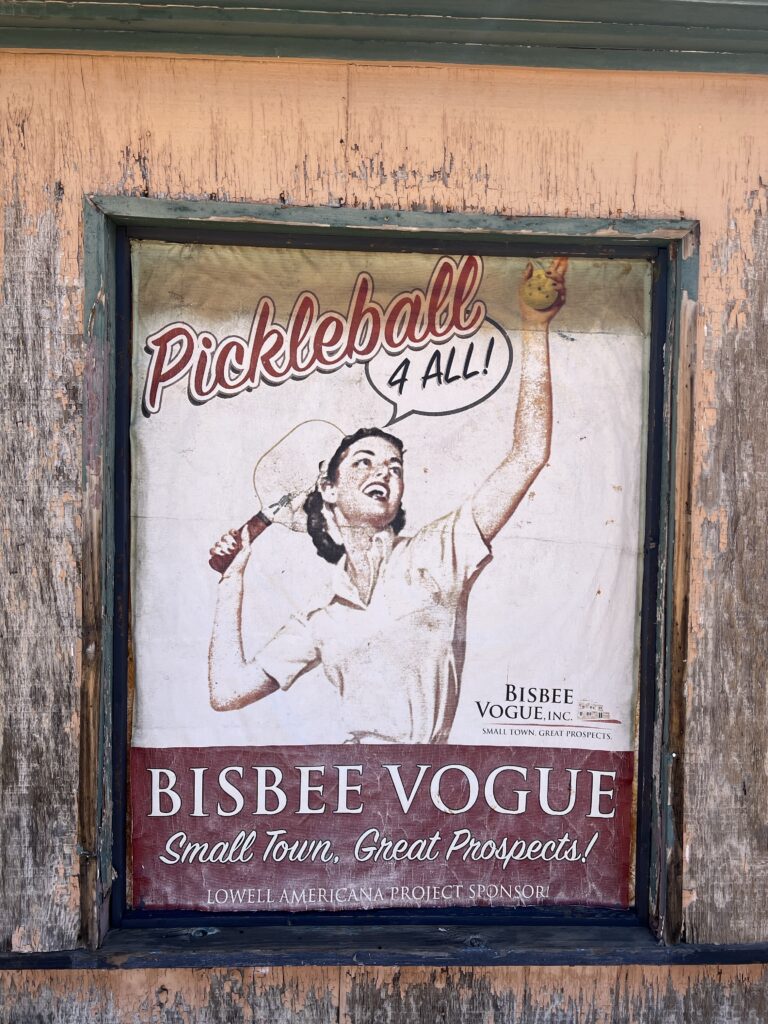
Lowell
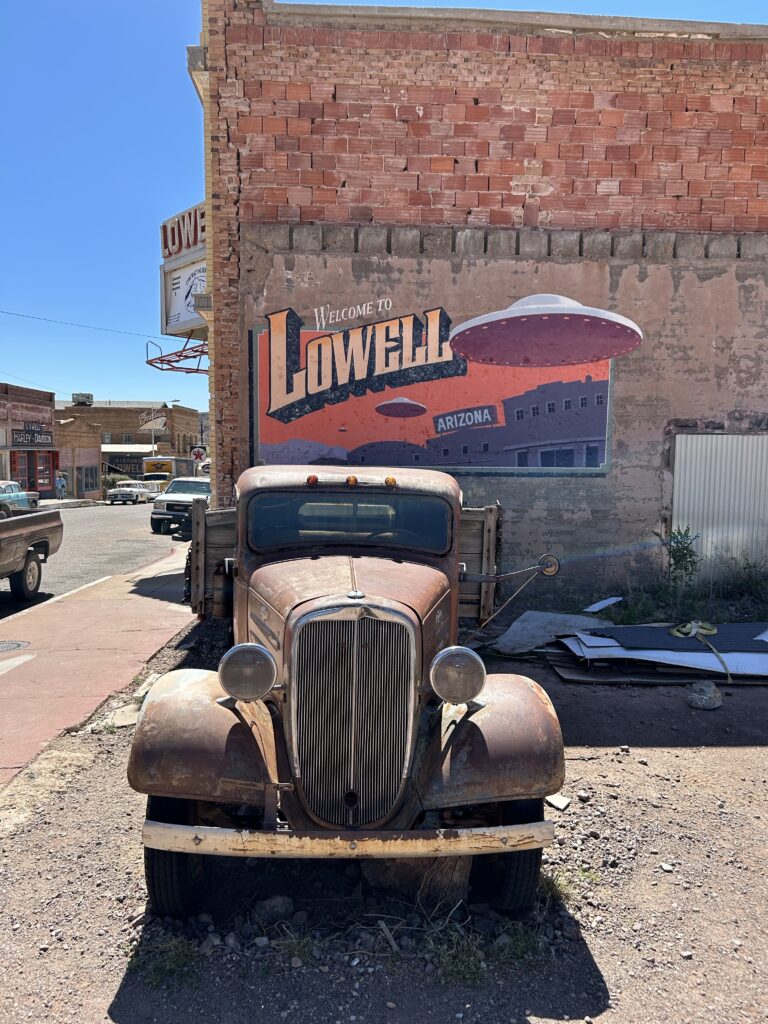
Based on the search results provided, here is the history behind the Bisbee Breakfast Club in Lowell, Arizona:
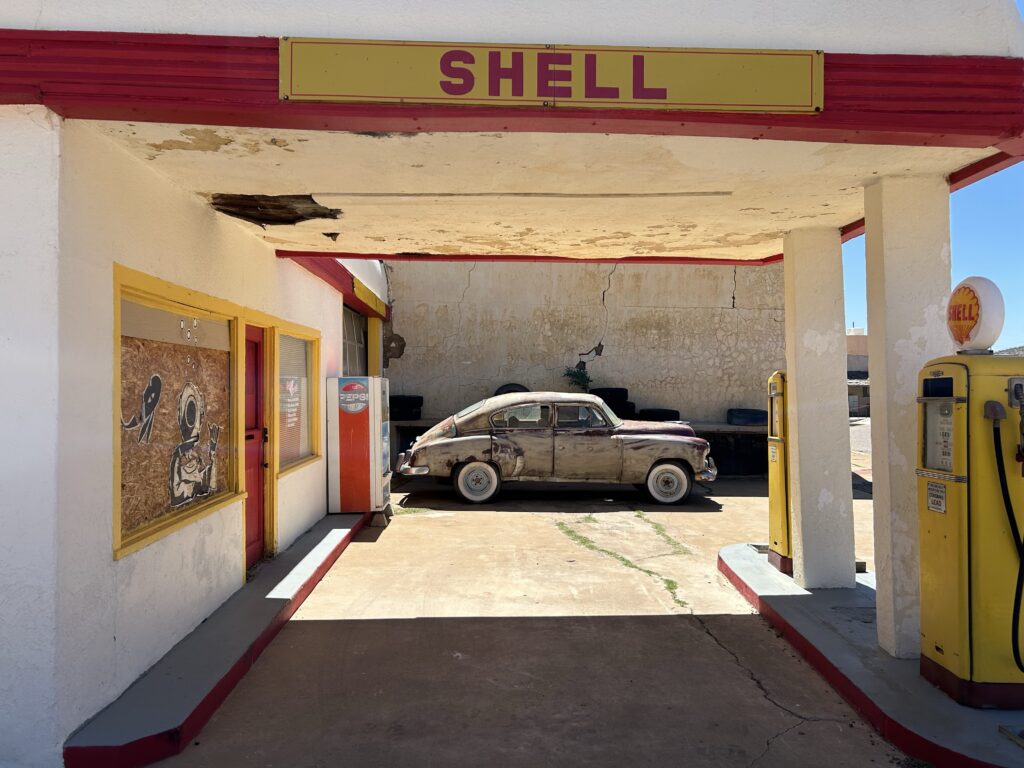
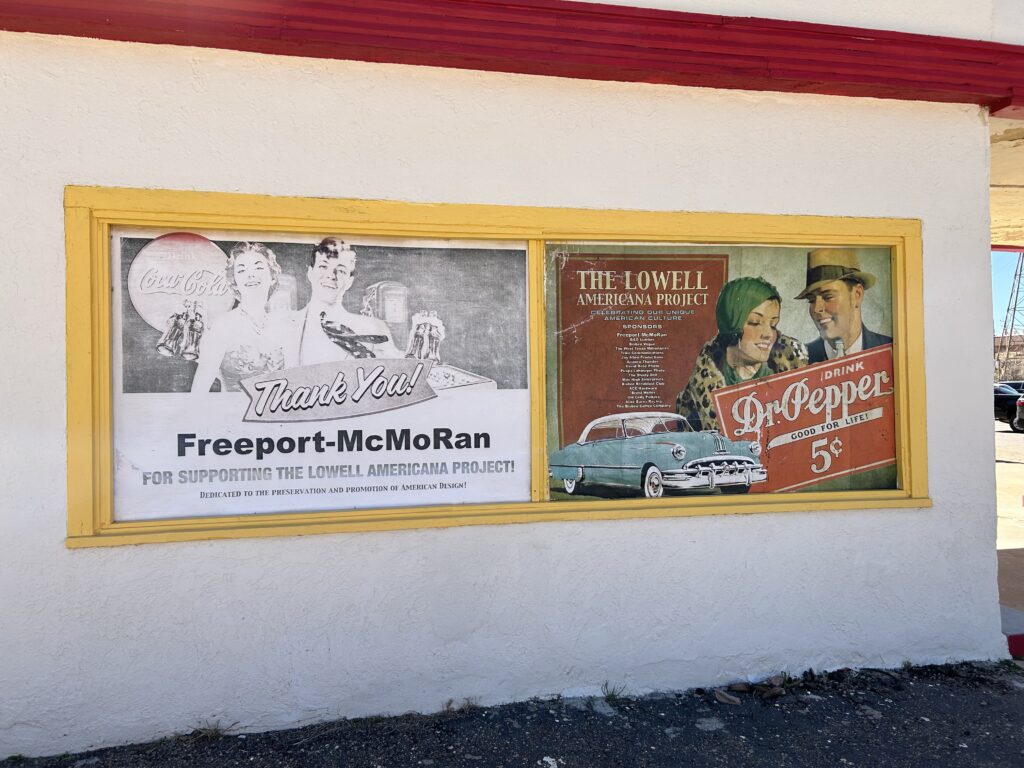
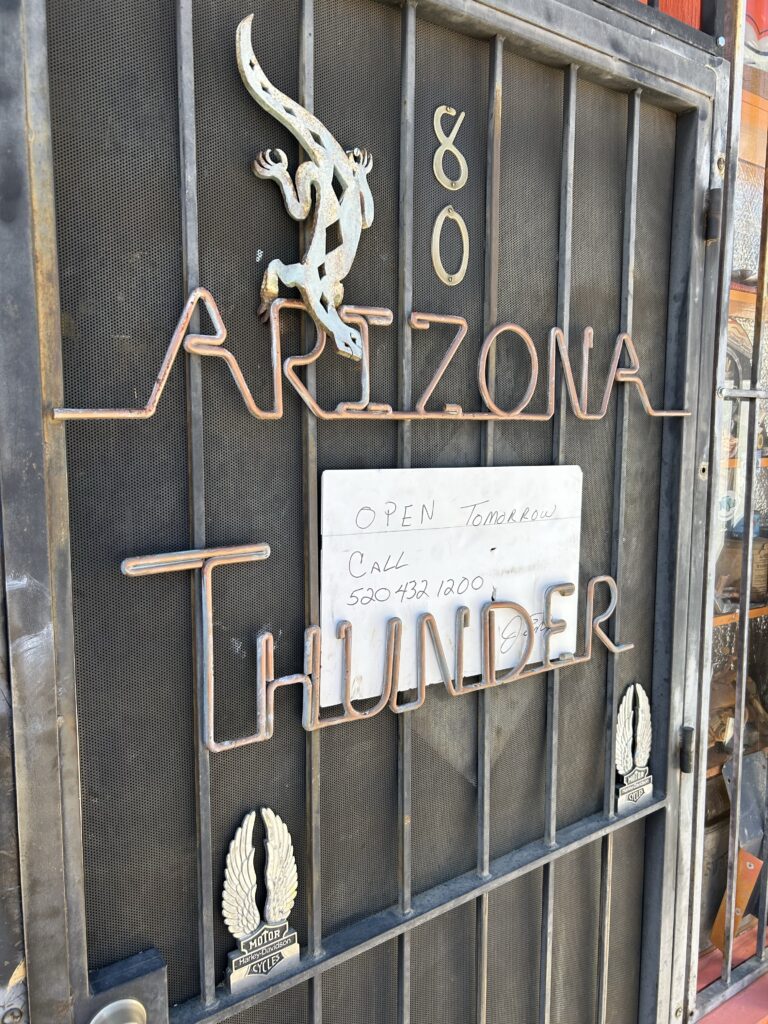
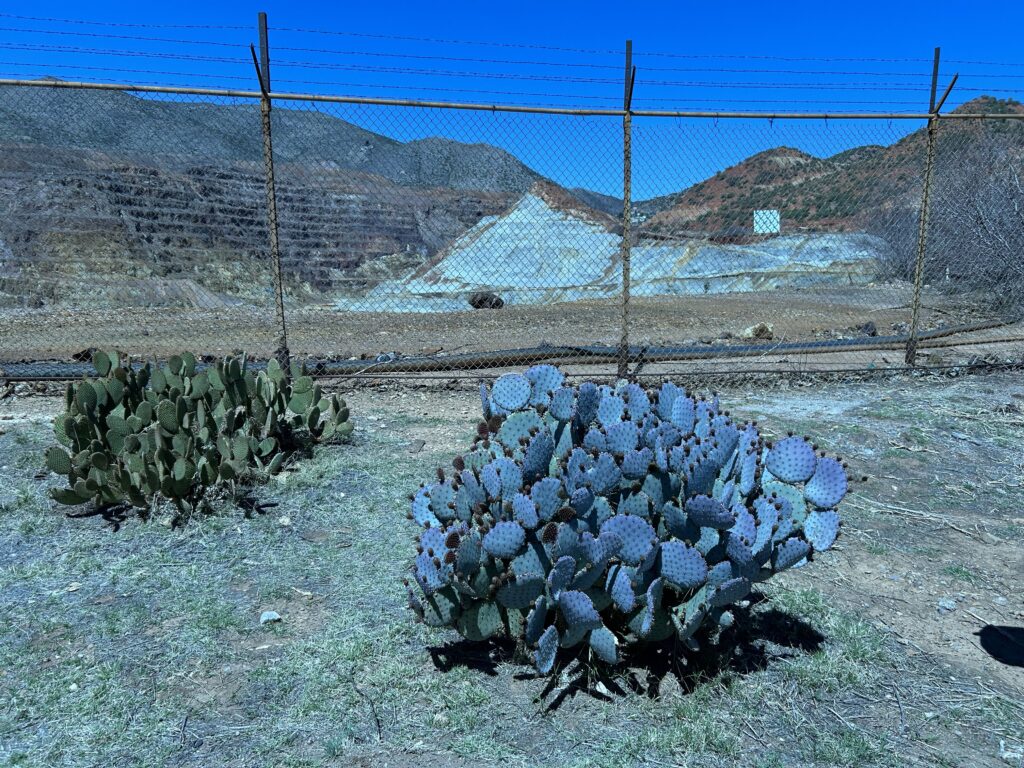
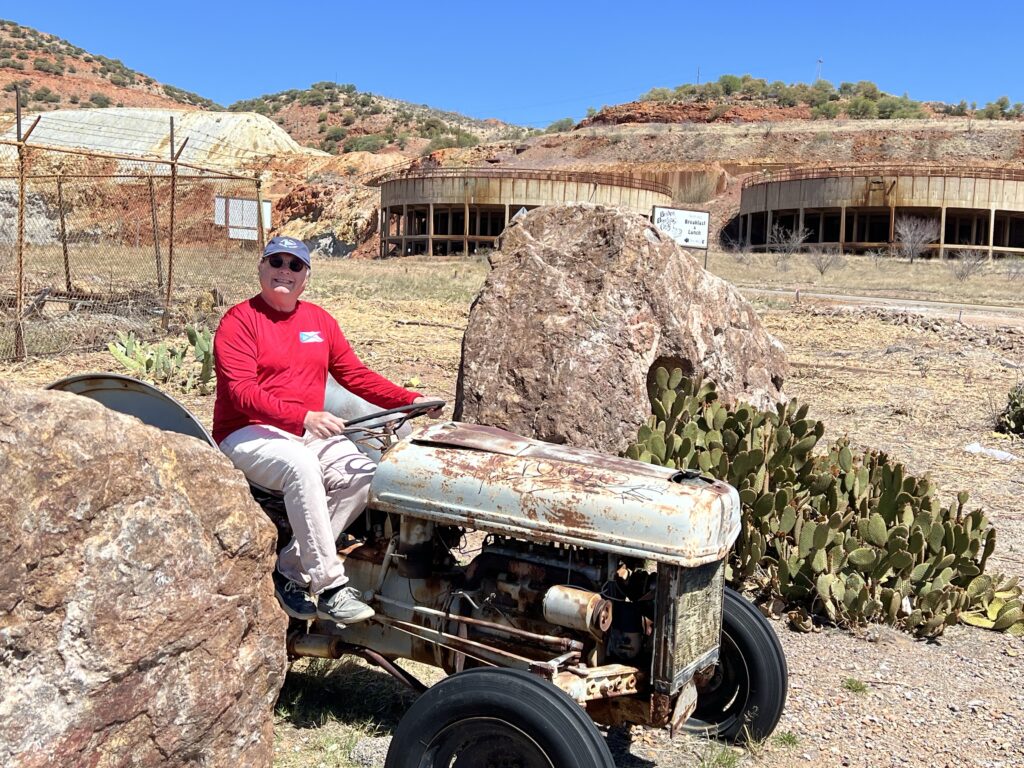
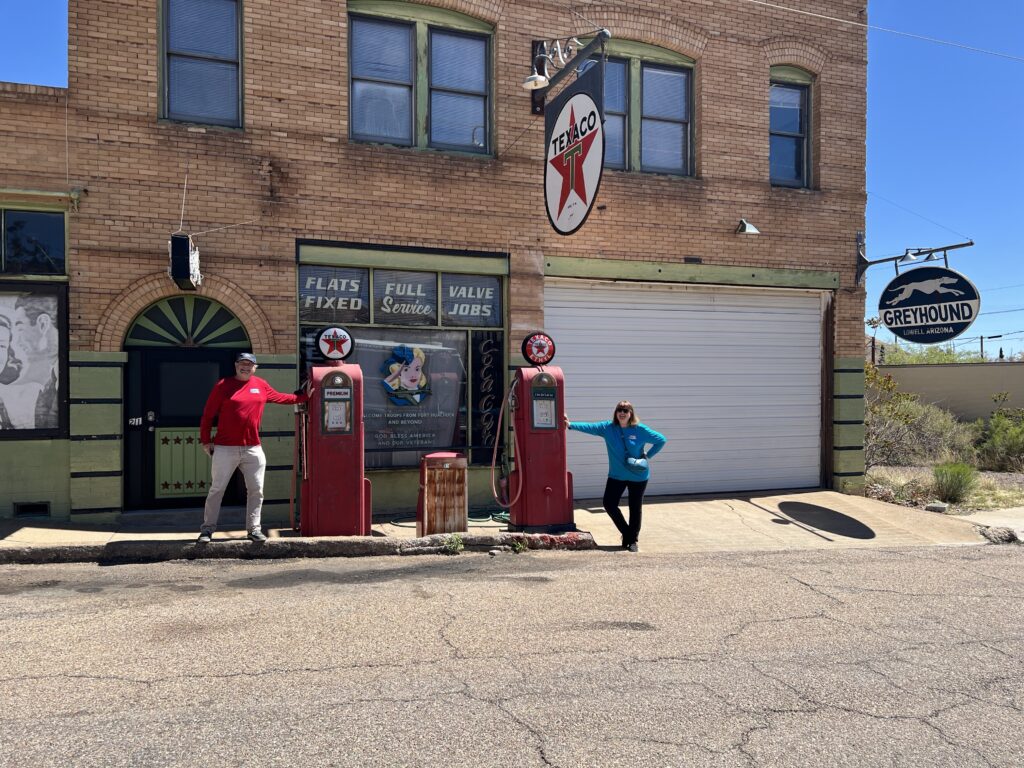
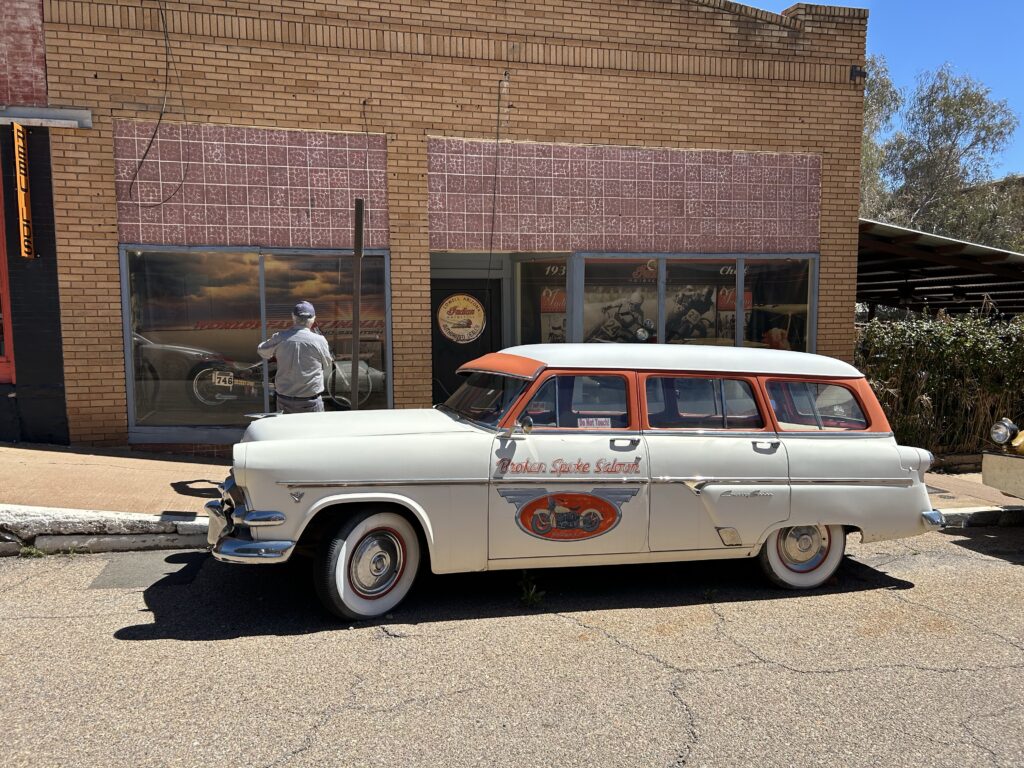
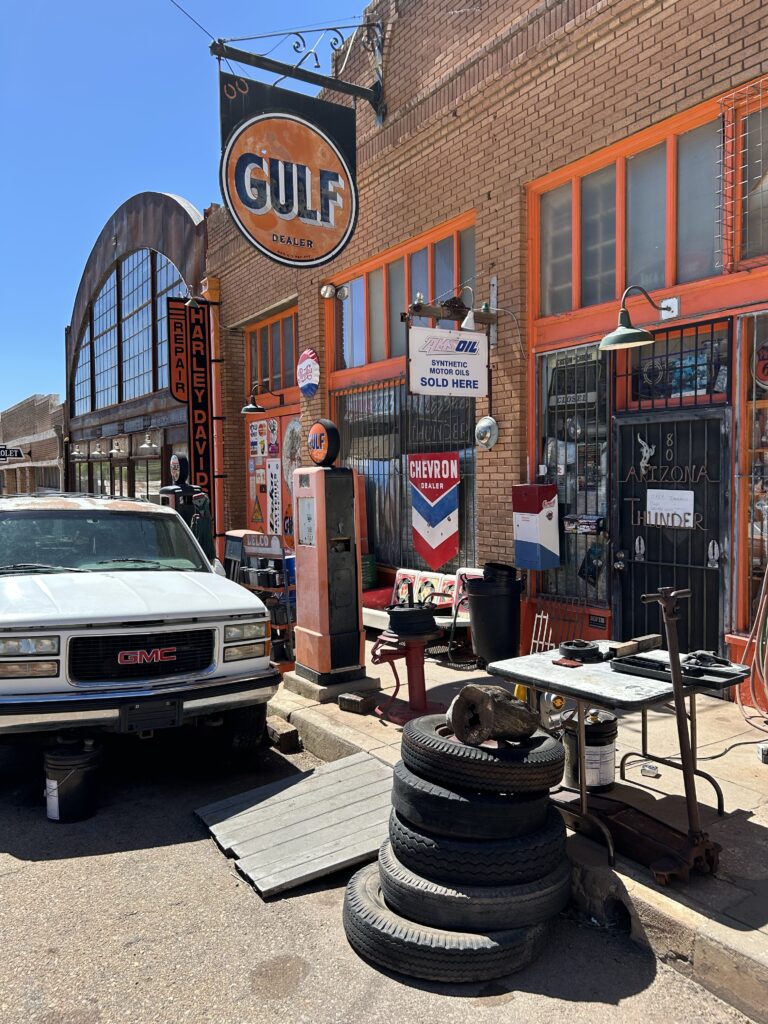
- The original Bisbee Breakfast Club location opened in 2005 in the Lowell district, just southeast of Old Bisbee134.
- The restaurant was located in a historic building that was originally a Rexall pharmacy and then a glass factory134.
- The Bisbee Breakfast Club was an instant hit when it opened and soon expanded into the neighboring space in 20091.
- The restaurant has since changed hands, but the current owner kept the low prices and popular menu items that made the place so popular, such as blueberry and walnut buttermilk pancakes, coffee-charred chicken salad, and cream pies4.
- The Bisbee Breakfast Club helped drive the reinvention of the Lowell district, inspiring nearby business owners to dress up the area and re-create the historical feel from old photographs4.
- The original Bisbee Breakfast Club location has a vintage Bisbee feel, with a glass storefront, brick wall, and green linoleum floors4.
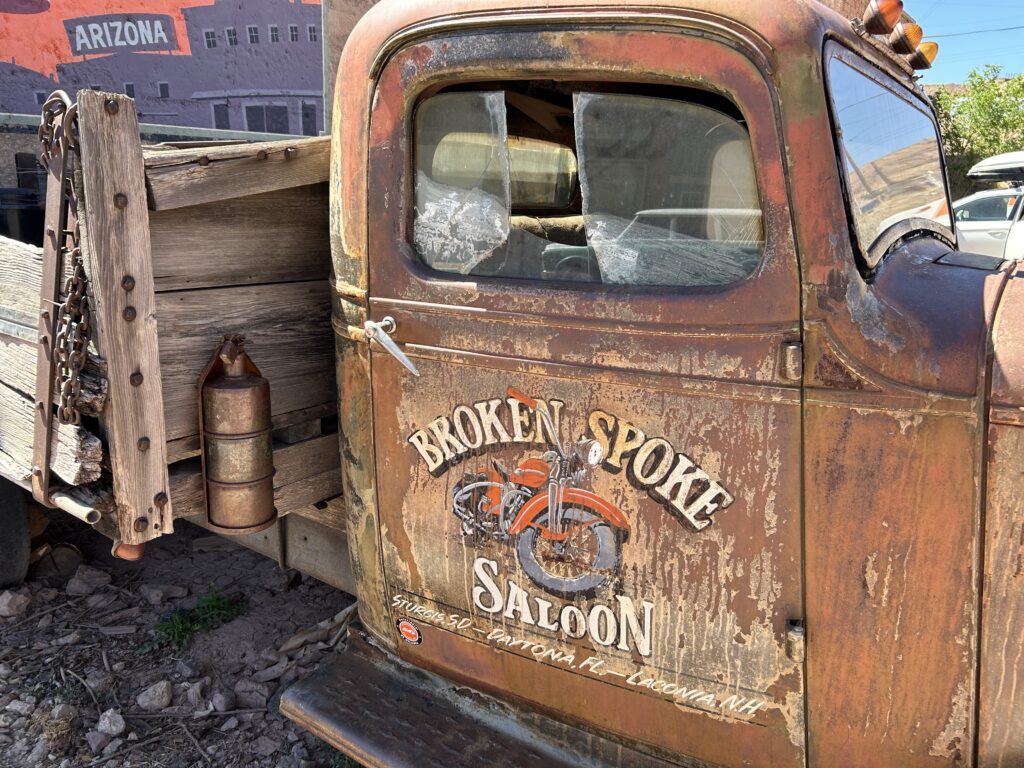
So in summary, the Bisbee Breakfast Club was founded in 2005 in the historic Lowell district of Bisbee, quickly becoming a local institution and helping to revitalize the surrounding area.
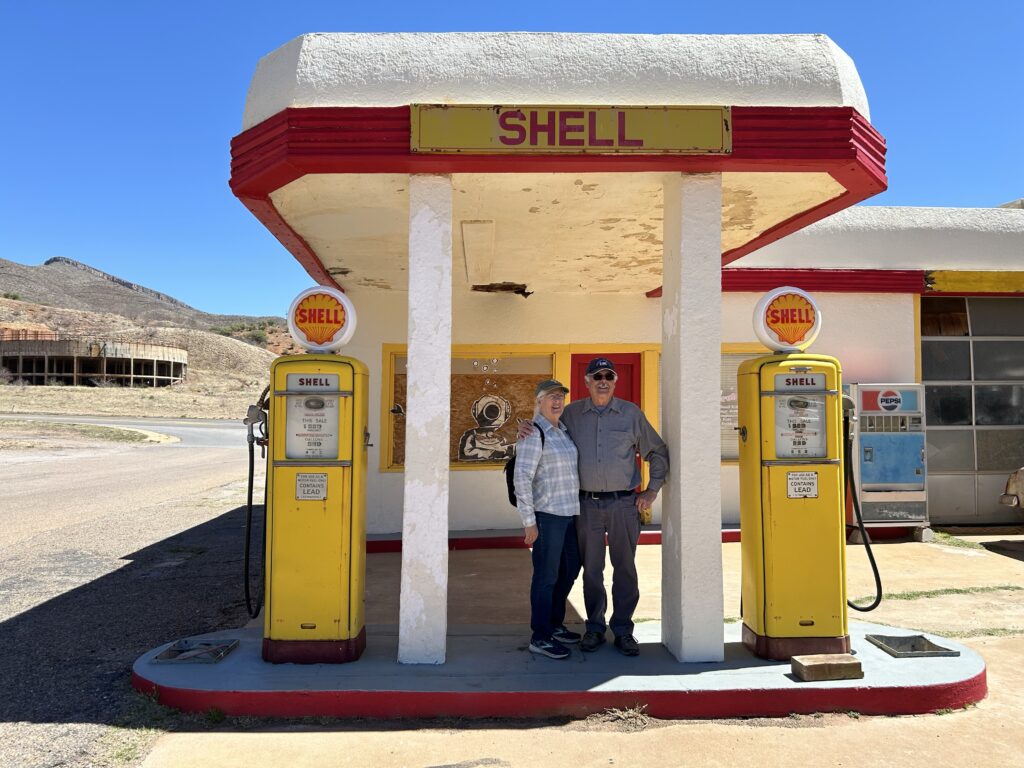
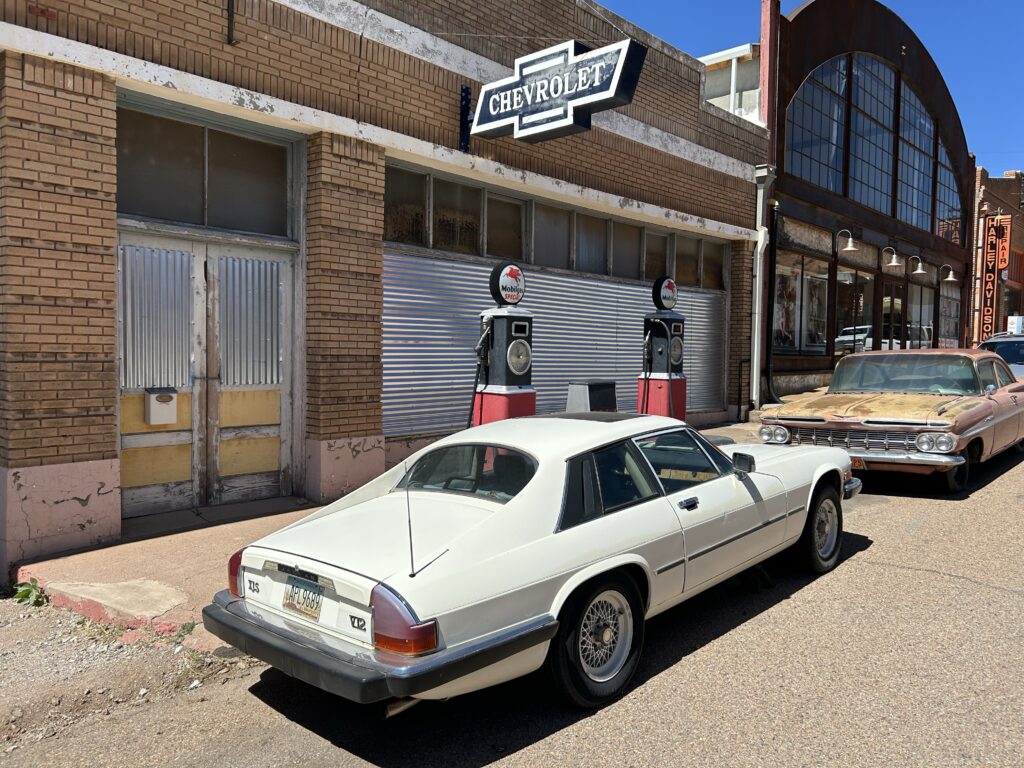
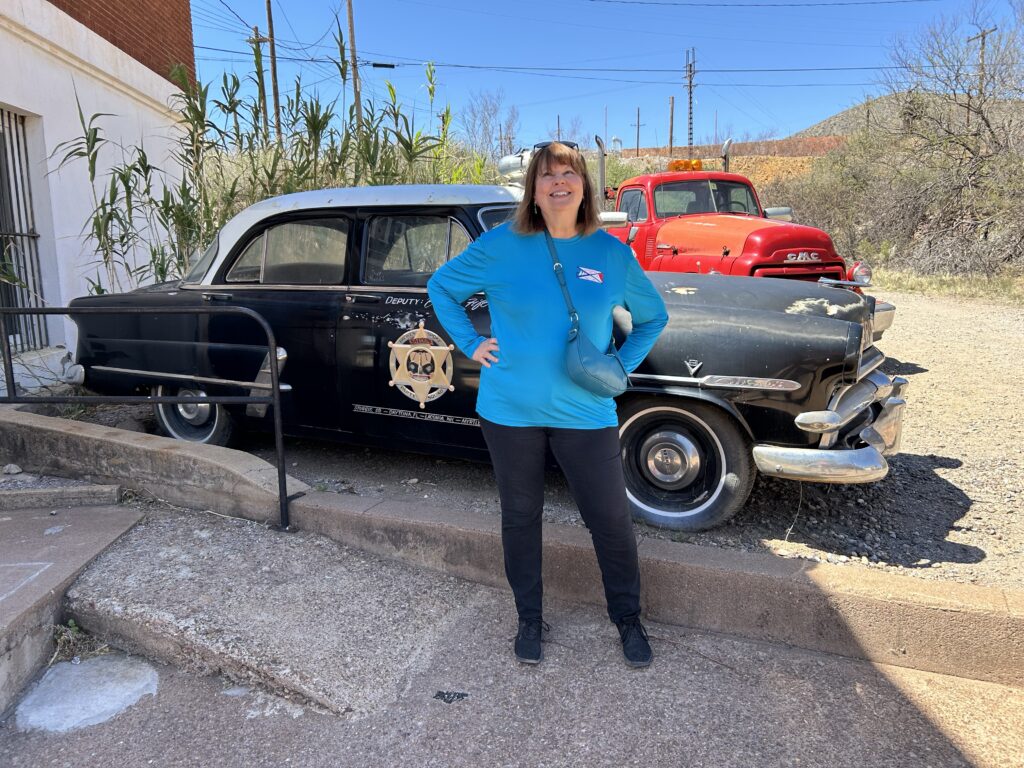
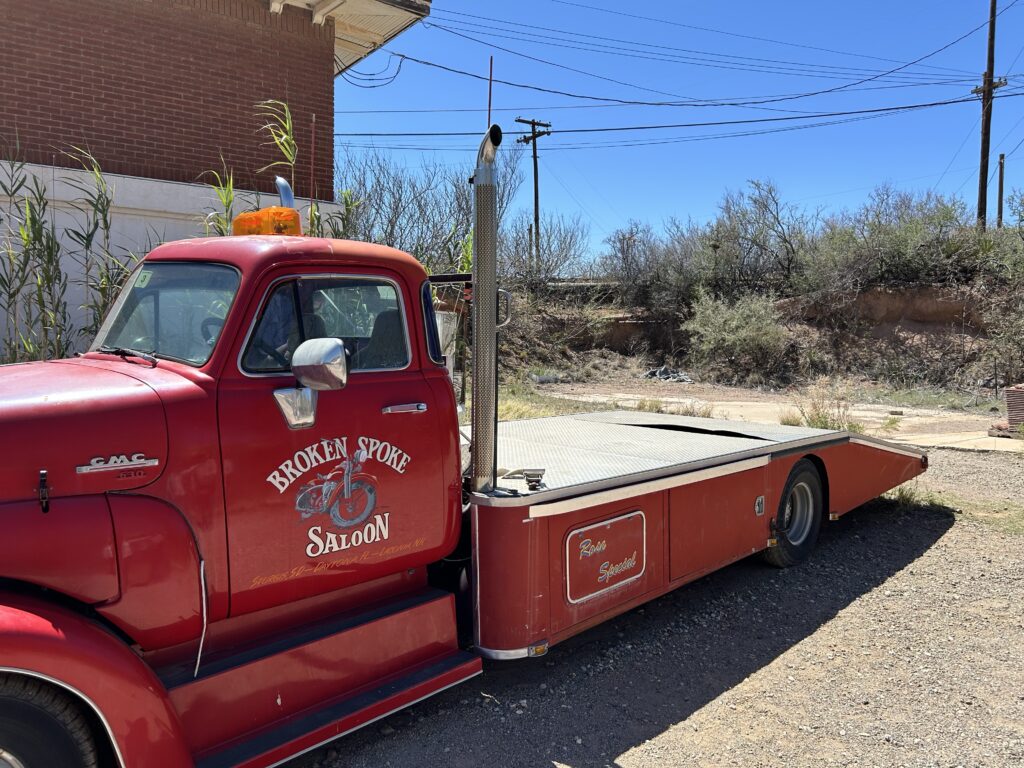
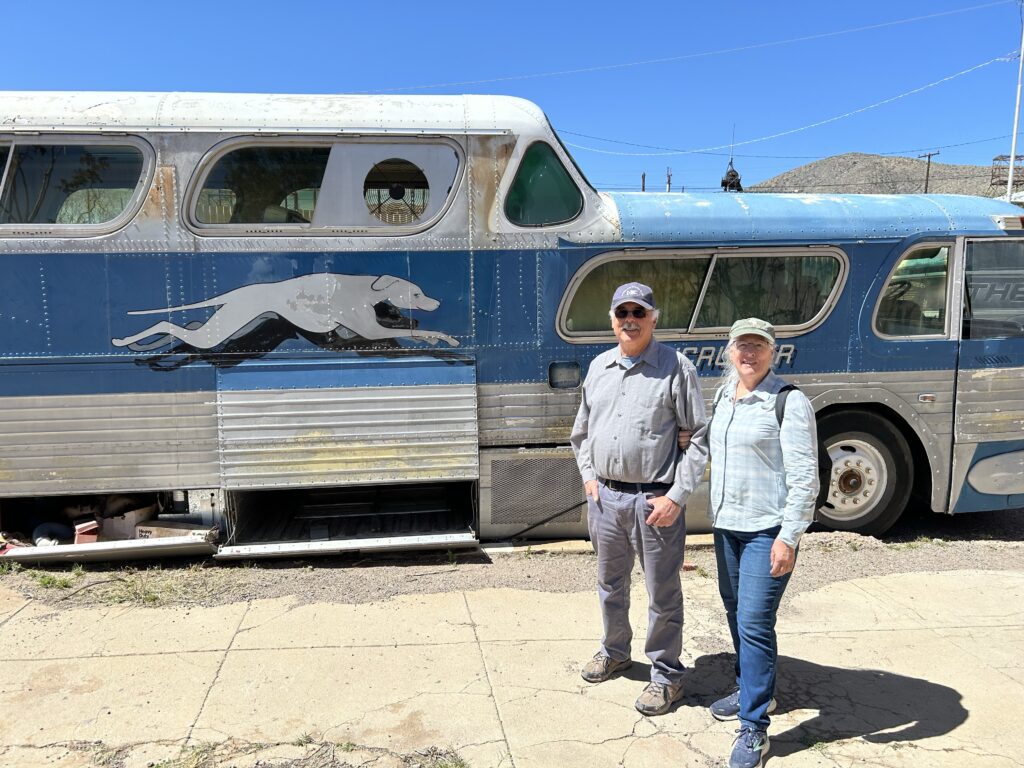
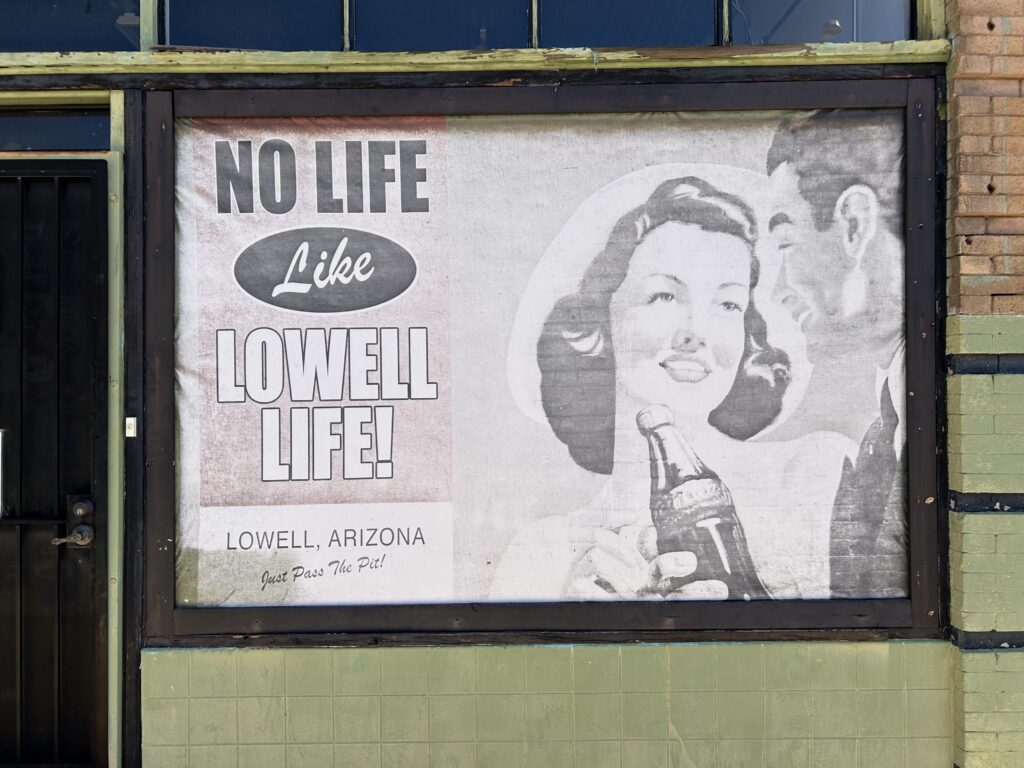
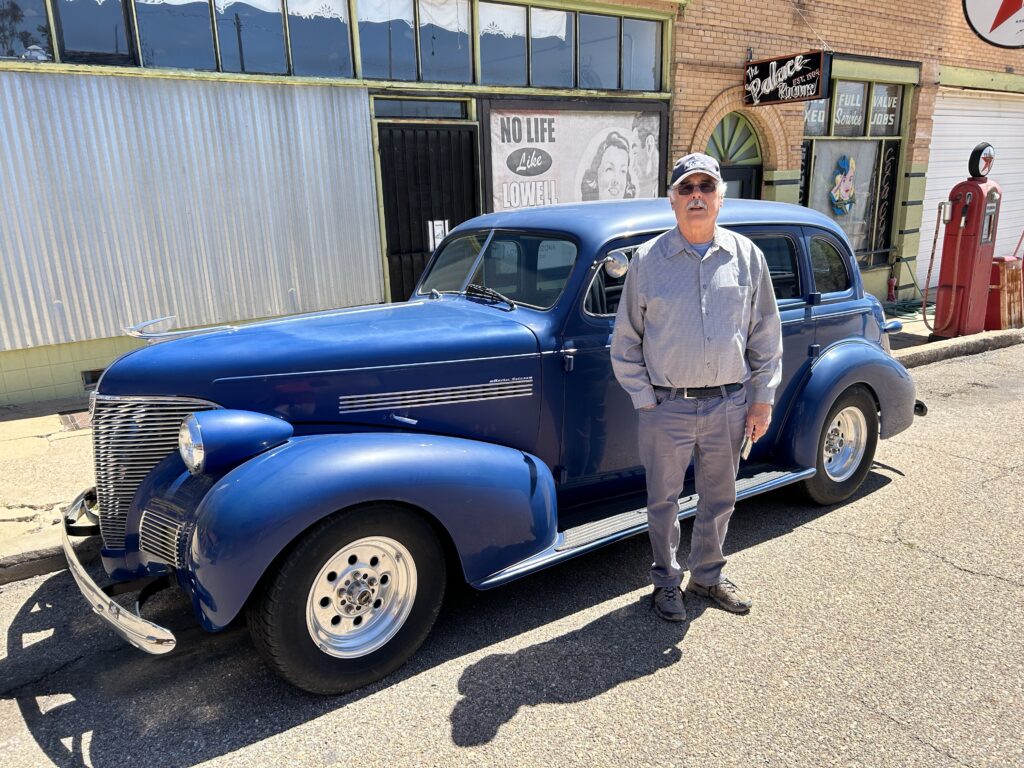
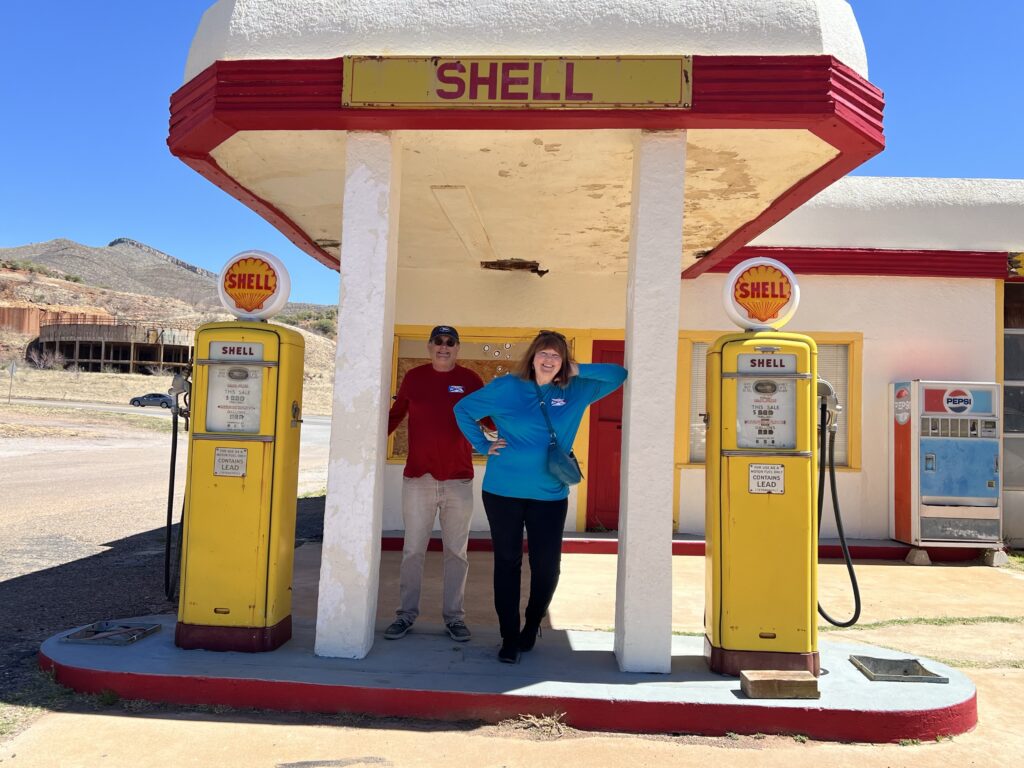
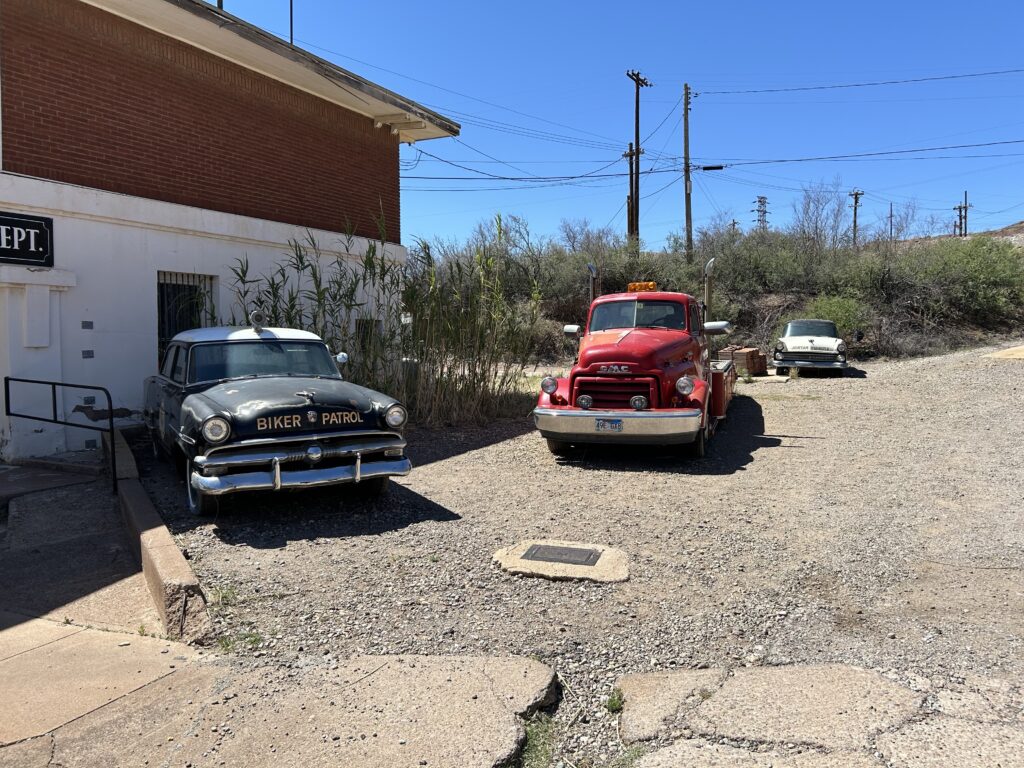
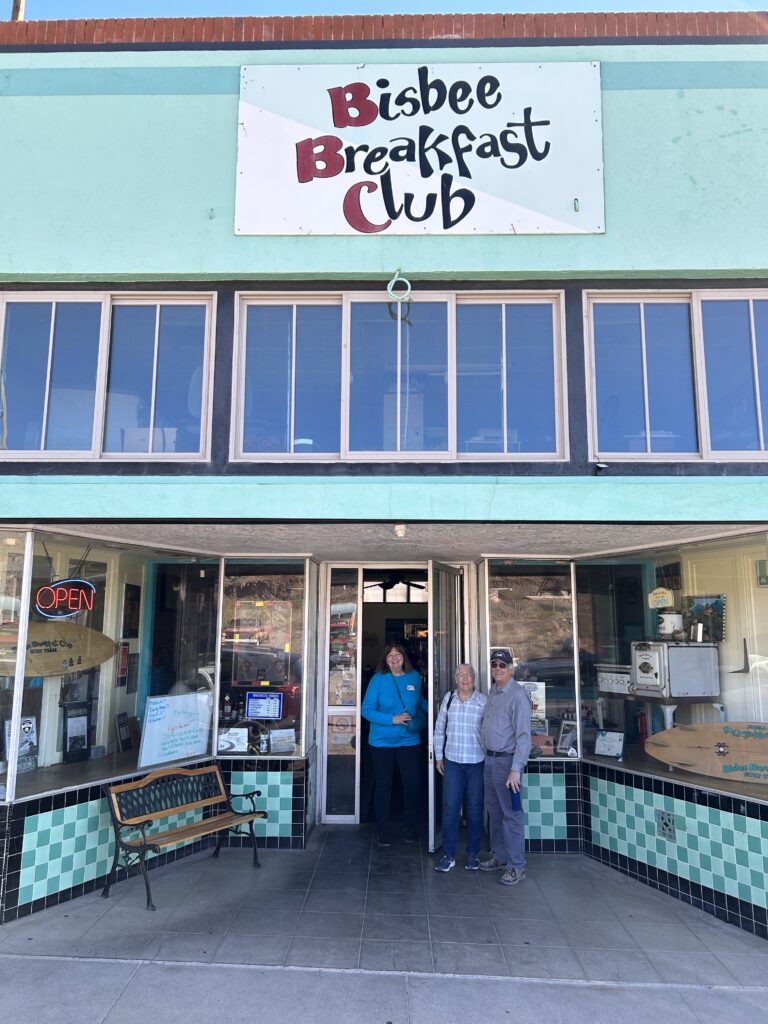
Warren
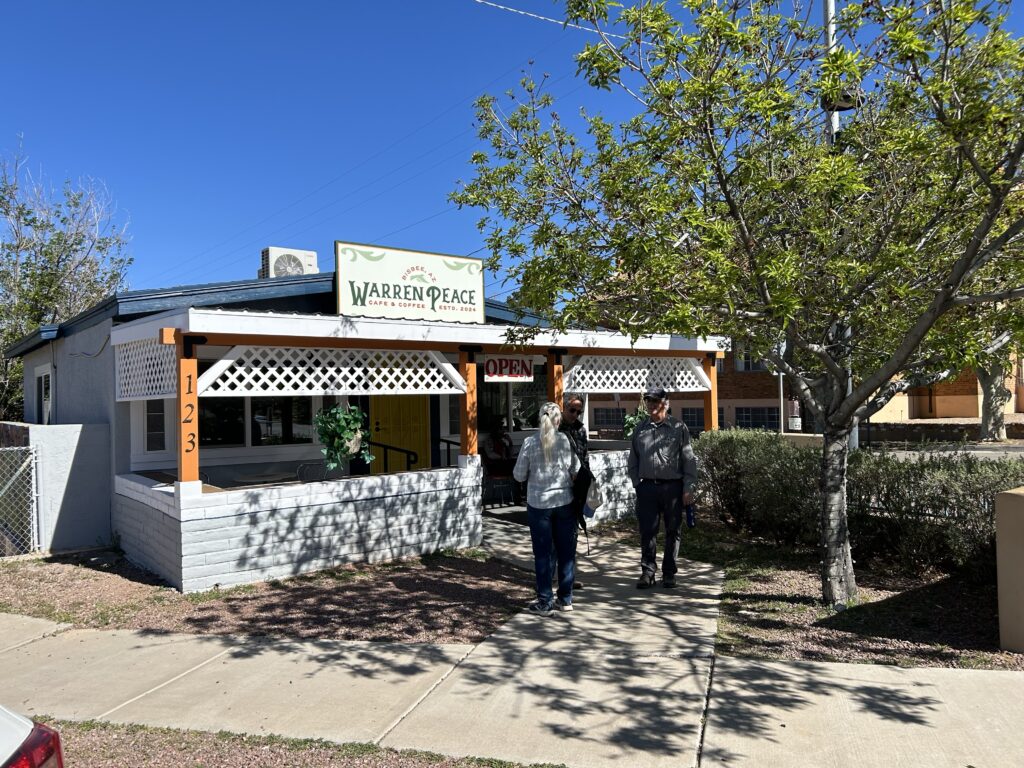
In January 1906 the Warren Company hired Warren Henry Manning to prepare a plan for the Warren townsite.
From the beginning, Warren was to be a City Beautiful (the only such town in Arizona). The idea was to combine comprehensive functional and aesthetic qualities from the City Beautiful concept with the cri al characteristics of a mining company town: affordable housing, sanitary conditions, a good water supply, and recreational and educational opportunities.
Warren’s “City Beautiful” plan featured half-mile long Vista Park and wide boulevards.
The townsite was laid out in a wedge or fan shape to take advantage of natural drainage. From the center of the fan, wide boulevards reached out symmetrically. To the northeast, steep hillsides required curving, concentric roads, following the topography. This provided access to residential lots commanding a view of the townsite and surrounding countryside. The townsite plan was dominated by Vista Park – 2,500 feet long, and 160 feet wide, flanked on either side by 60-foot wide boulevards. The park’s southern end was to terminate in a broad open “Plaza.”
Warren’s development started officially on October 6, 1906, with a groundbreaking ceremony. (Design and construction of an electric railway system to connect Warren with Bisbee also started at about this time; see below.) On January 7, 1907, after completion of street grading and installation of electrical service, the Warren townsite was officially opened to the public. Marketing of the townsite and the sale of lots were handled by the Warren Company.
The first building constructed in Warren in 1907 was the two-story office building of the Warren Company.
Other early important non-residential buildings included the Warren-Bisbee Railway Car Barn (1907) and the C & A Mining Company Office Building (1909). (The Warren Baseball Park was also constructed during this period. The modern sewage and water system were completed in 1907. Water pumped from the Bisbee mines (*copper water”) flowed by gravity through a series of pipes, both underground and supported by wooden flumes, to Warren. This provided free irrigation for lawns, gardens, and thousands of trees planted throughout the community. To protect against infrequent, but torrential rains, flood channels were dug right down the middle of several wide boulevards, in the direction of the natural drainage.
WARREN, ARIZONA – THE CITY BEAUTIFUL
There were 650 residents in Warren at the end of 1910. Vista Park was completed in 1911. A dance pavilion and a community swimming pool were soon built in the park. By 1913, Warren had a population of nearly a thousand people. In 1917, more than 90 percent of the residents of Warren owned their own homes, most paid for through payroll deduction. (C&A mineworkers made $5-6 per hour between 1915-1920)

Warren was the district of the mining town of Bisbee where the people who ran the mines lived. It was designed following the “City Beautiful” concept at the beginning of the 20th century and is the first planned community in Arizona. Warren is built around the Vista, a north-south running stretch of park, where the city’s Farmer’s Market is held each Saturday throughout most of the year.
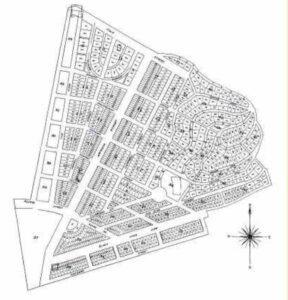
Warren’s “City Beautiful” plan featured half-mile long Vista Park and wide boulevards.
The neighborhood is known for its fine collection of Arts and Crafts style bungalow houses, many of which are historically registered and can be visited by the public during the city’s annual home tour. Warren Ballpark, a Bisbee gem, is the oldest continuously operating ballpark in the U.S. and is located in the southern end of the Vista.
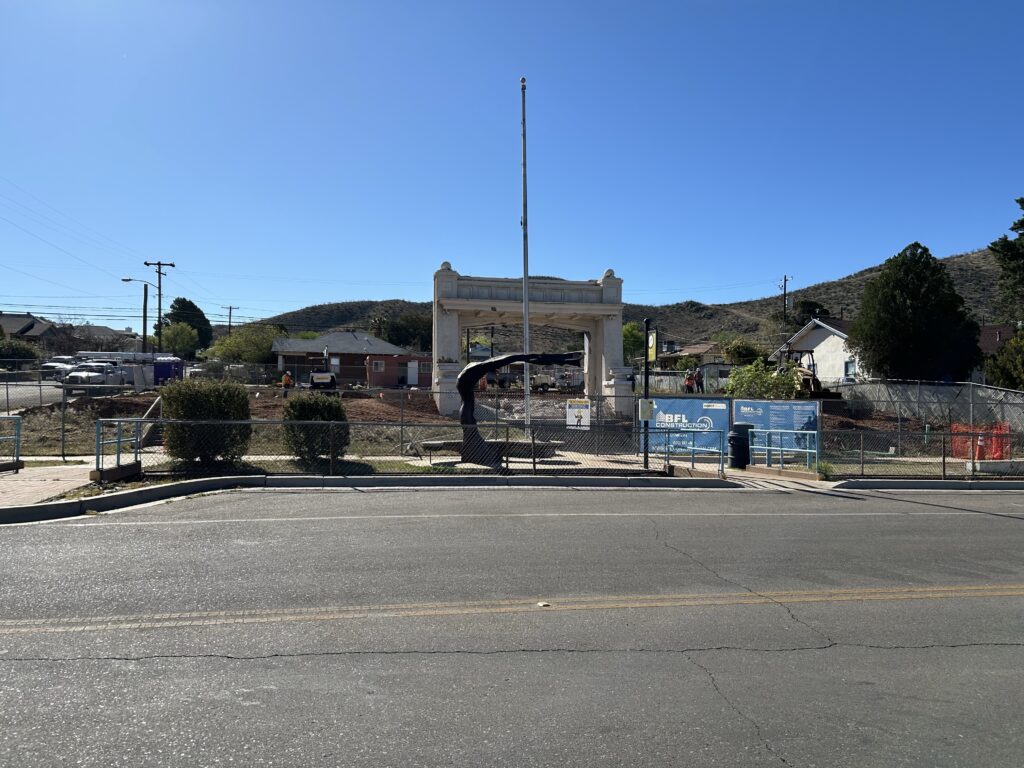

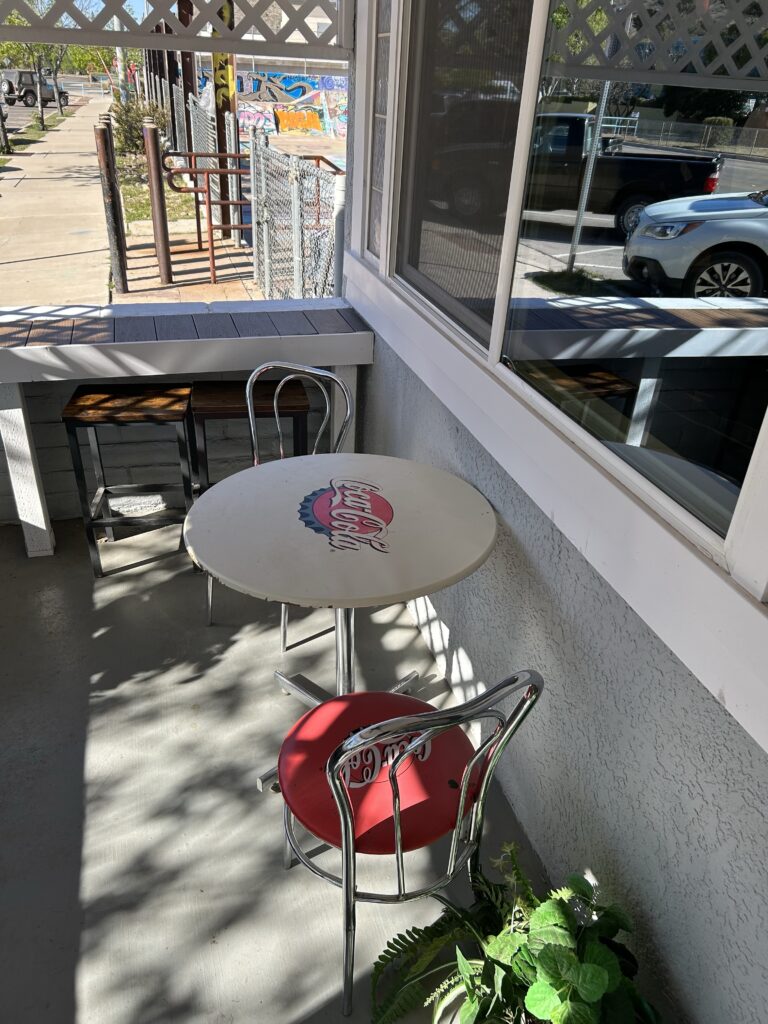
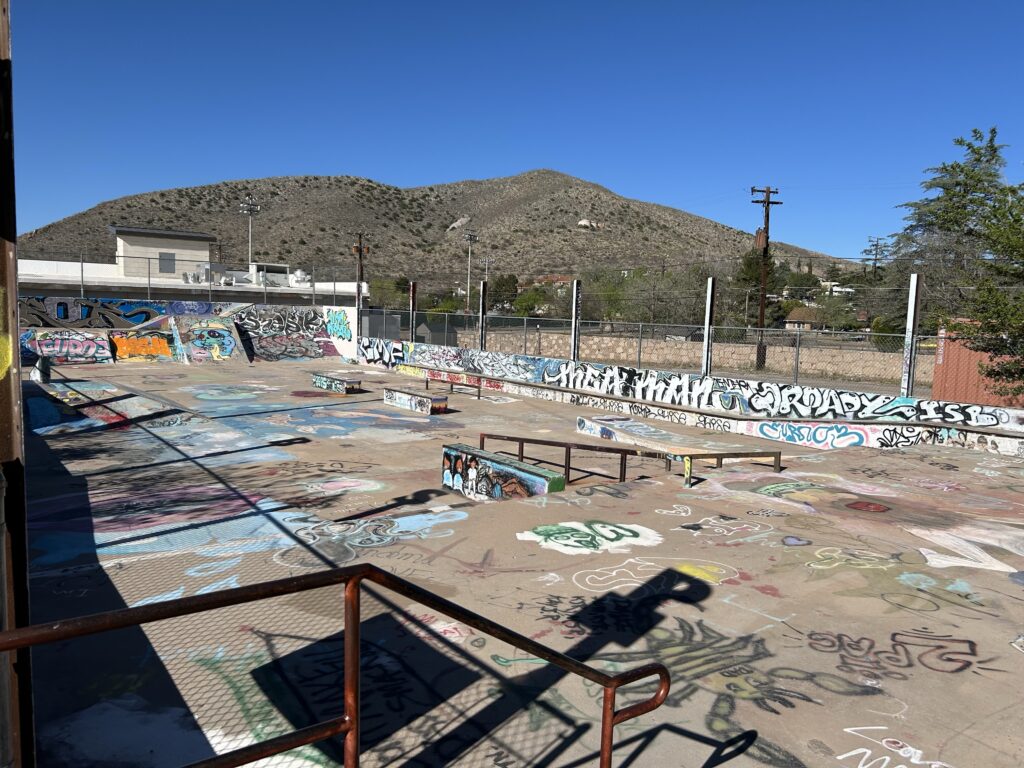
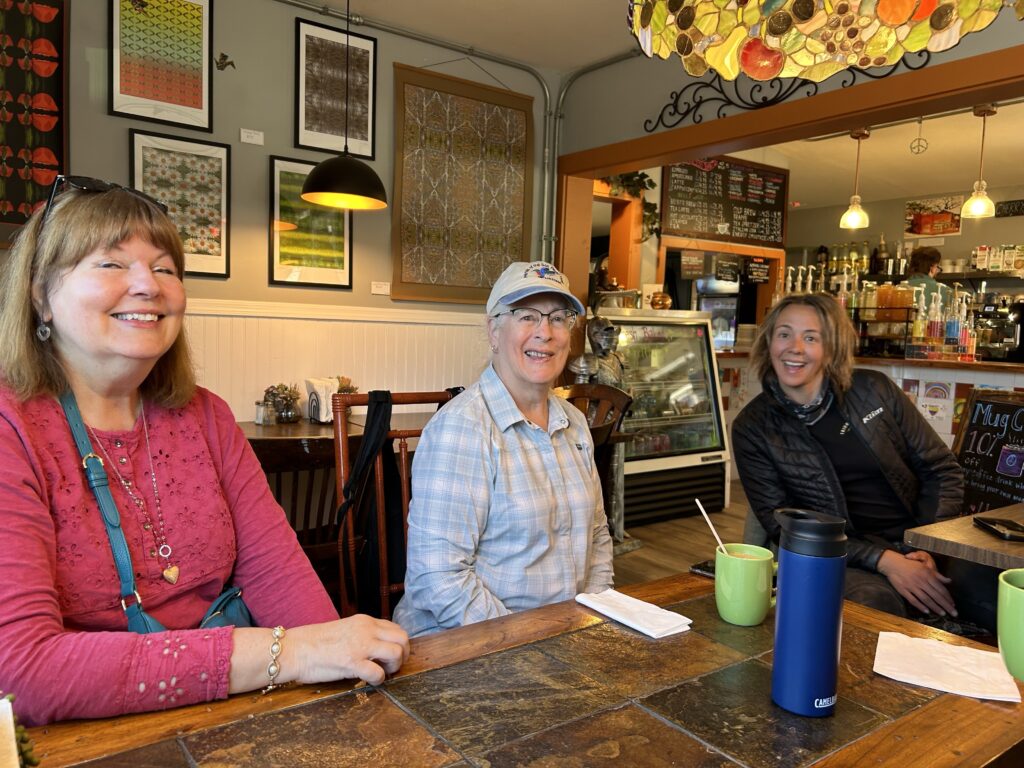
Naco
Based on the search results provided, there are some indications that Bisbee, Arizona has been affected by issues related to undocumented immigrants and potential cartel activity along the border:

- The article about border rancher John Ladd states that his 16,000-acre ranch, which shares a 10-mile border with Mexico, has seen problems with undocumented immigrants crossing onto his property, especially after the border wall construction was halted1.
- The article mentions that the cartel has taken over a major corridor for migrants and smugglers near the border, which has caused issues for Ladd and other ranchers in the area1.
- Another article discusses how U.S. citizens are being lured by drug cartel money to smuggle illegal aliens across the Arizona border, including in the Bisbee area2.
- There are reports from Bisbee residents that they feel “under siege” from increased Border Patrol presence and activity in their town, suggesting an influx of undocumented border crossings3.
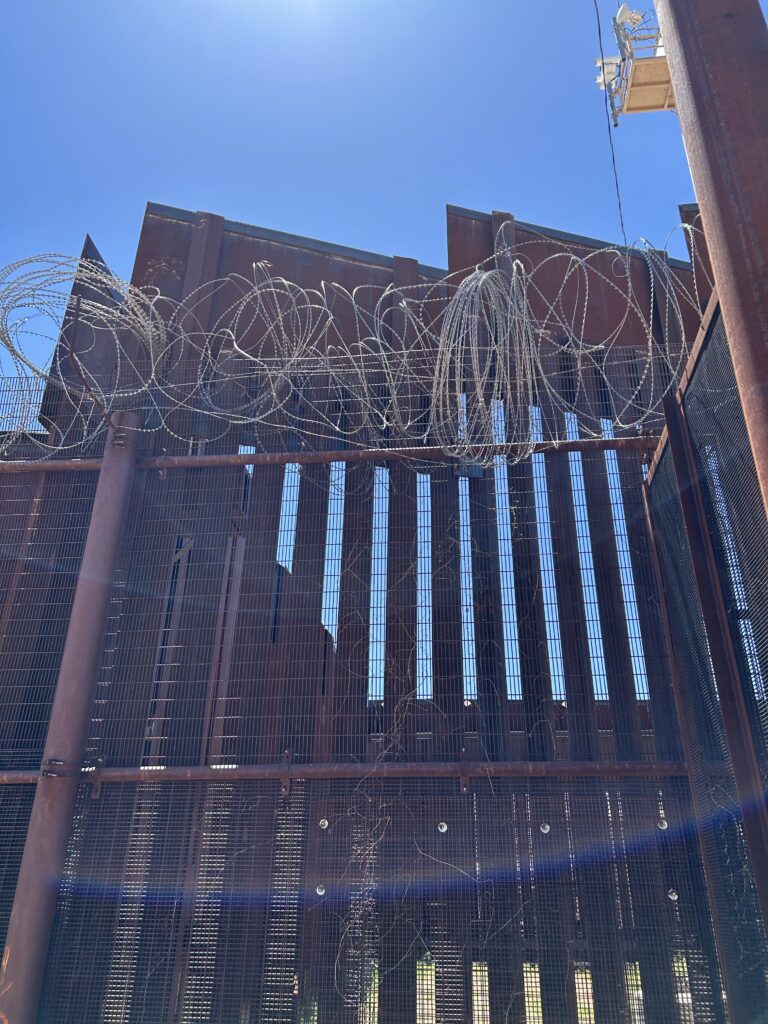
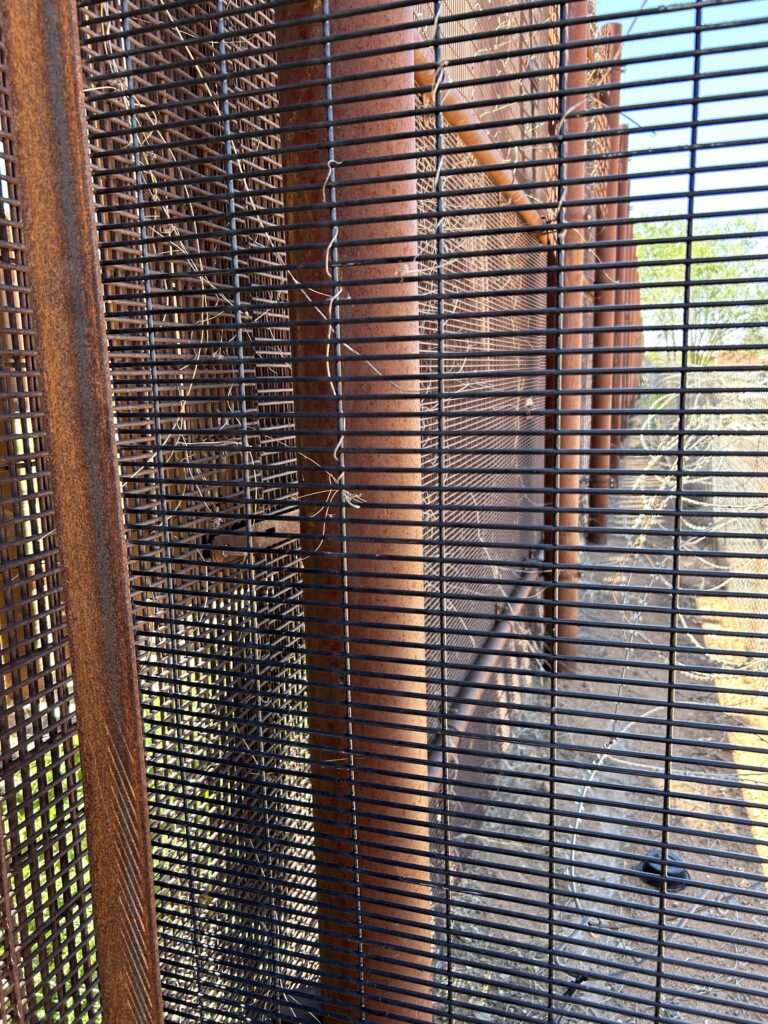
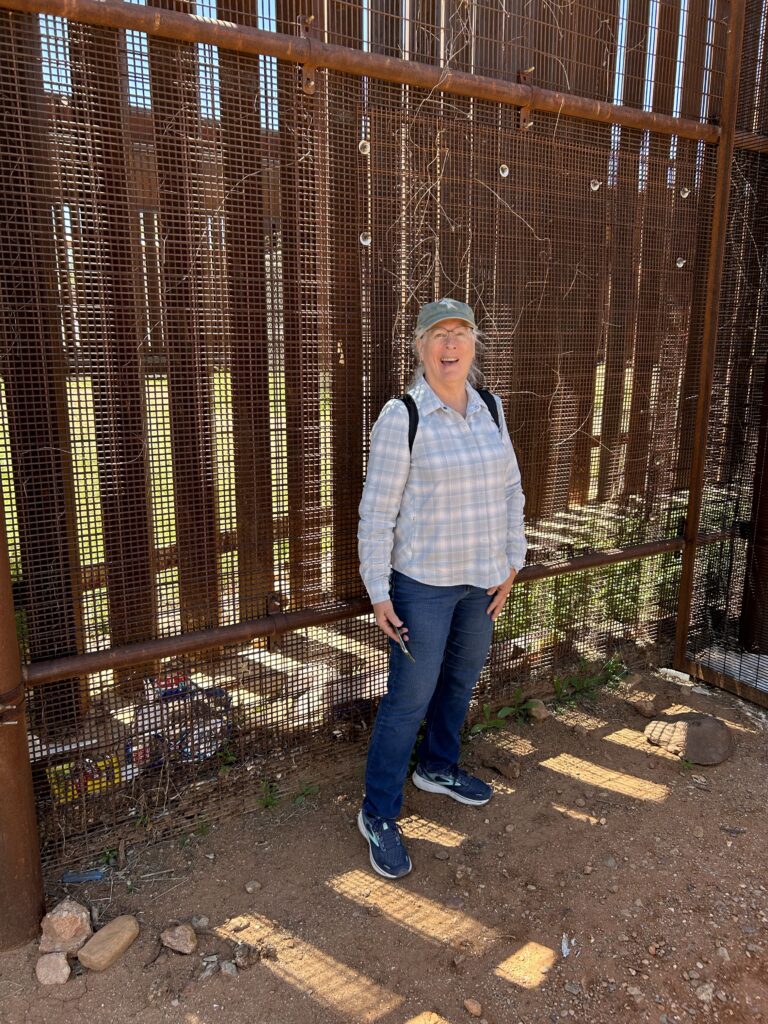
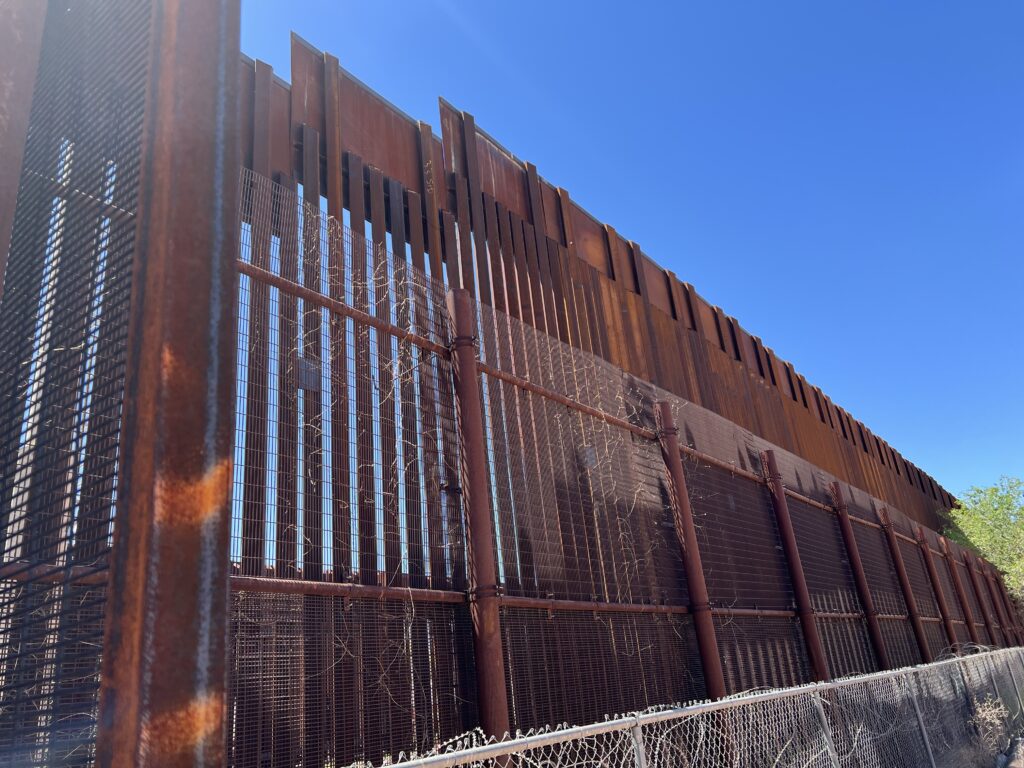
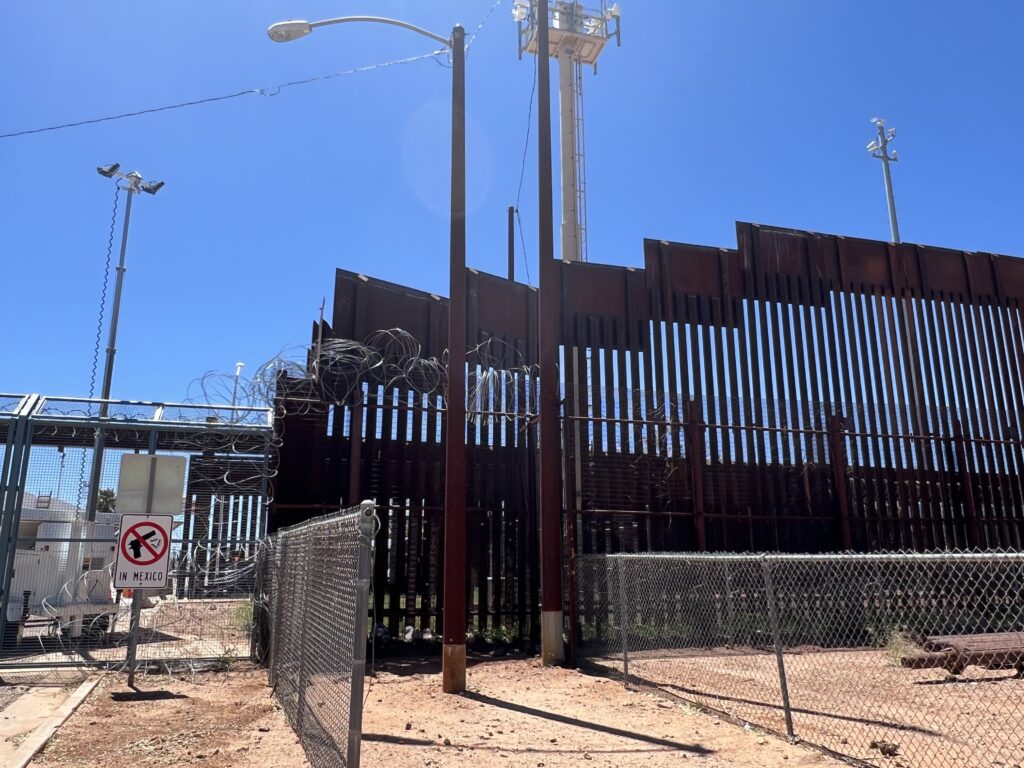
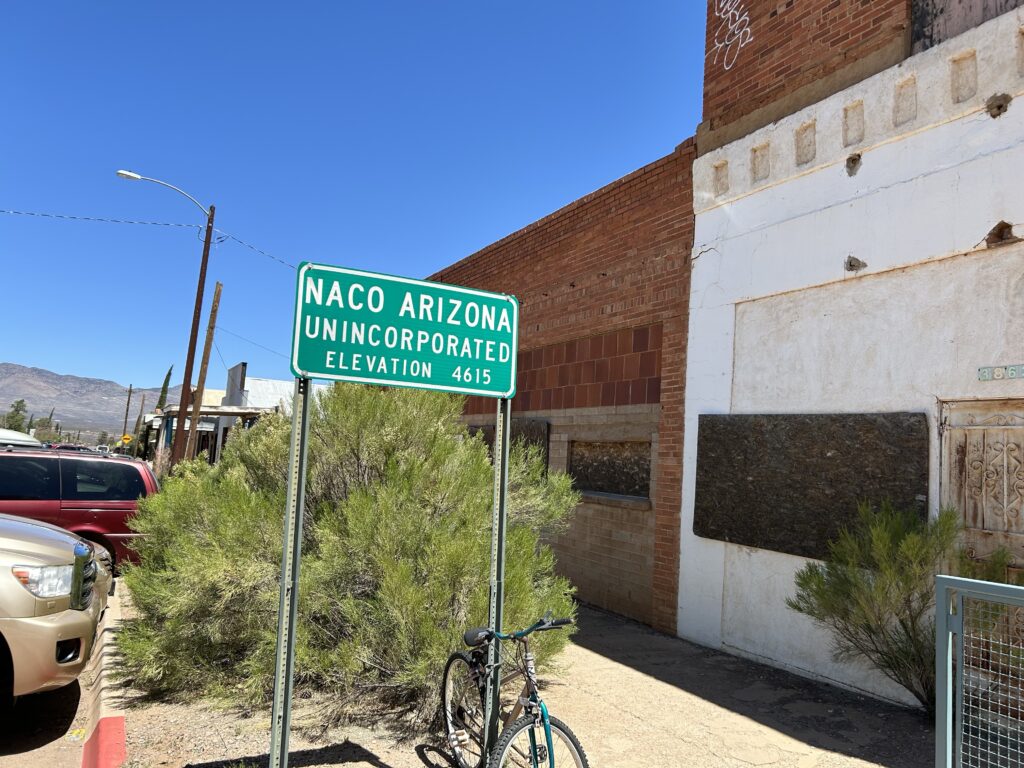
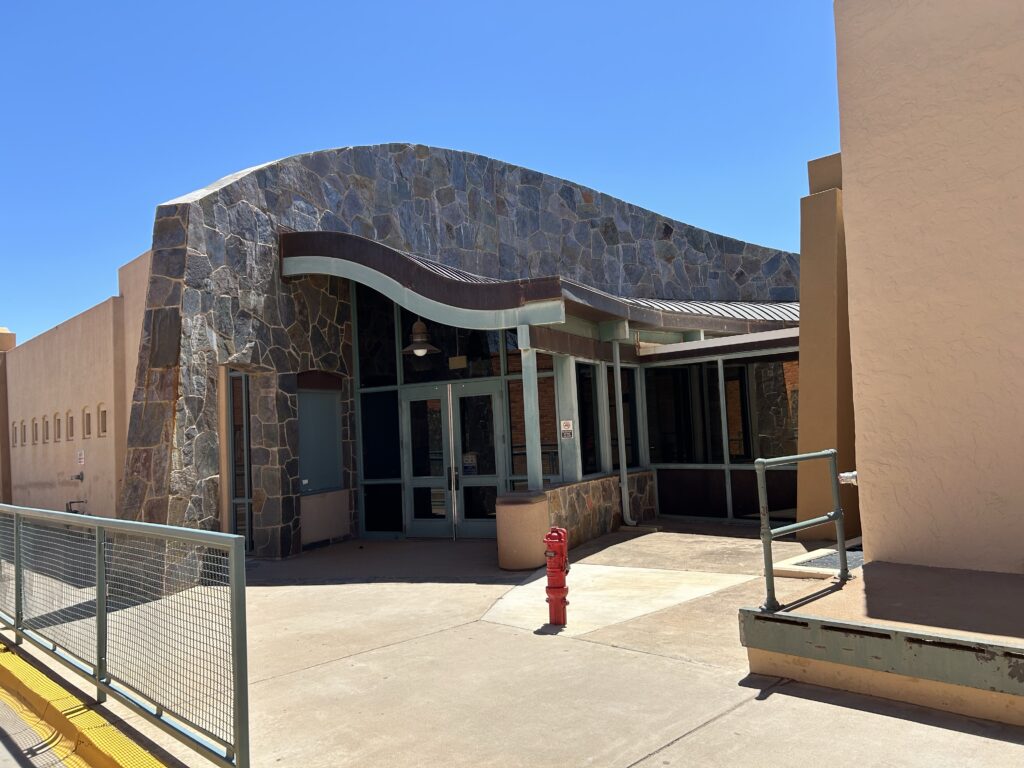
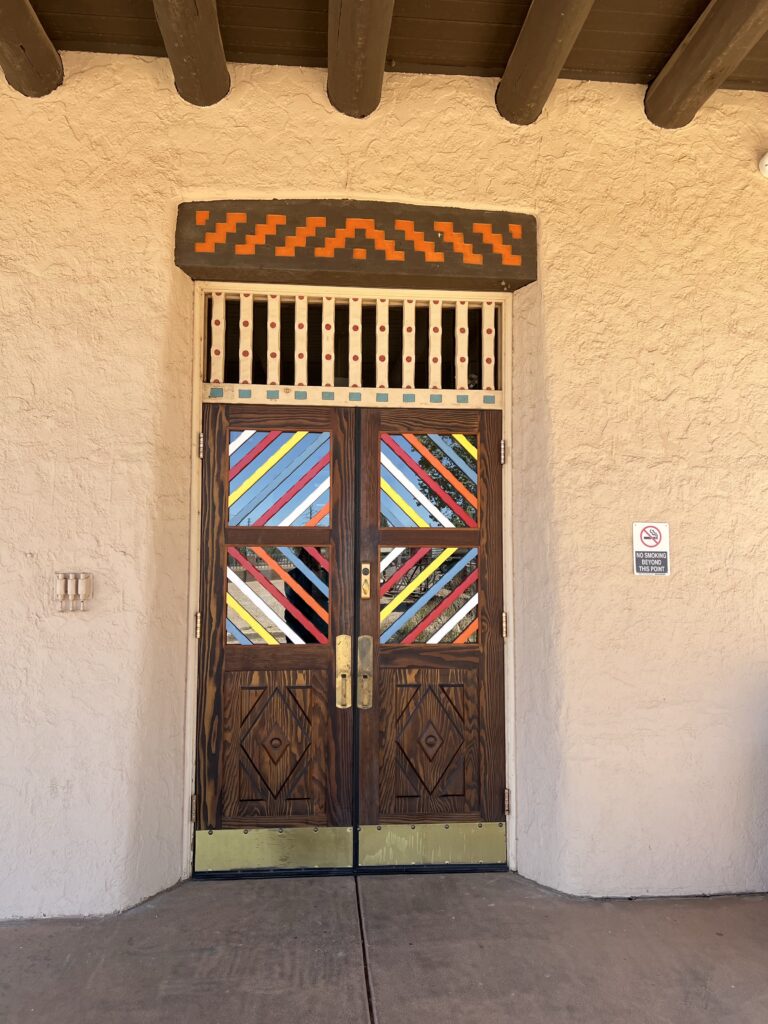
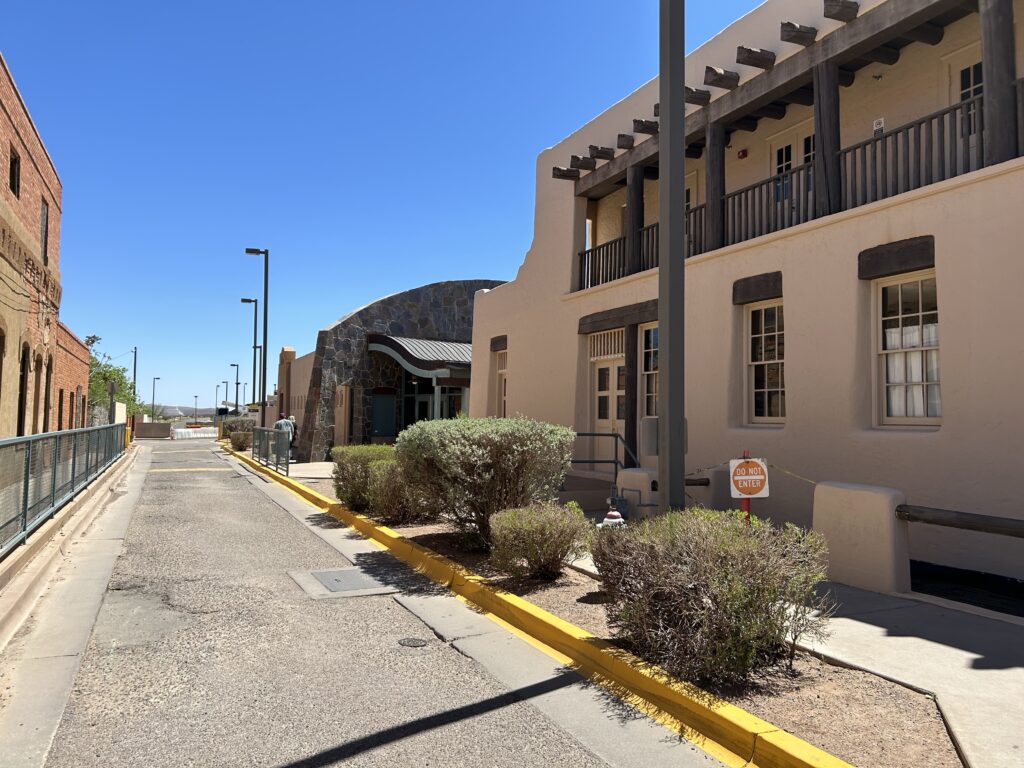
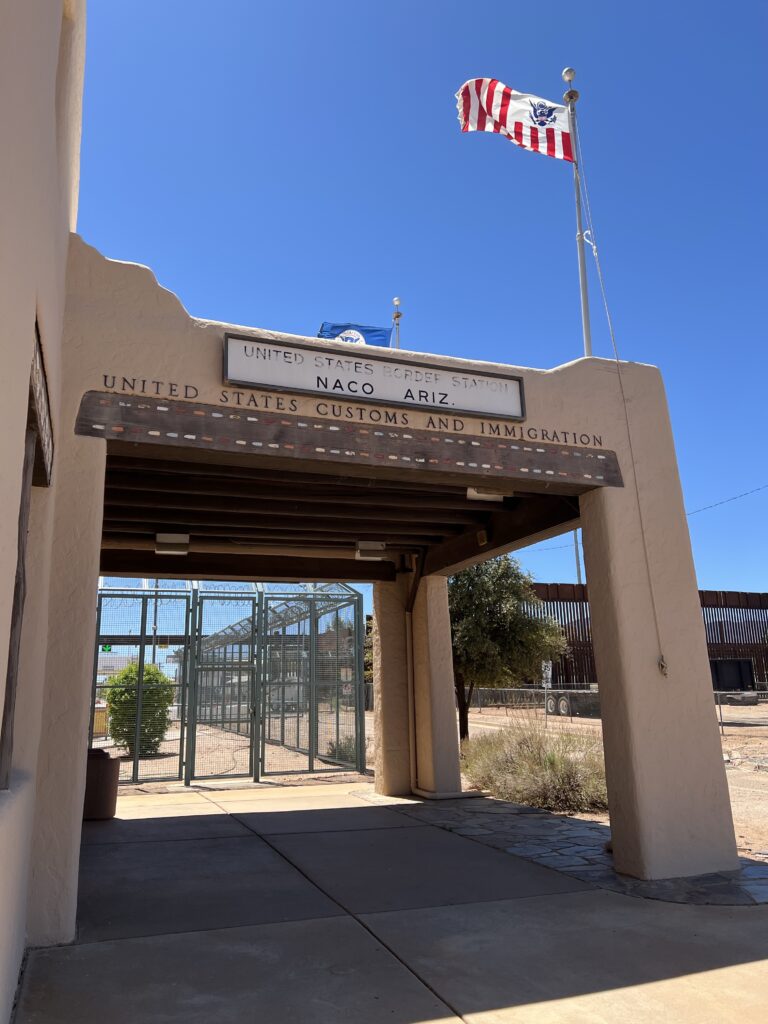
So based on these search results, it does appear that Bisbee has been impacted by issues related to undocumented immigrants and potential cartel activity along the U.S.-Mexico border. The town and surrounding areas seem to be dealing with the effects of this ongoing border security challenge.
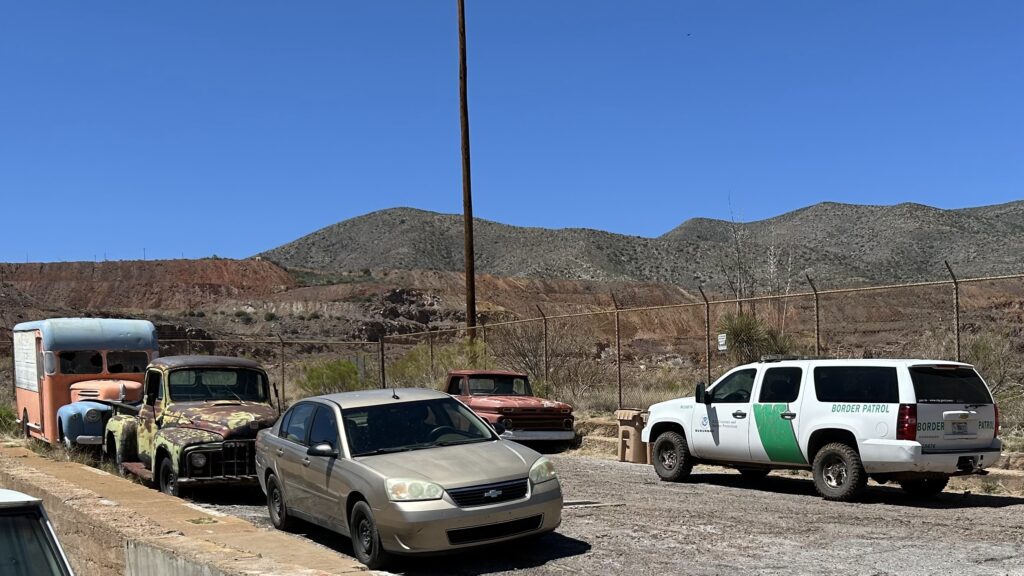
The key points from the search results are:
- A nearby ranch owner has reported problems with undocumented immigrants crossing onto his property, especially after border wall construction was halted.
- There are reports that the drug cartel has taken over a major corridor for migrants and smugglers near the border, which has caused issues for ranchers in the area.
- Some Bisbee residents have expressed feeling “under siege” from increased Border Patrol presence and activity in their town, including high speed chase, suggesting an influx of undocumented border crossings4.
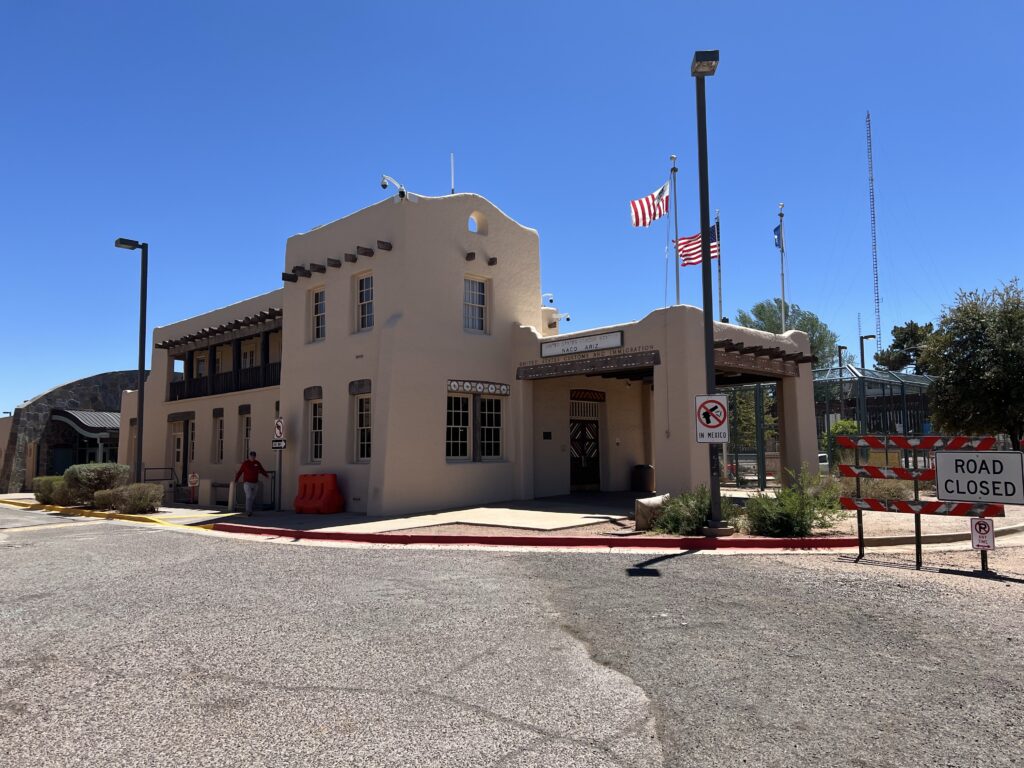
The available information suggests it is more of a regional issue along the border, rather than a problem specifically isolated to Bisbee.
Works Progress Administration
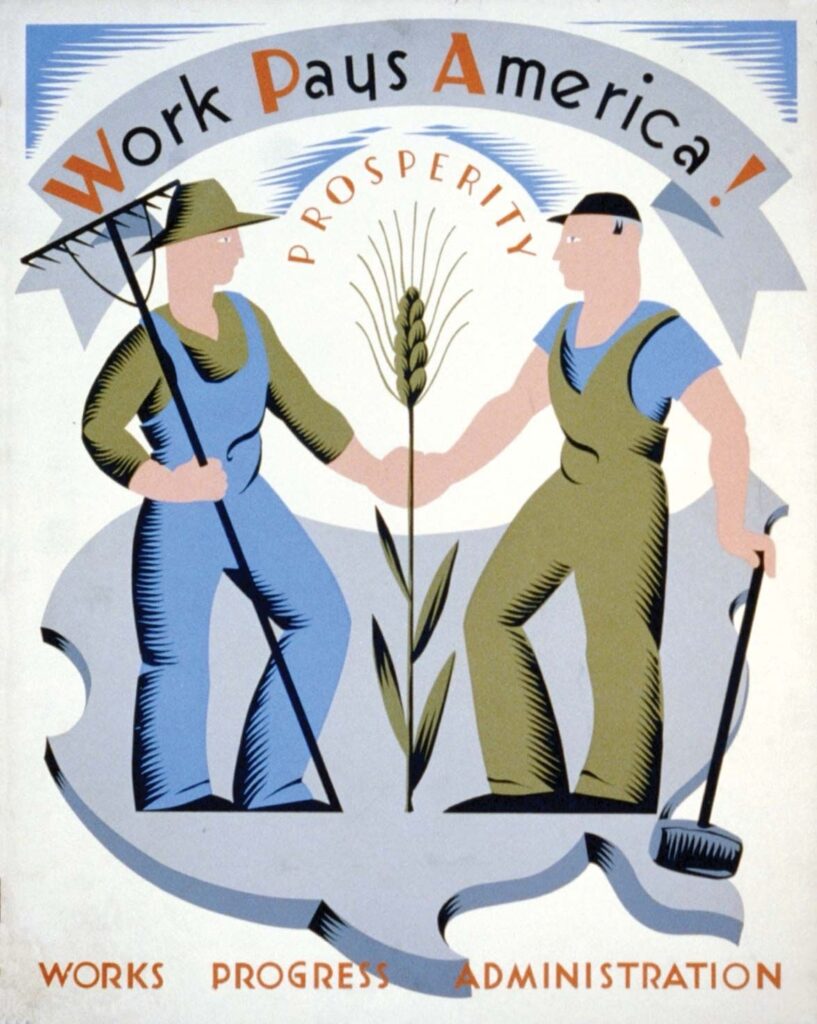
The Works Progress Administration (WPA) was a federal program established in 1935 under President Franklin D. Roosevelt’s New Deal. Its primary goal was to provide jobs for unemployed Americans during the Great Depression. The WPA funded various projects across the United States, including construction of public buildings, roads, bridges, parks, and airports. In Bisbee, the WPA completed several projects:
- Water infrastructure: The WPA funded the expansion of Bisbee’s potable water system, including the construction of new lines and 110 hydrants. This project aimed to bring the city up to code in terms of pressures and provide more stored water above ground3.
- Roads: The WPA constructed over 620,000 miles (1,000,000 km) of streets and over 10,000 bridges nationwide4.
- Public buildings: The WPA employed artists, writers, and actors to create art work for public buildings, document local life, and organize community theatres2.
- Stairways: The WPA replaced wooden steps with concrete steps in Bisbee, which can still be seen today6.
- Other projects: The WPA also funded projects in areas such as education, training, and recreation5.
These projects contributed significantly to the development and infrastructure of Bisbee during the Great Depression.

Coronado National Memorial
Coronado National Memorial is a national park unit located along the US-Mexican border in southeast Arizona. It was established by Congress as an international memorial in 1941 and designated a national memorial in 1952.
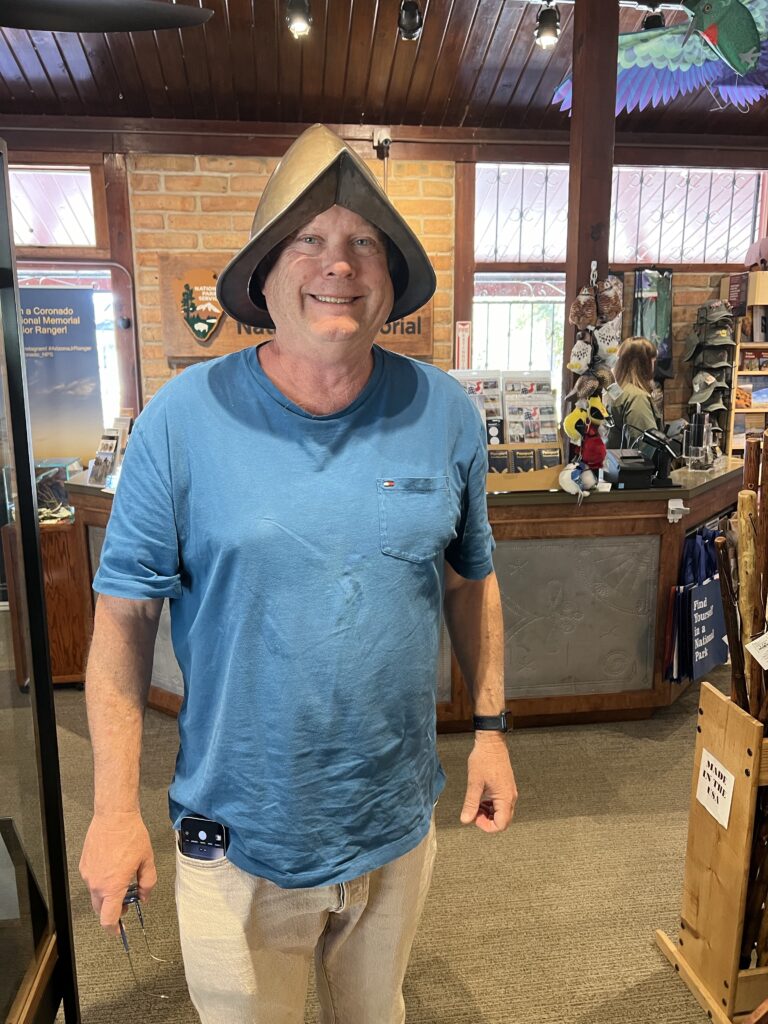
The park commemorates Francisco Vásquez de Coronado’s expedition throughout the American Southwest during 1540–1542 and preserves the natural and human history of the border region.
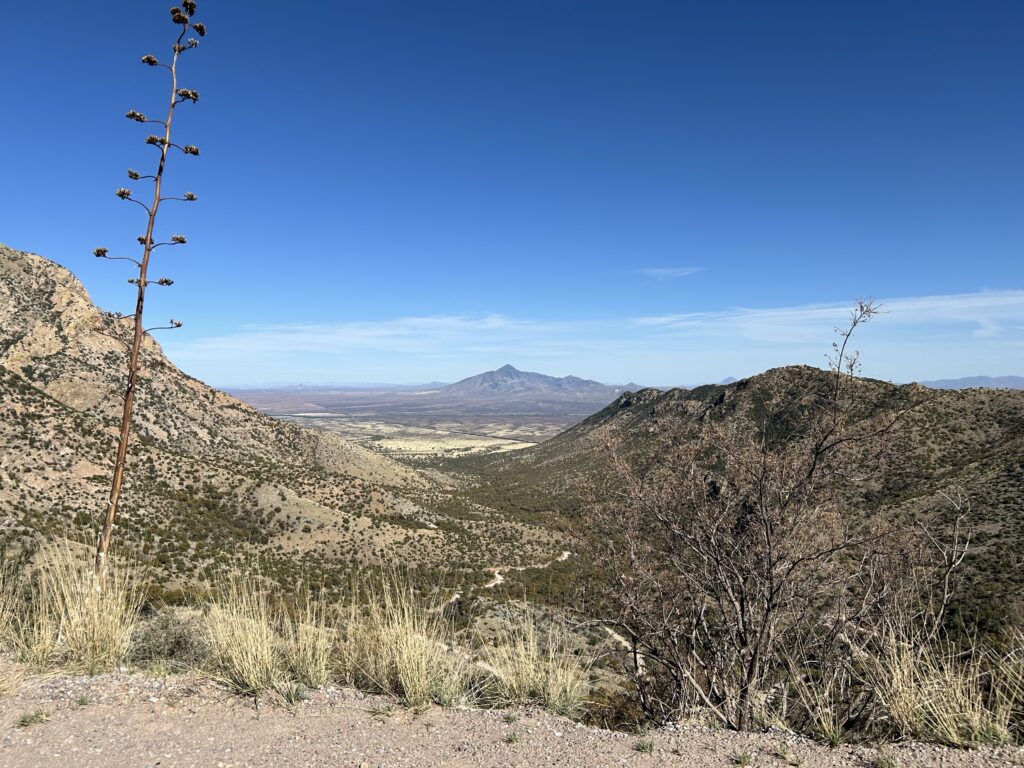
The memorial encompasses 4,750 acres of land within the Huachuca Mountains and the San Pedro River Valley and shares 3.3 miles of its boundary with Mexico.
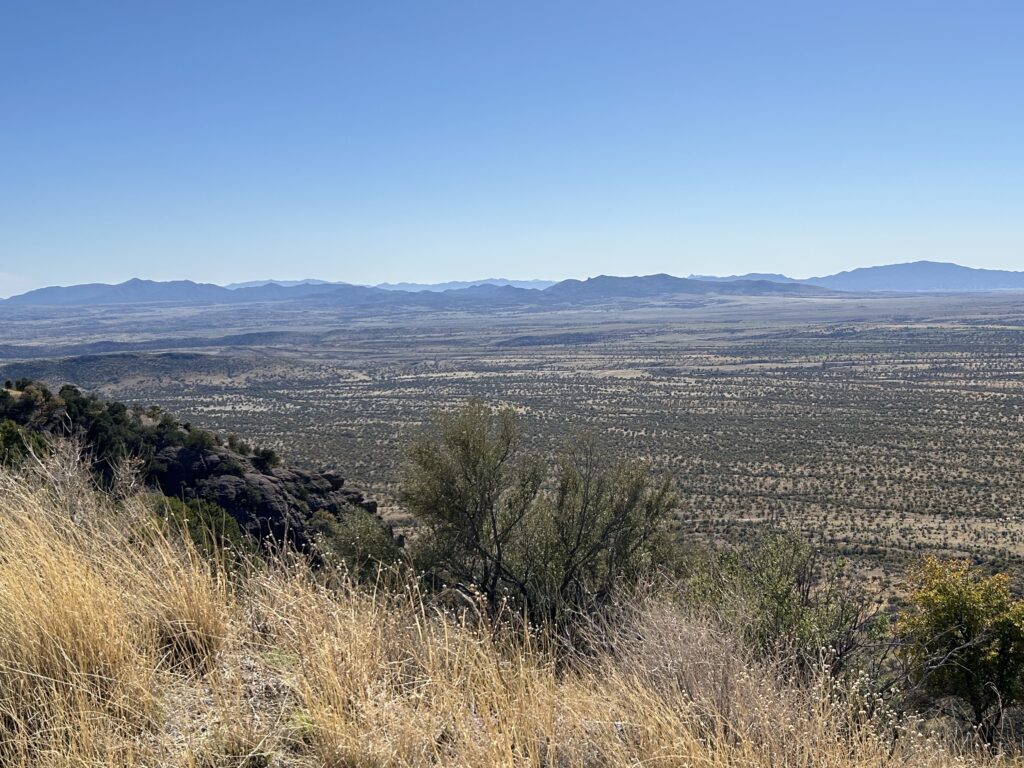
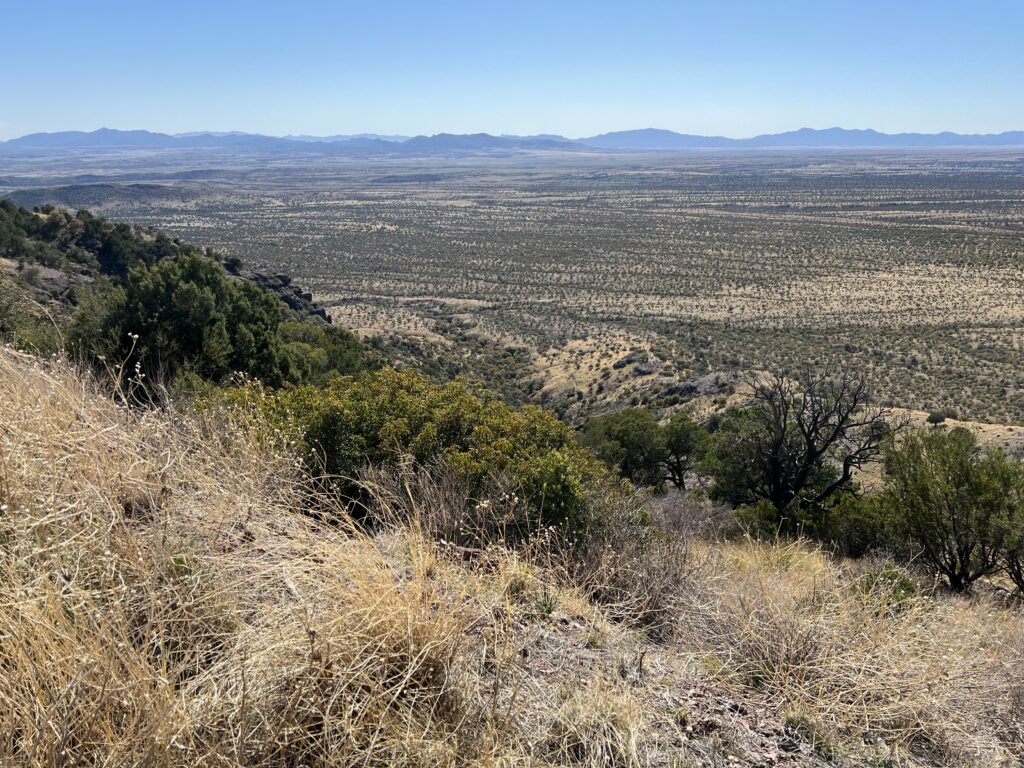
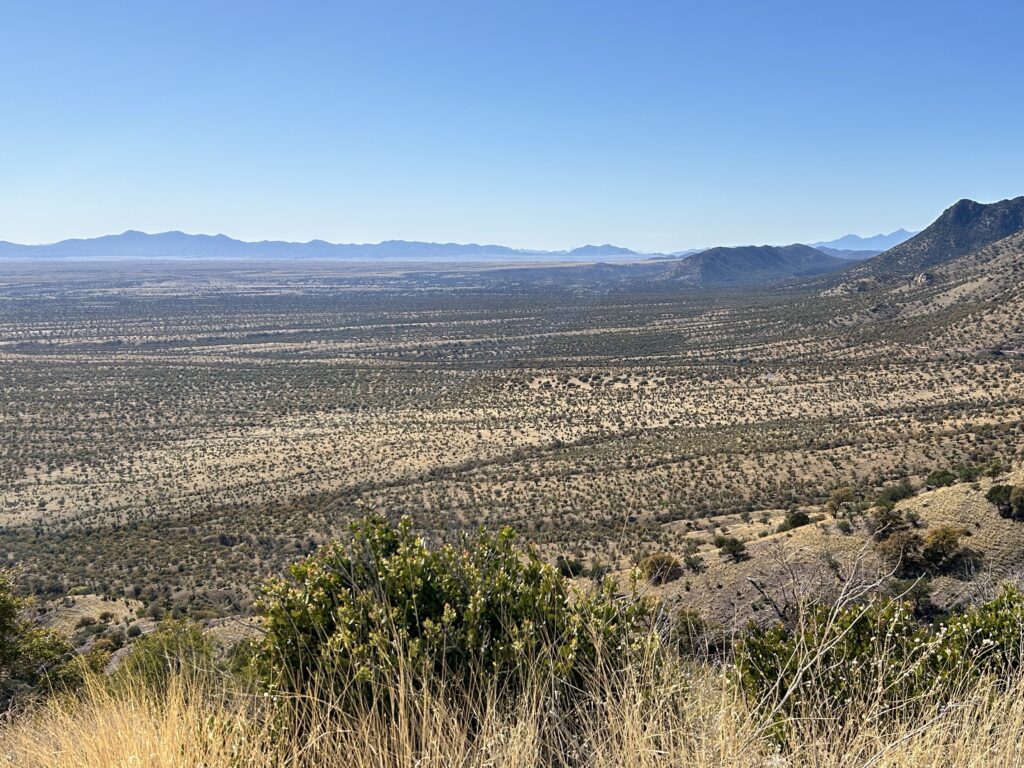
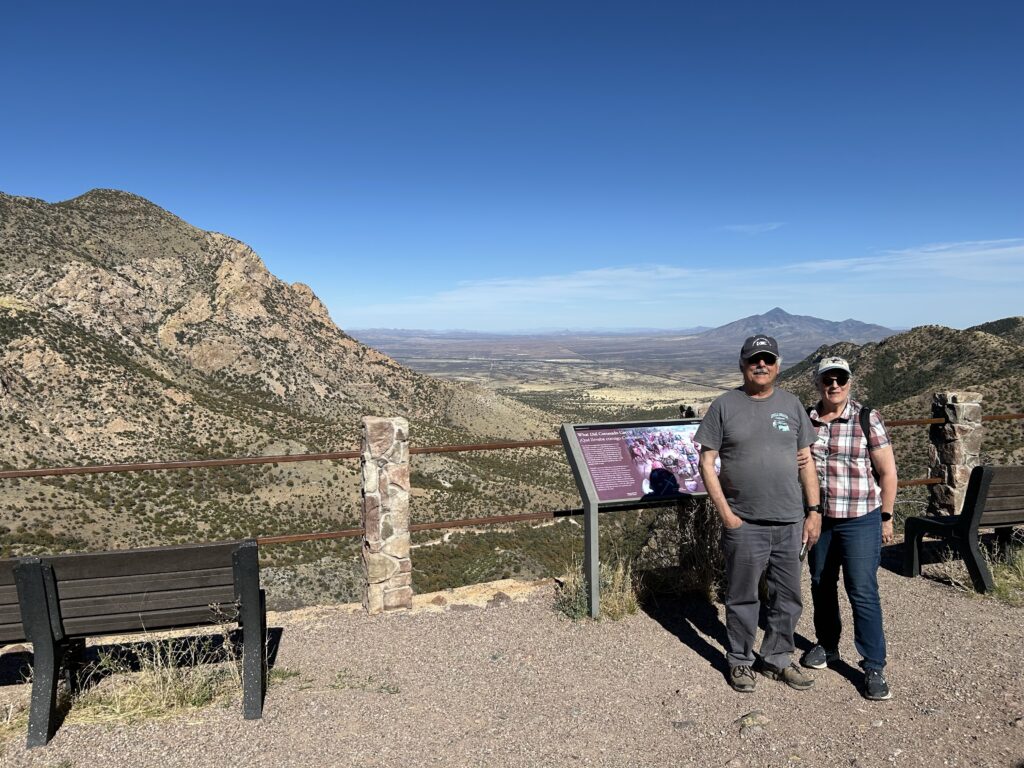
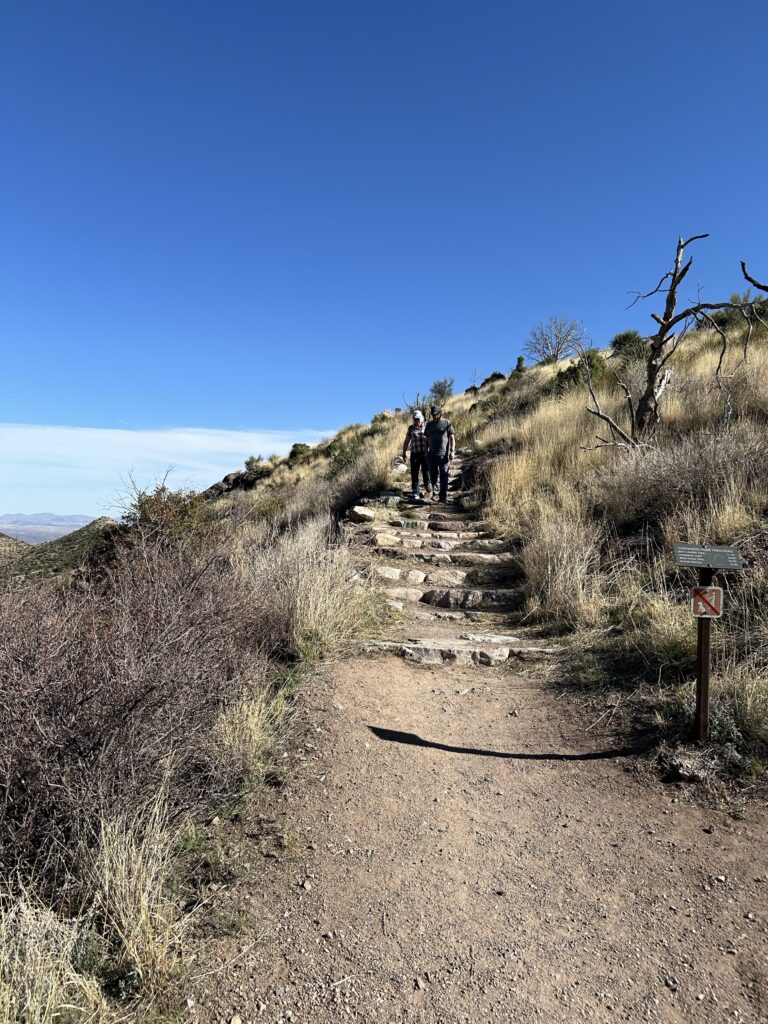
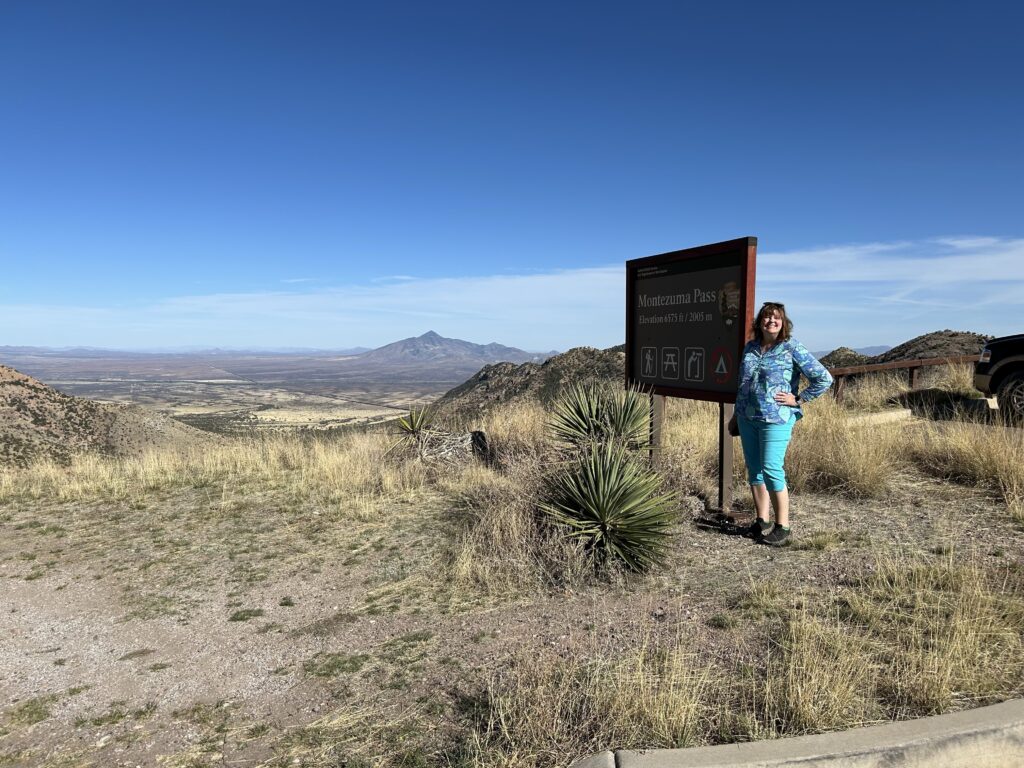
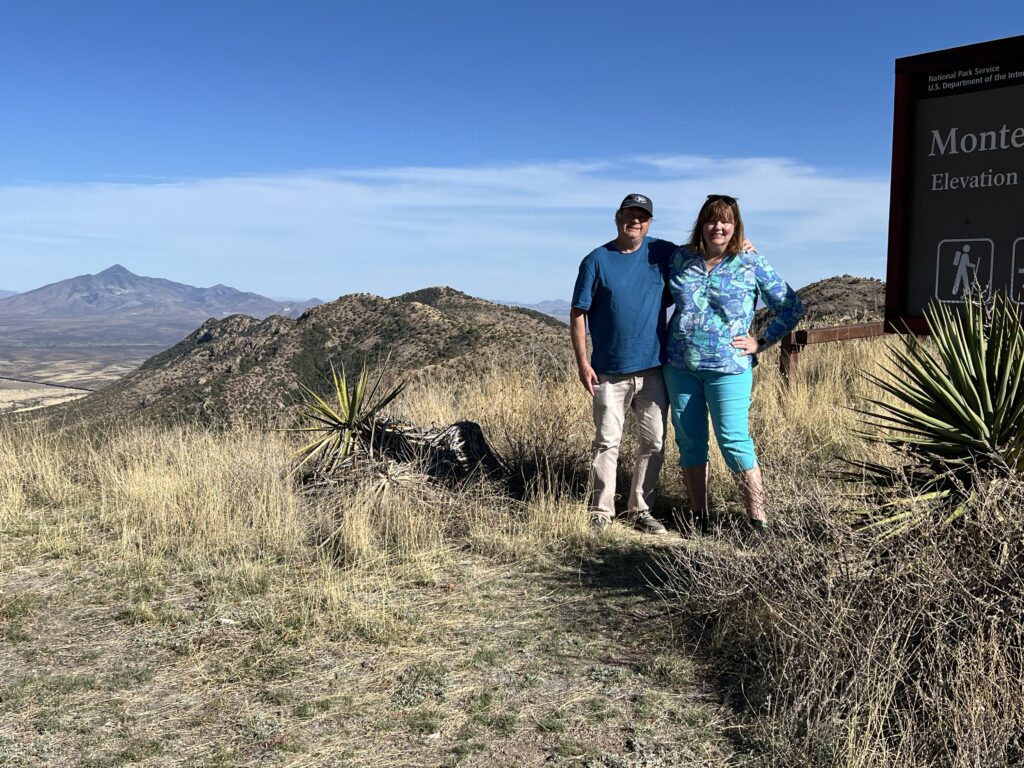
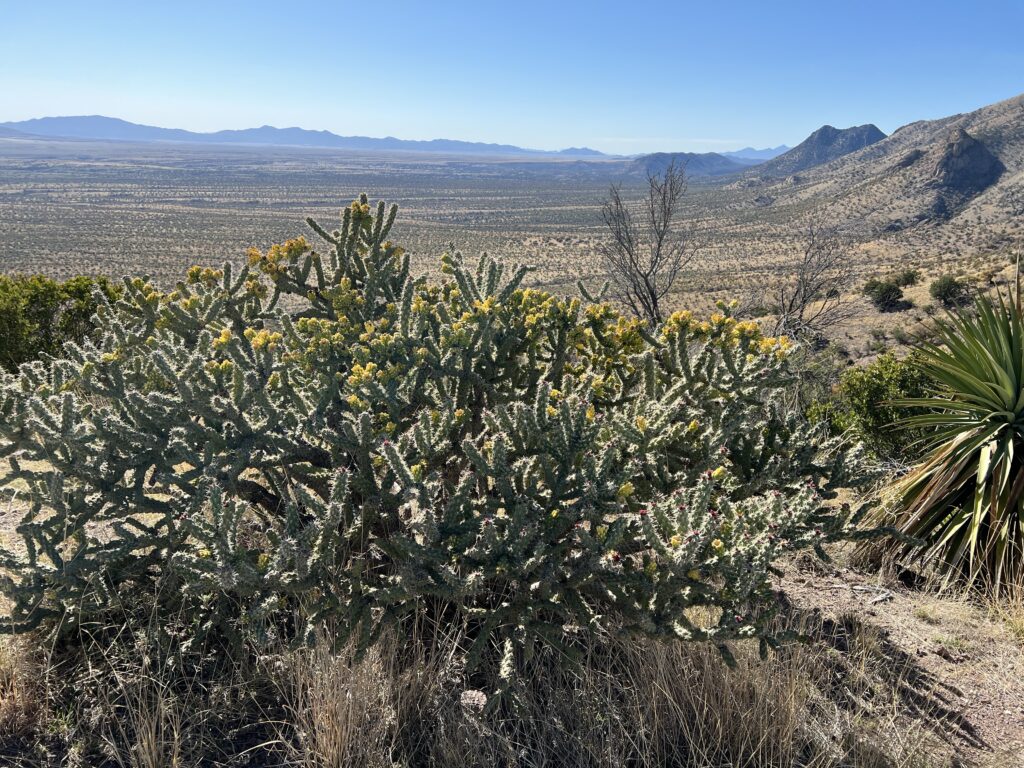
The site offers visitors panoramic views of the border region, including Montezuma Canyon, the Huachuca Mountain Range, the San Pedro River Valley, and more distant areas. It serves as a place to reflect upon the lasting impacts of the Coronado Entrada and the bi-national amity and bonds that continue to link the United States and Mexico.
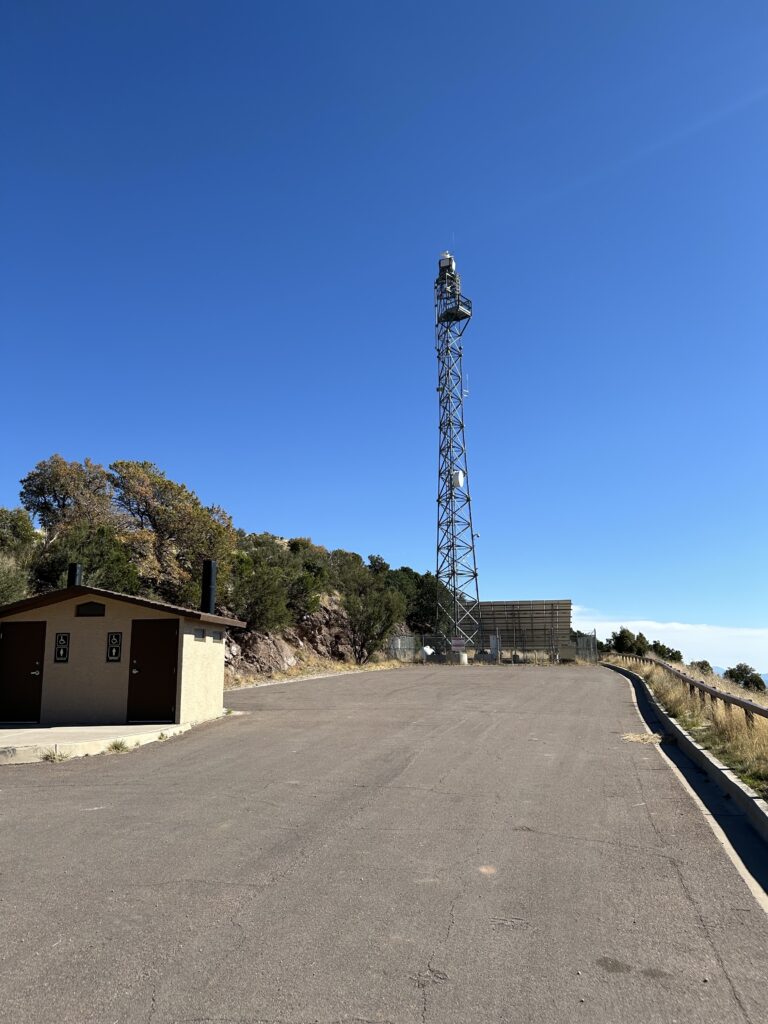
Visitors can enjoy scenic drives, hiking trails, including the Coronado Peak Trail and the southern terminus of the Arizona National Scenic Trail, and visit Coronado Cave. The memorial is managed as part of the NPS Southeast Arizona Group (SEAZ), which also includes Chiricahua National Monument and Fort Bowie National Historic Site1.
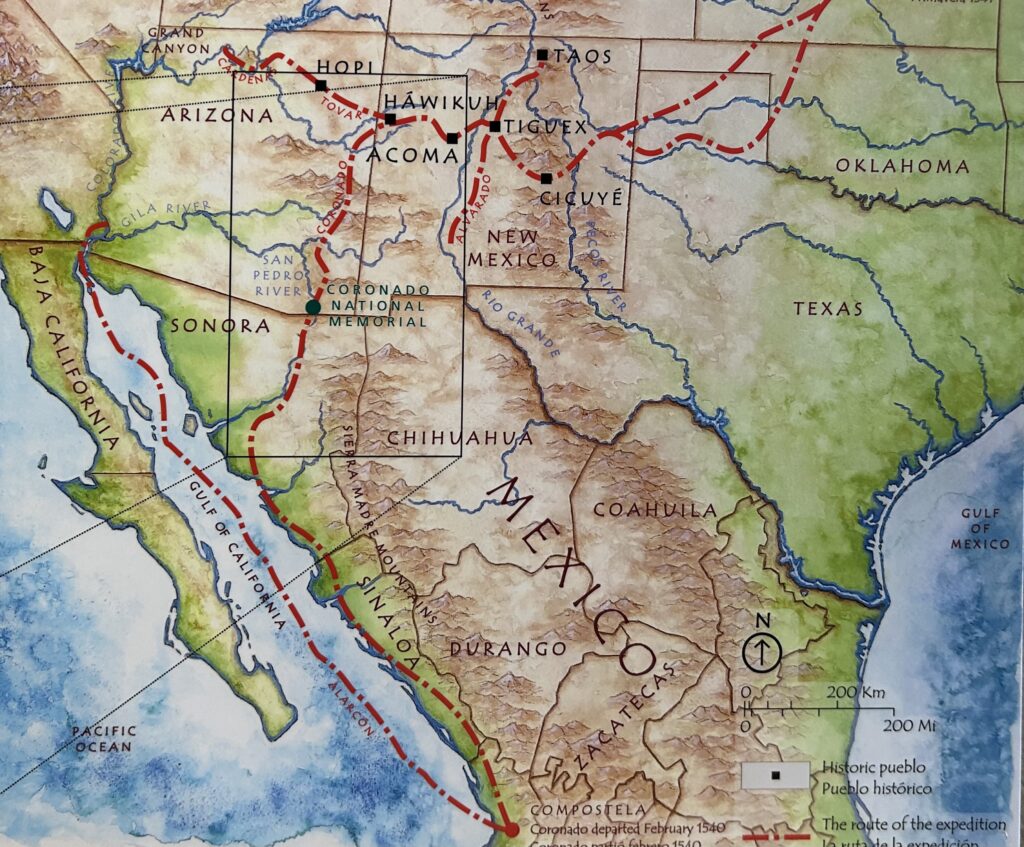
INDIAN ALLIES FROM CENTRAL MEXICO, 12
DOGS, 4,000 CATTLE, SHEEP, GOATS
We know exactly how many Europeans came on the expedition. The Viceroy of New Spain required a detailed list, called a “muster roll,” of all Europeans who joined. The list also recorded what cach soldier brought with him.
Official records tell us little about the hundreds of others that marched alongside the soldiers.
They were guides, servants, cooks, family members— and slaves.
Think of this assemblage as an armed, moveable village, snaking its way through mountain passes and river valleys. Bach person played a part in the success— or failure—of the mission.
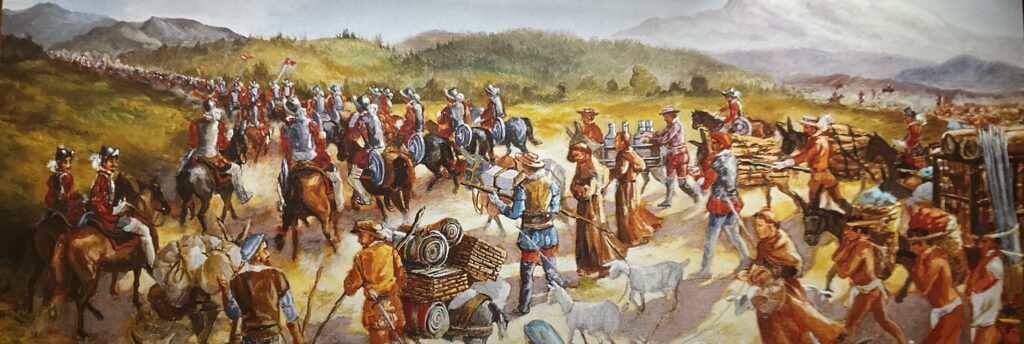
In just over 30 years, the land changed hands twice: from the Spanish Empire to the Republic of Mexico in 1821, and then to the United States in 1853.
In fact, since the Coronado expedition in 1540, the many cultures that live in this region have been in constant contact.
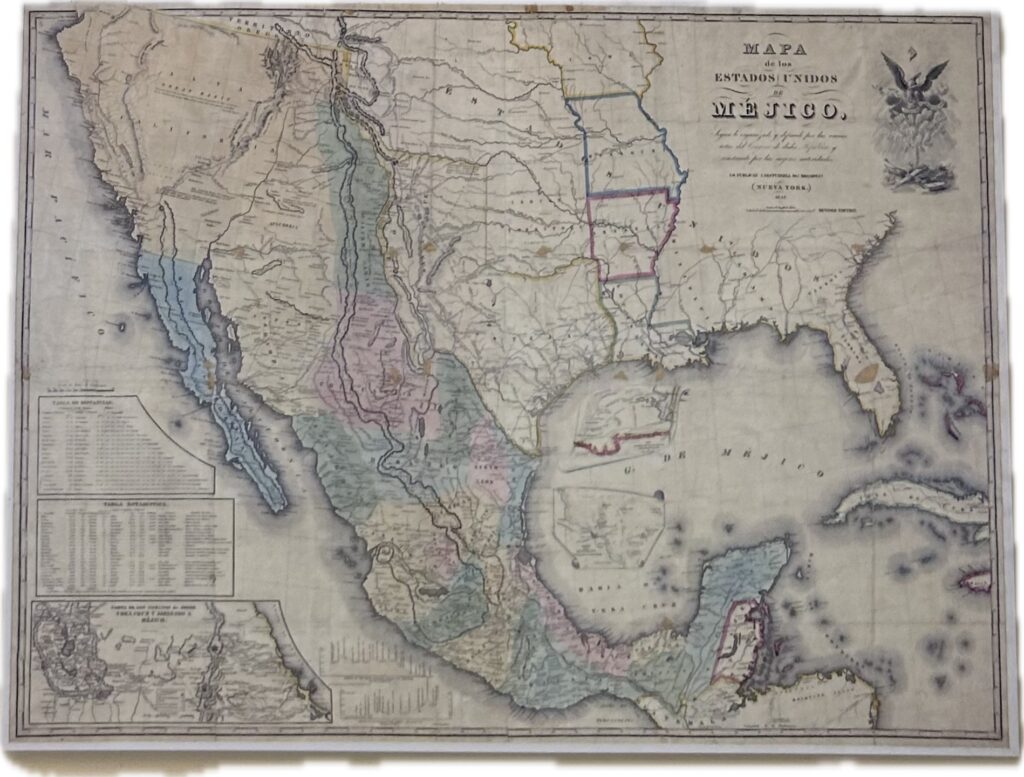
While that contact has sometimes led to conflict and tension, the peoples of the United States and Mexico also share many things. Explore the other exhibits to find out about some of the foods, traditions, and celebrations shared along this international border.
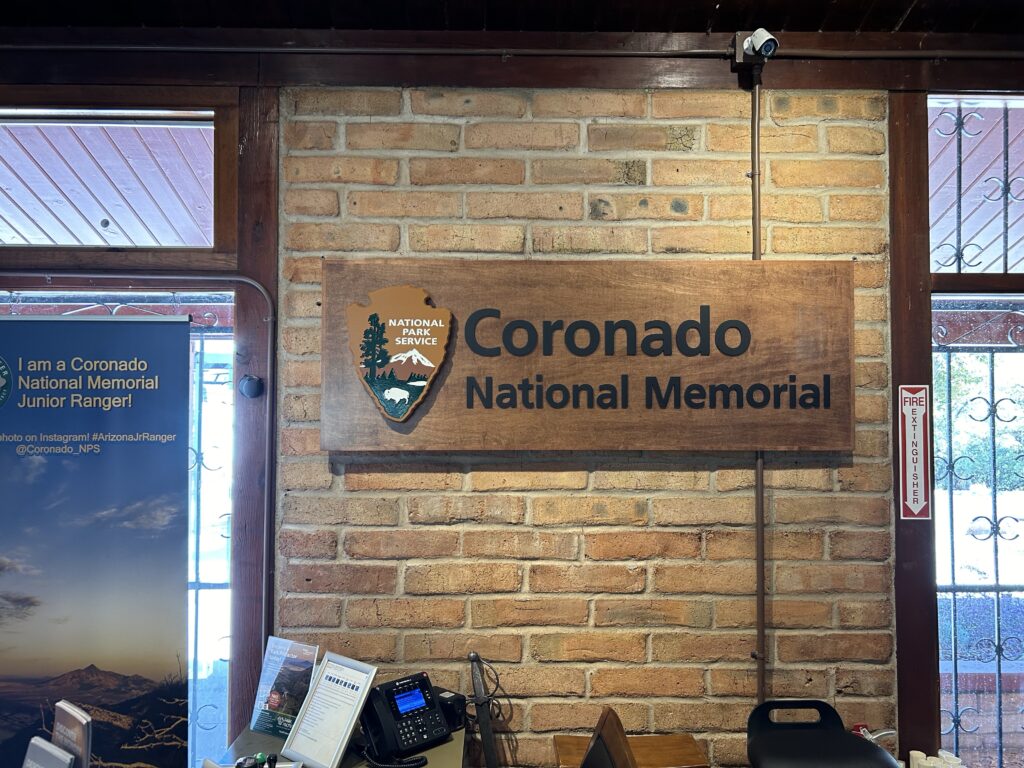
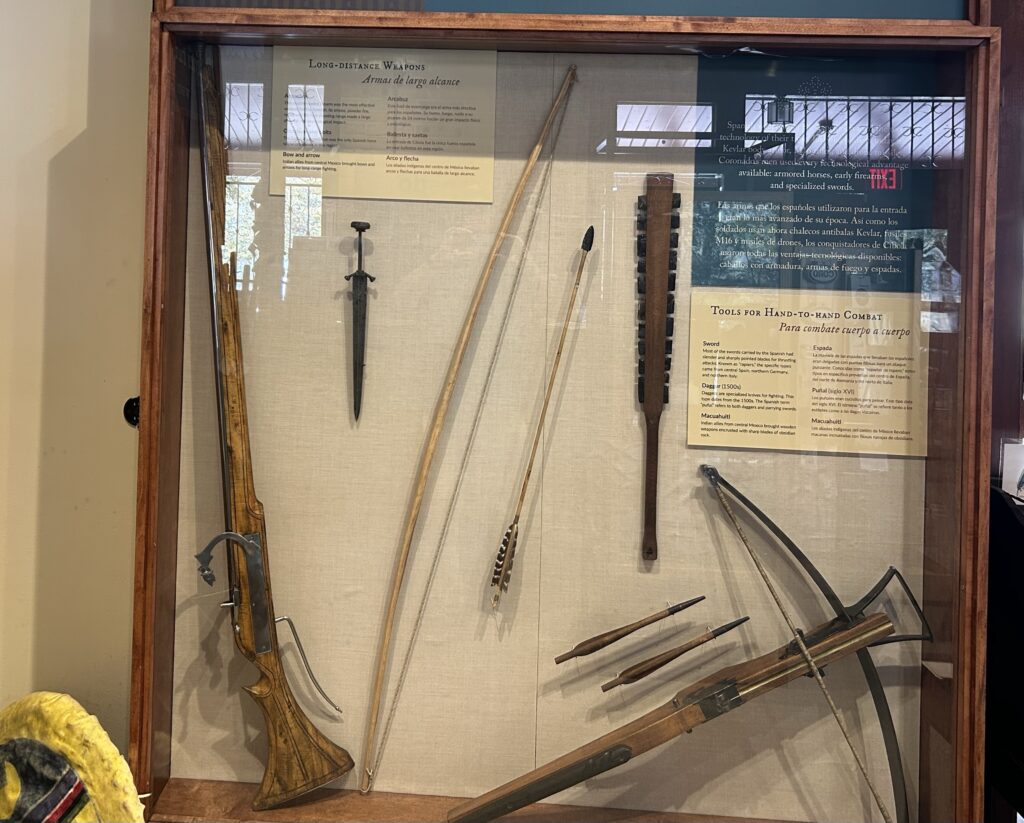
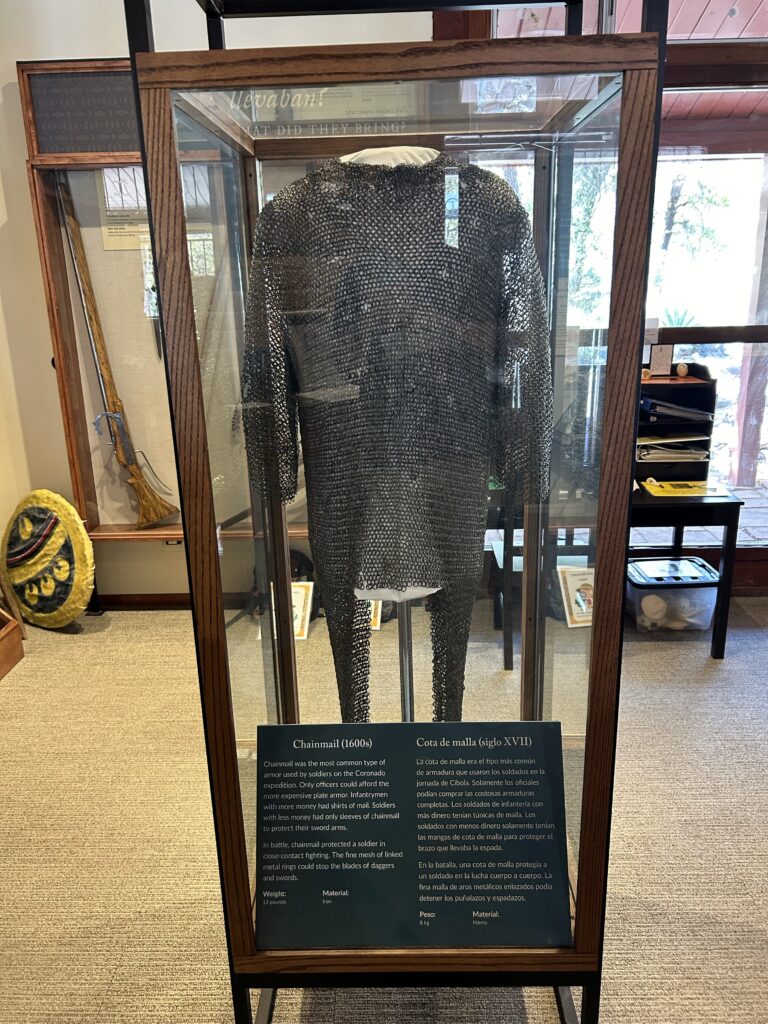
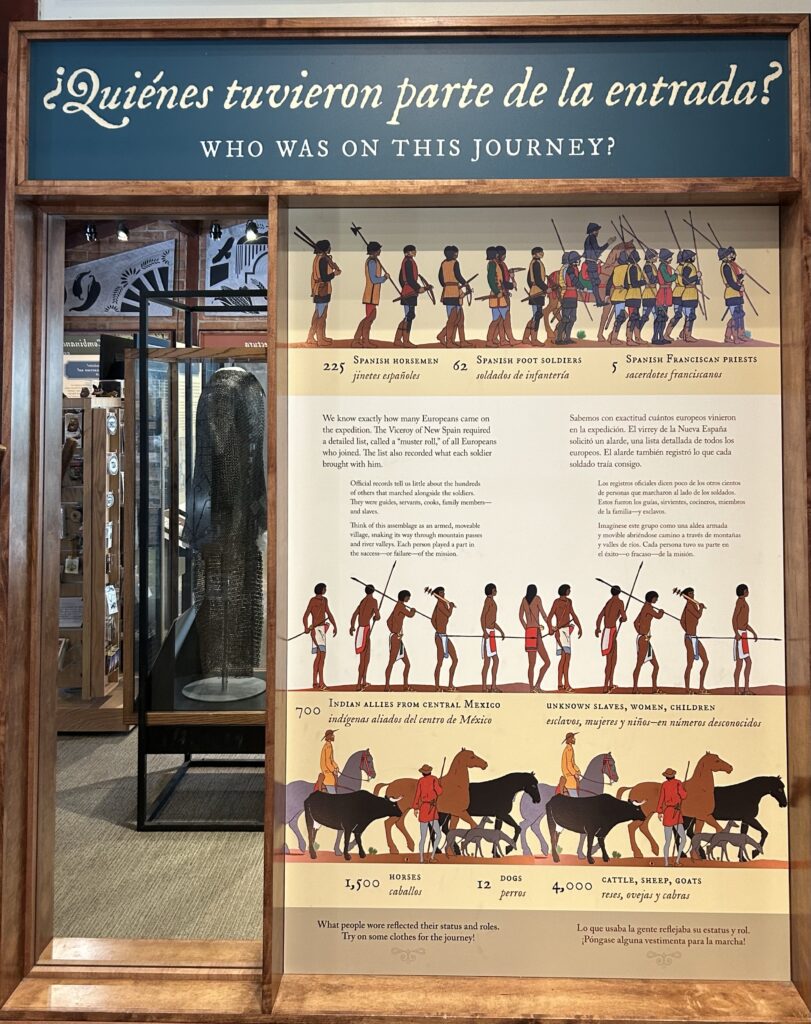
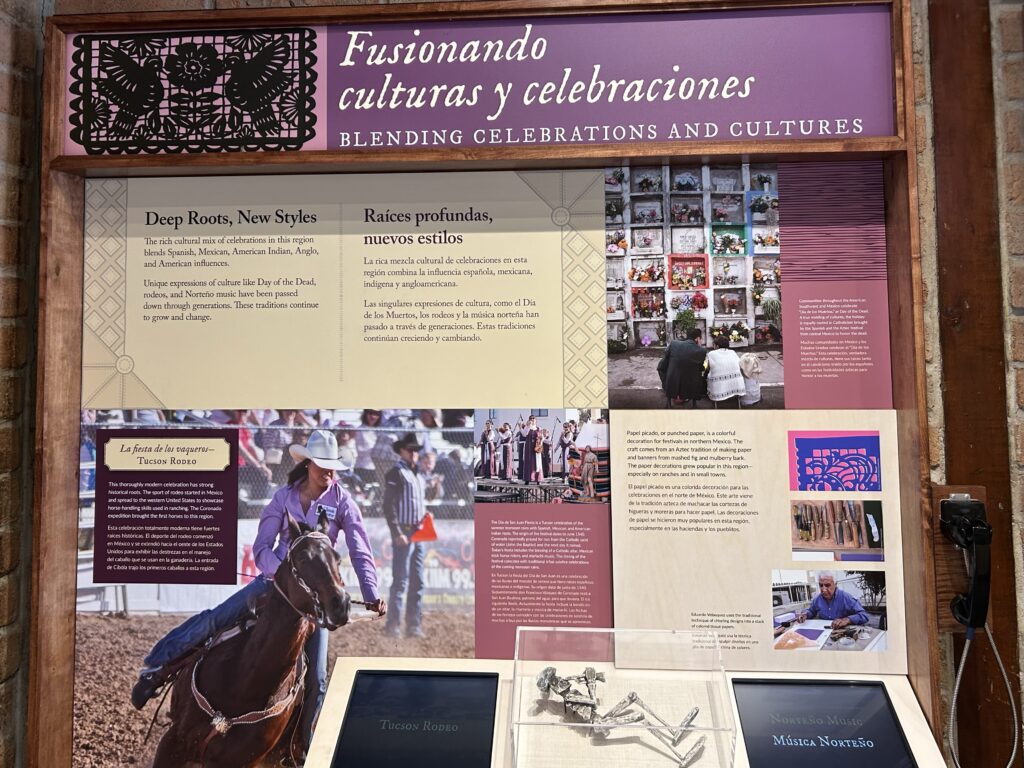
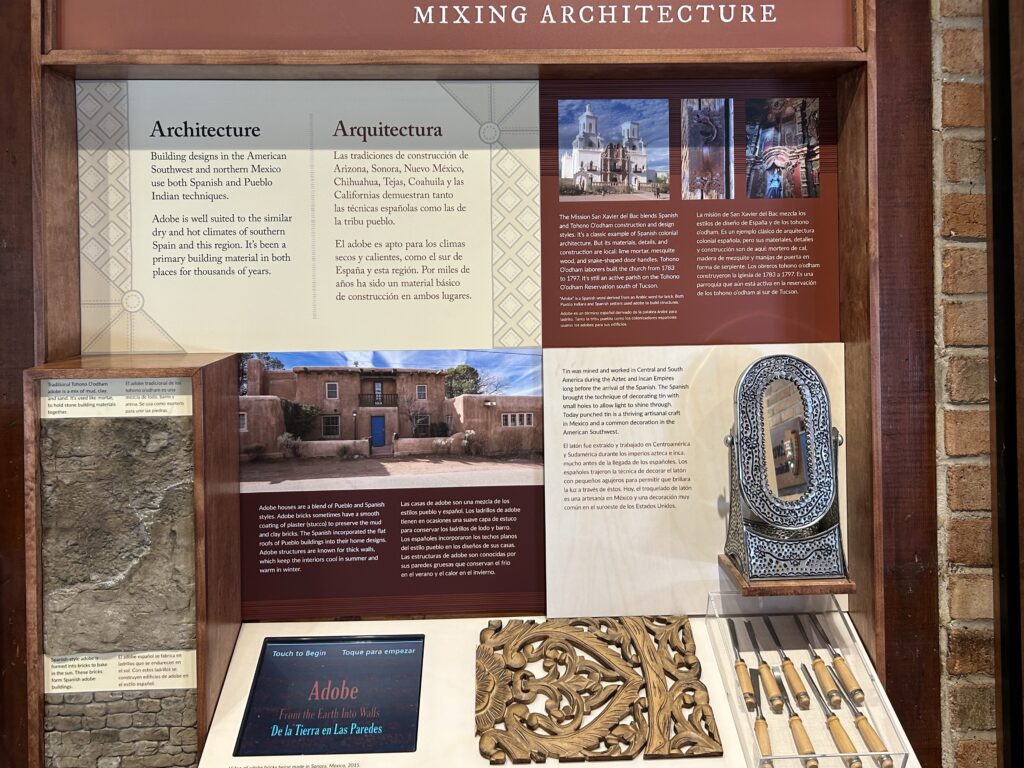
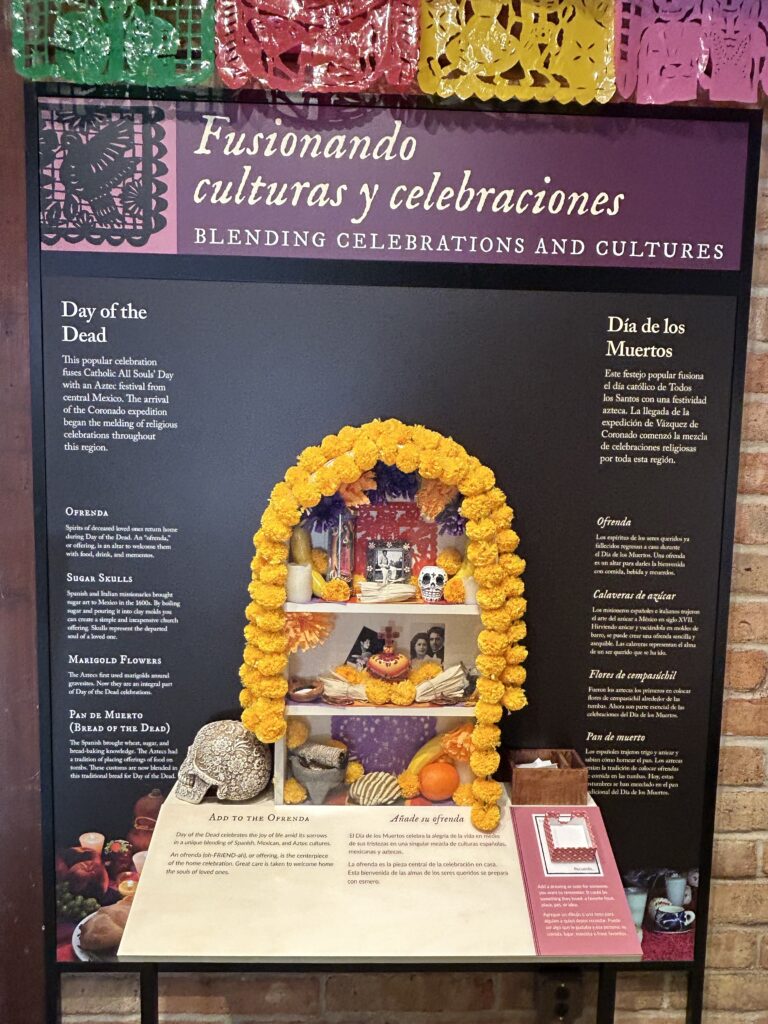
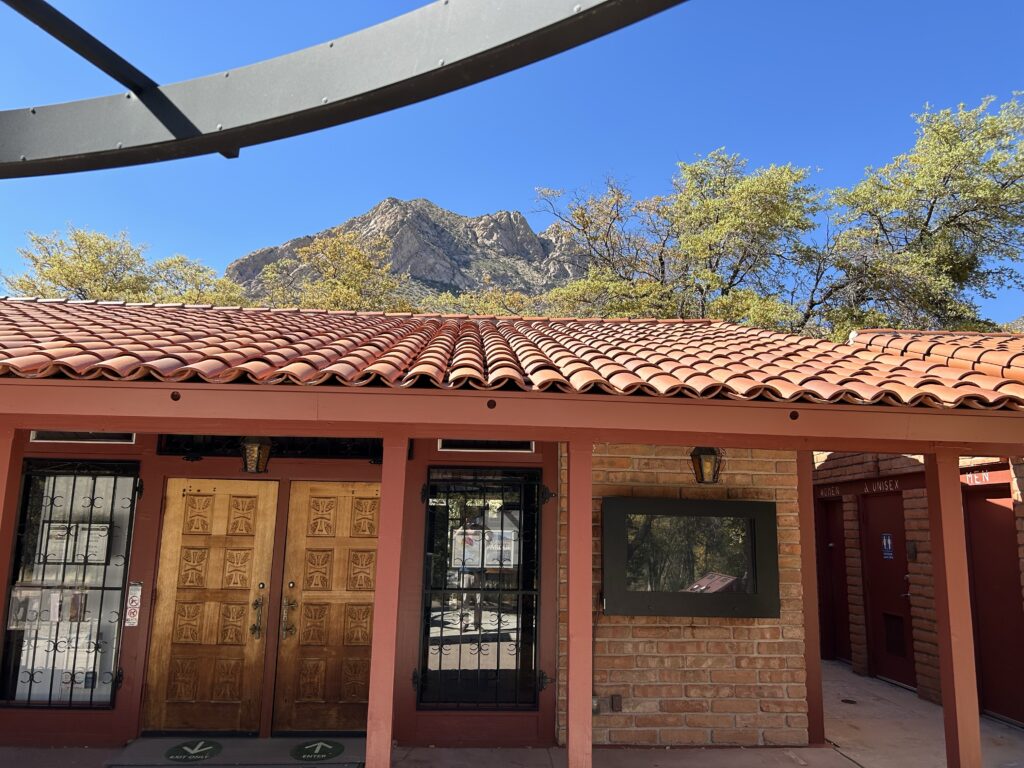
Early in the 1500s Spain established a colonial empire in the Americas. Gold from Peru to Mexico (New Spain) poured into Spain’s treasury, and new lands opened for settlement. Beyond the frontier a few hundred miles north of Mexico City lay lands unknown to the Spaniards. Tales of riches there had ignited Spanish imaginations since Spain’s arrival in the Americas, luring explorers like Hernán Cortés (Mexico, 1519), Pánfilo de Narváez (Florida, 1528), and Francisco Pizarro (Peru, 1531). A few successes kept alive the dream that great wealth was in reach, but many Spanish expeditions failed.
In 1536 the four survivors of the shipwrecked Narvez expedi-tion, which included Cabeza de Vaca and enslaved African Estéban de Dorantes, arrived in Mexico City. After eight years of wandering in what is today Texas and northern Mexico, they spoke of “large cities, with streets lined with goldsmith shops, houses of many stories, and doorways studded with emeralds and turquoise!” Eager to know if these stories were true, the viceroy of New Spain Antonio de Mendoza sent Fray Marcos de Niza to explore the “Tierra Nueva” (New Land) in 1539. As a scout for Fray Marcos’s party, Estéban learned many languages and was able to relay information to Fray Marcos about the people he would encounter. Estéban is known as the first person of African descent to visit this part of the world and was among the first from the Spanish explorations to make contact with these early peoples of America’s South-west. Though Fray Marcos returned with garbled, exaggerated reports, Mendoza believed he spoke the truth and chose Francisco Vásquez de Coronado to lead an expedition to the fabled “Seven Cities of Cíbola.”
Coronado had come to New Spain in 1535. His friendship with Mendoza and successful missions had won him prominence on the Mexico City council and, since 1538, as governor of the frontier province New Galicia. On January 6, 1540, Mendoza commissioned Coronado to be expedition commander and captain-general of all the lands he might discover and claim for king and country. Mendoza counseled Coronado that the purpose was missionary, not conquest. The expedition left Compostela on February 23, 1540, with over a thousand native allies, 350 Spaniards, many servants and enslaved people, and several priests, including Fray Marcos. Supplies went north by ship under Captain Hernando de Alarcón, but Alarcón and the supplies failed to reach Coronado. After arriving at Culiacán, Coronado and 100 soldiers marched ahead of the slower main army.
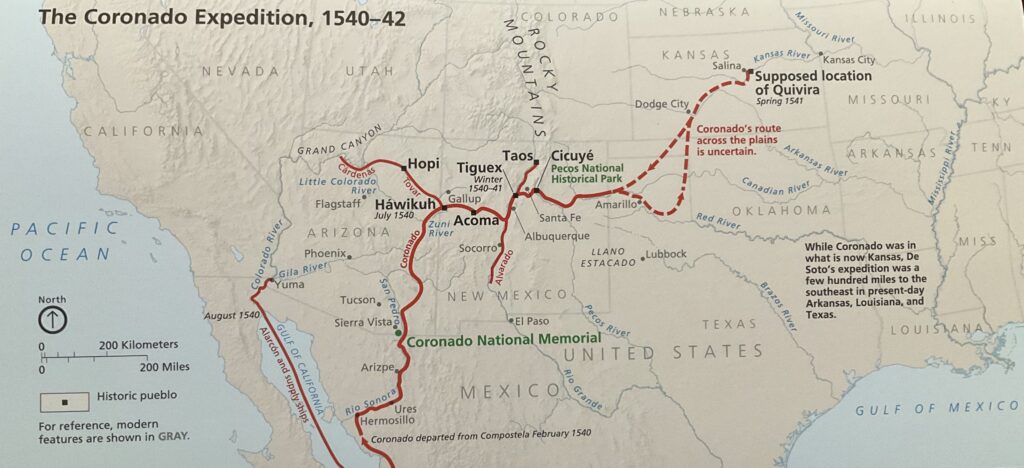
On July 7, 1540, Coronado’s group arrived at the pueblo Háwikuh—the first of the Cities of Cibola. Instead of a golden city, they found a crowded, rock-masonry village. After brief, unsuccessful negotiations the Spaniards attacked and forced the Zuni who lived there to leave. The pueblo, stocked with food, became Coronado’s headquarters until November 1540. Fray Marcos, whose tales had misleadingly raised hopes of fortune, was sent back to Mexico City amid rising resentment.
At Háwikuh Coronado sent his captains to scout the region. Don Pedro de Tovar went to Hopi villages in today’s northeastern Arizona. Garcia López de Cárdenas reached the Grand Canyon of the Colorado. Hernando de Alvarado went east past Acoma and Tiguex pueblos to Cicuyé (Pecos) pueblo on the upper Pecos River. Here, the Spaniards encountered a Plains Indian they nicknamed the Turk “because he looked like one.” The Turk astounded them with tales of a rich land to the east—Quivira—that renewed the Spaniards’ hopes of wealth. But exploration had to wait until spring. The army wintered at Tiguex, where the Indians, at first friendly, grew hostile over the Spaniards’ violations of hospitality and friendship. Battles followed; the Spaniards killed residents of one pueblo and forced others to abandon several pueblos.
On April 23, 1541, the army, guided by the Turk, set out for Quivira. After 40 days Coronado sent most of the men back to Tiguex then pressed on with 30 others. At Quivira they were again disillusioned-the villages were grass houses. After admitting the Quivira story was a Pueblo Indian plot to lure them onto the plains to die of starvation, the Turk was killed. Dreams of fame and fortune shattered, Coronado returned to Mexico City in spring 1542. Though discredited, he resumed governorship of New Galicia. He was called to account for his cruelty toward the American Indians during the expedition, but his name was eventually cleared. He died in 1554 at age 42. Rather than gold, the expedition brought back knowledge of the northern lands and its peoples and put further colonization within reach.
Title: Birds of a Feather
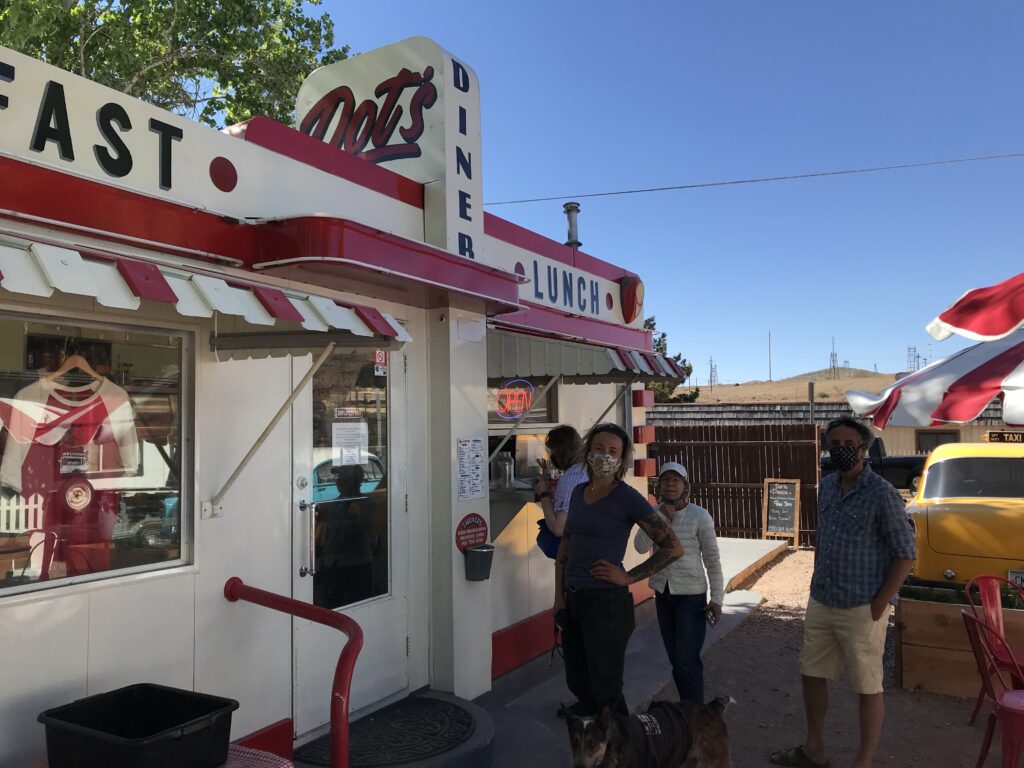
In the land of Arizona’s red, Frankie and Johnny set off on a spree, To visit their cousin, John Quill, in Old Bisbee, Before the Van Life event, they were to see.
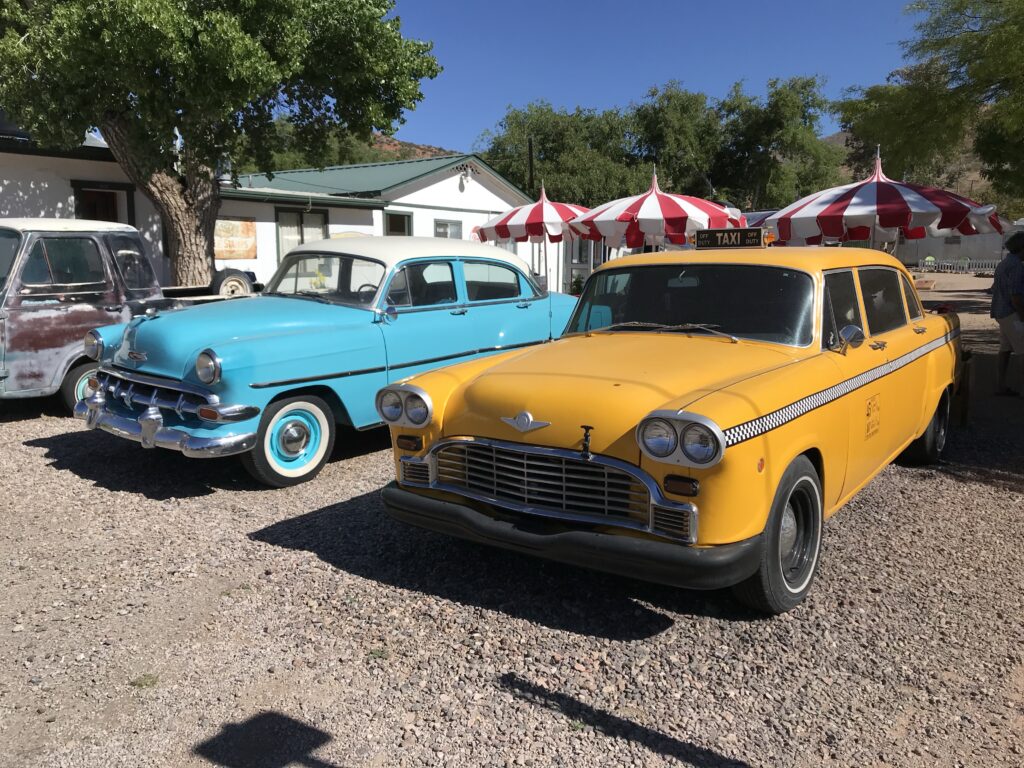
First cousin once removed, they say, A bond that’s not so far away, A shared history, a common thread,
A connection that’s not easily dead.
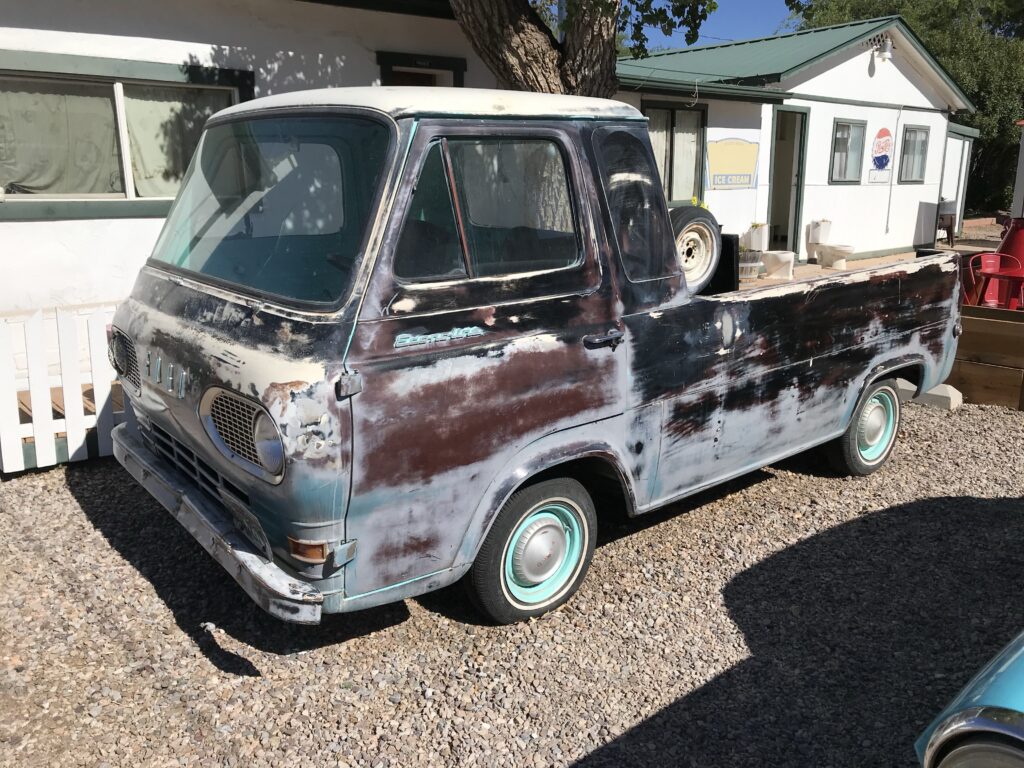
They toured Old Bisbee, its charm so grand, The miners’ houses, the history at hand, Brewery Gulch, the Copper Queen Hotel, The stories of the past, they’d surely tell.
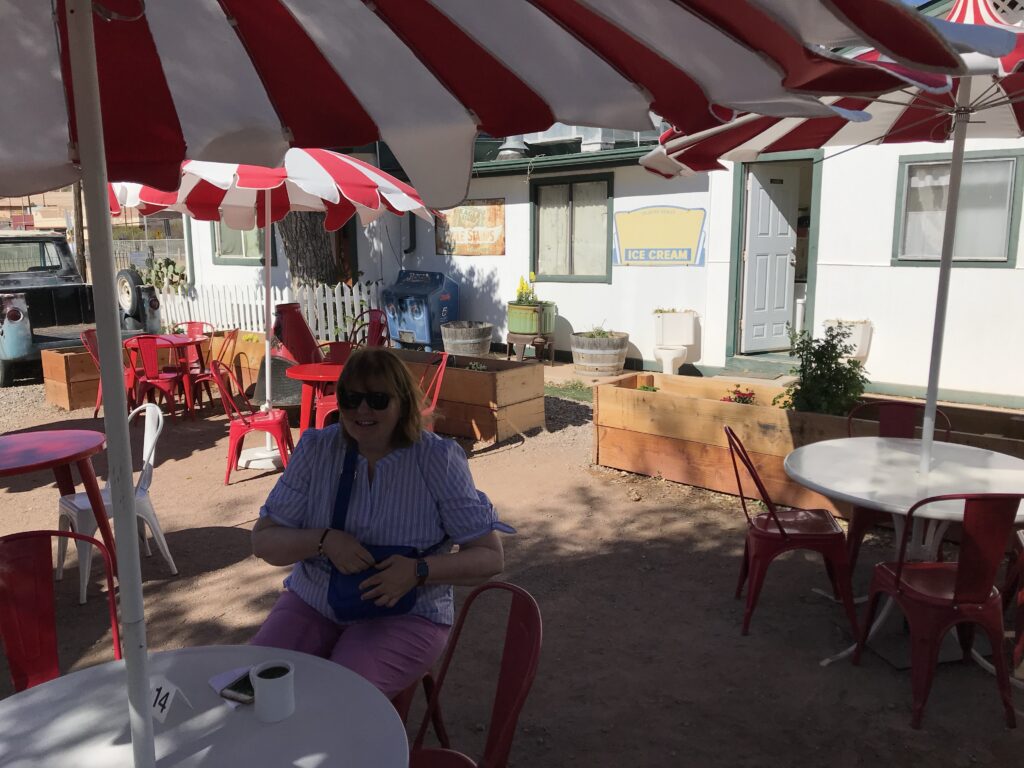
Next, they ventured to Lowell, a place of pride,
Where the miners’ lives were once their guide, The history of the town, a tale to be told, A piece of the past, forever to be old.
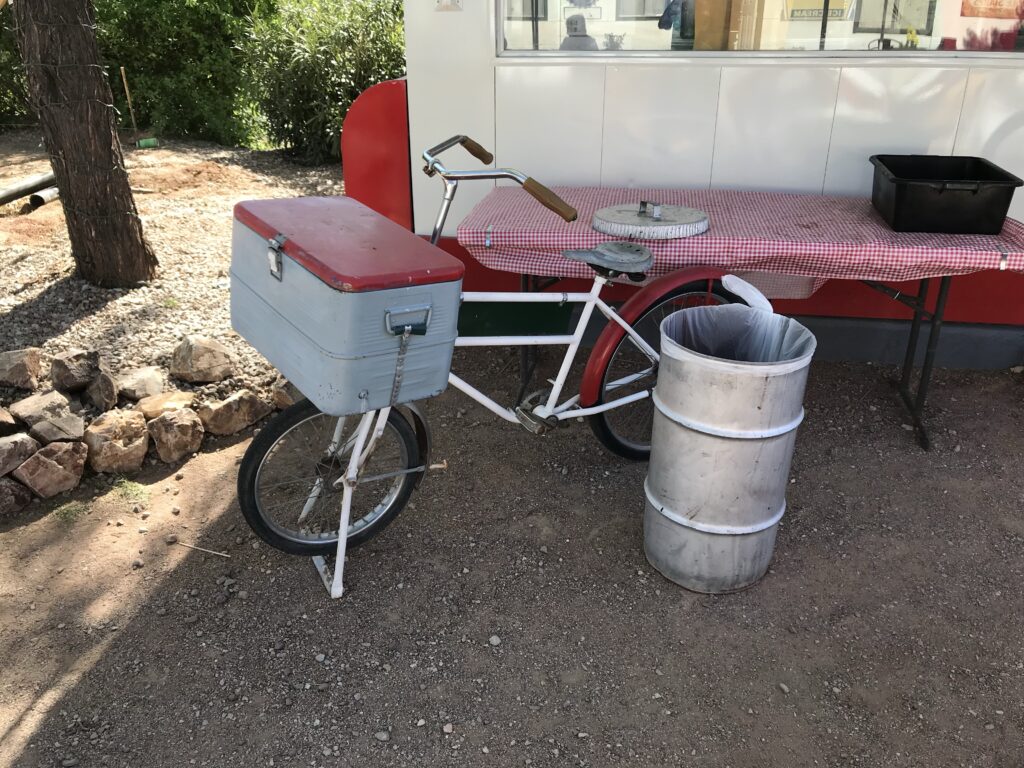
Coronado National Memorial, a sight to behold,
A place of beauty, a story untold, The mountains and the desert, a stark contrast, A reminder of nature’s grandiose vast.
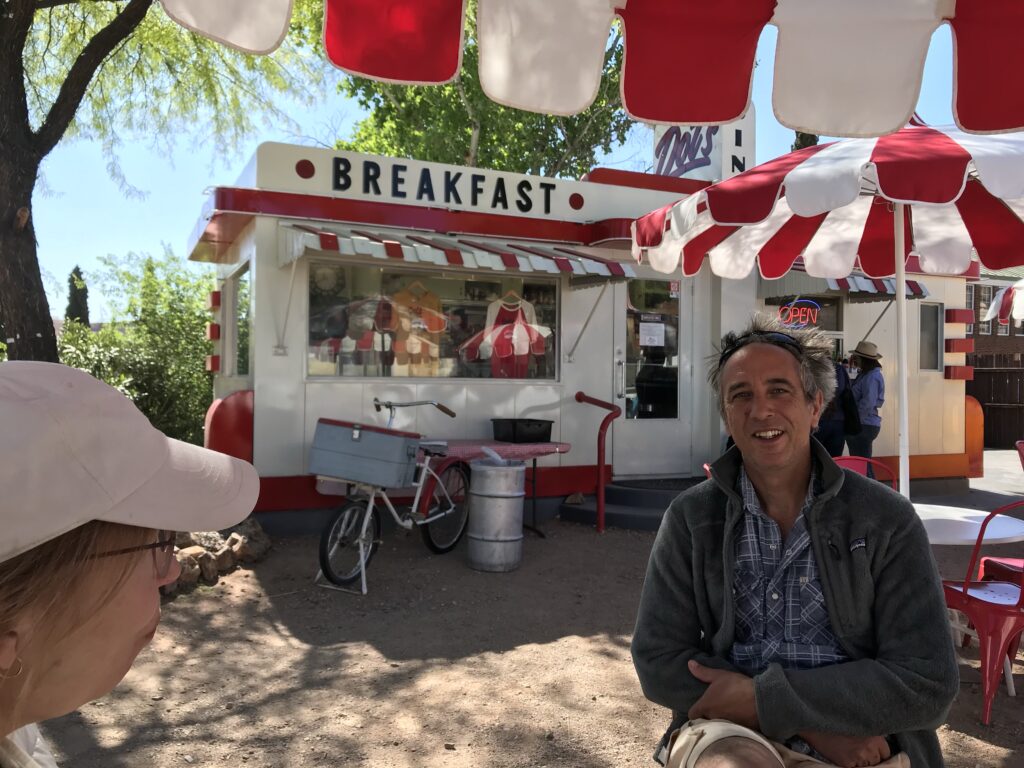
Finally, they reached Warren, a place of design,
The Arts and Crafts style, a sight divine,
The Vista, the ballpark, a gem to find,
A planned community, a place of mind.
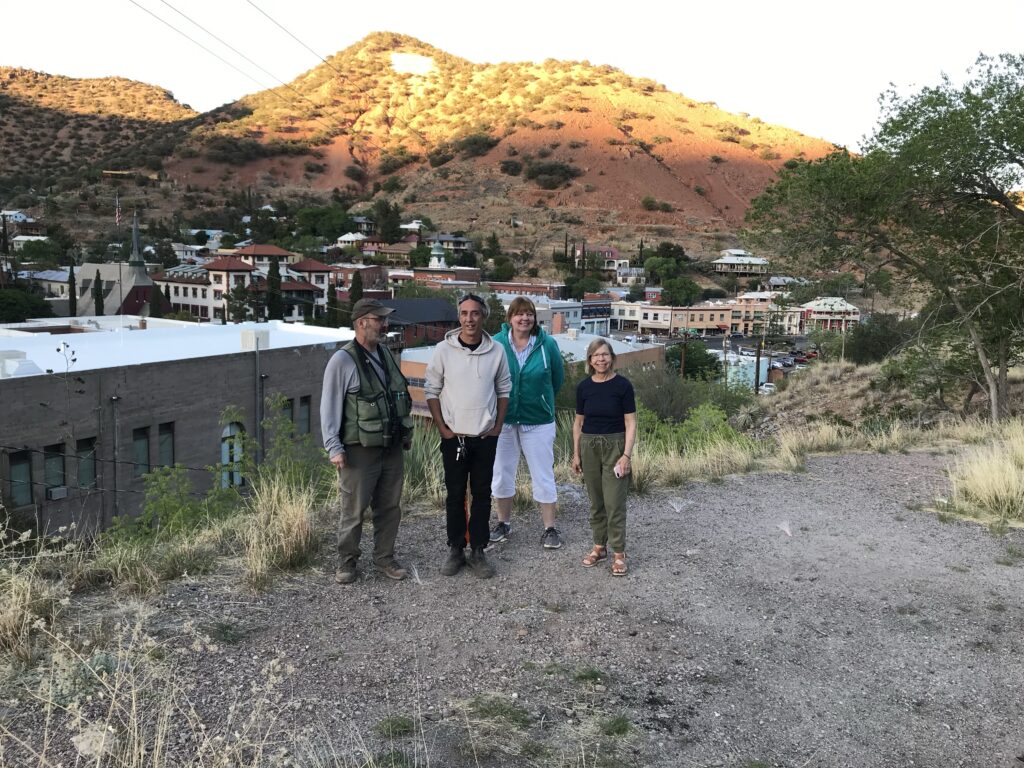
Frankie and Johnny, their adventure complete, Planned future visits, their hearts to beat,
With their cousin John Quill, a bond to keep, Birds of a feather, their journey to sweep.
